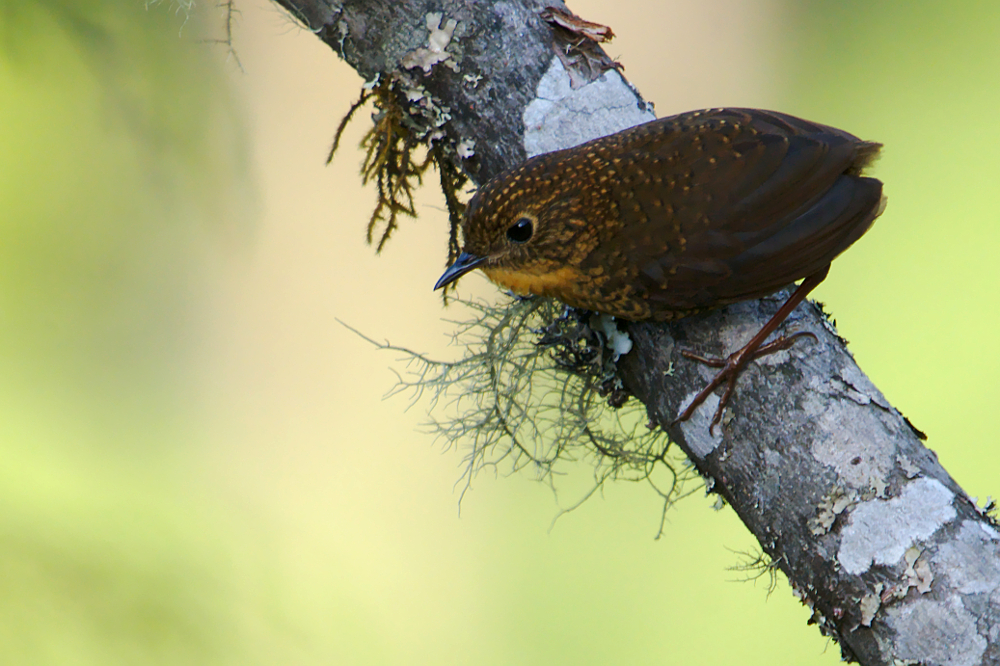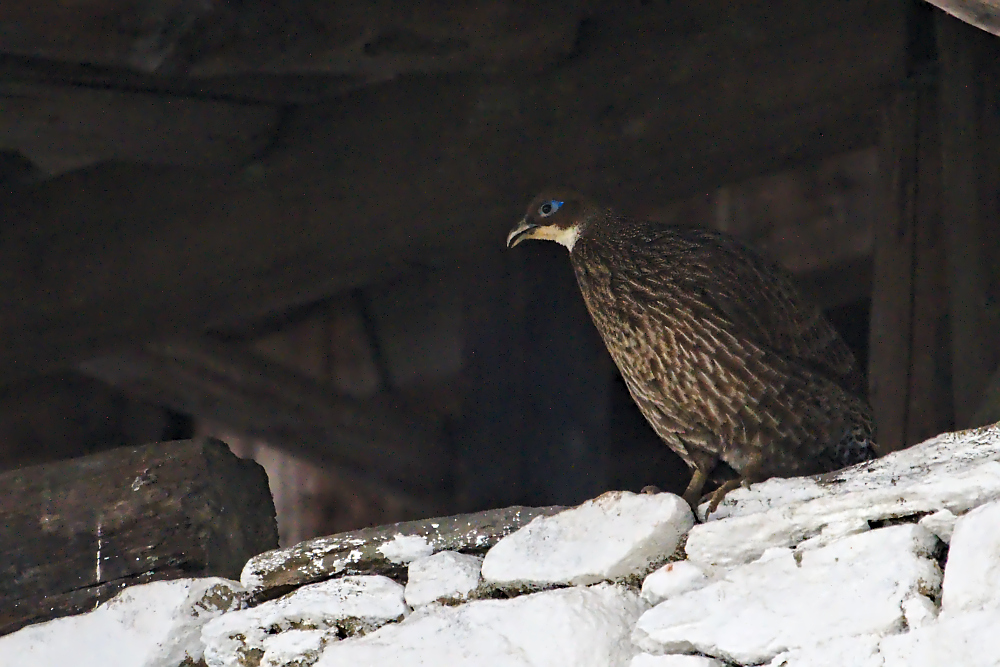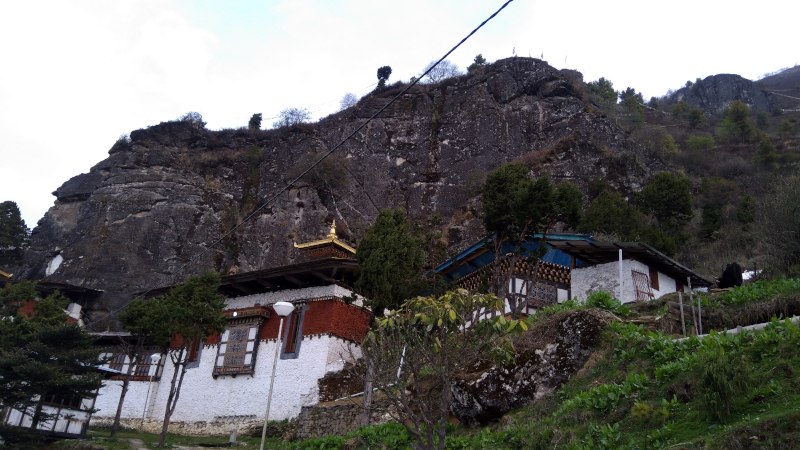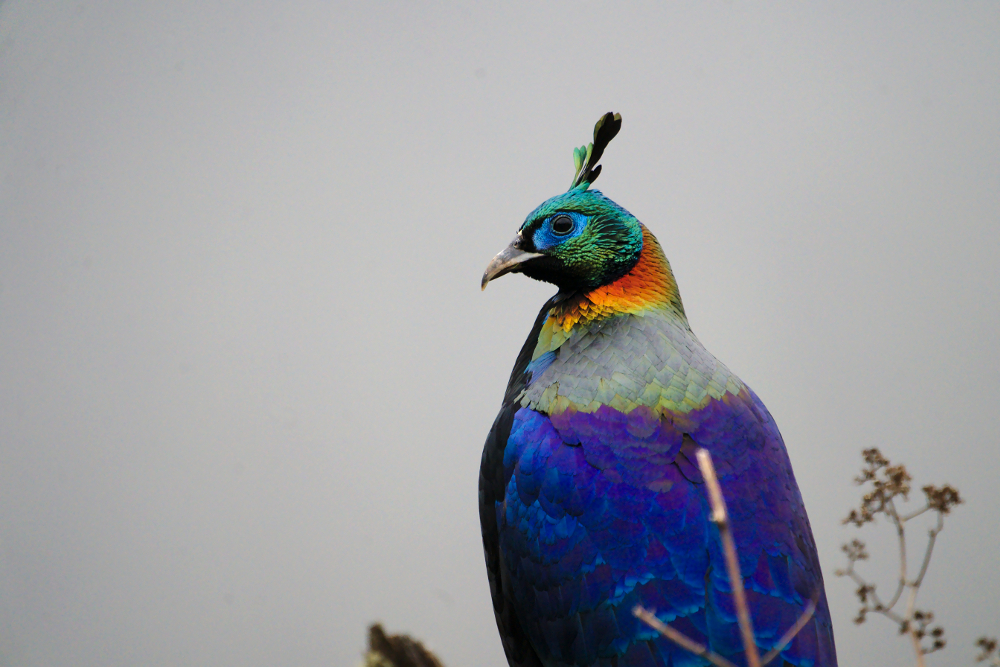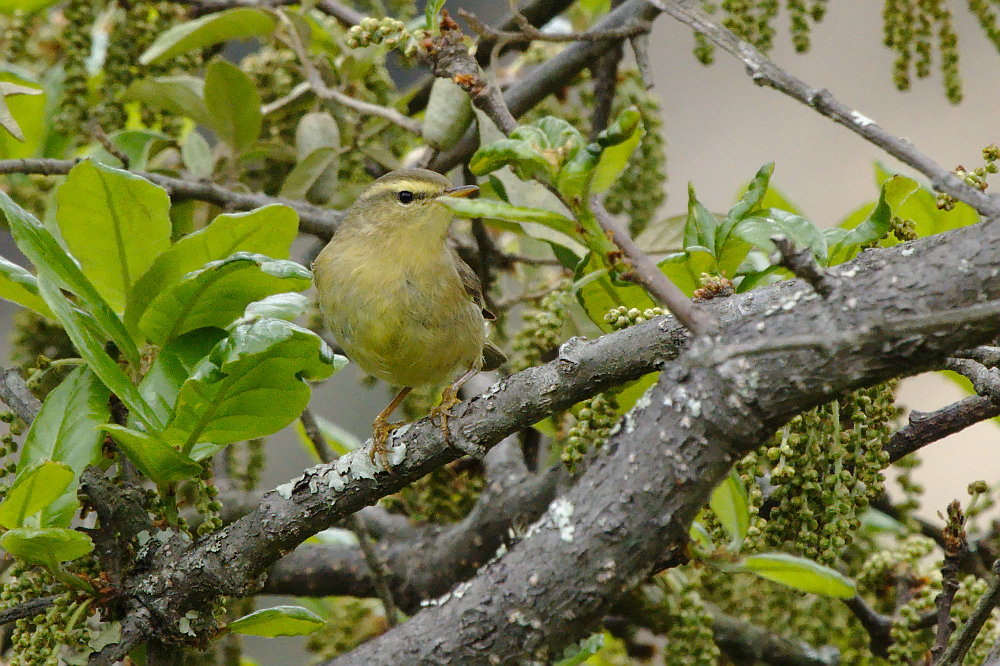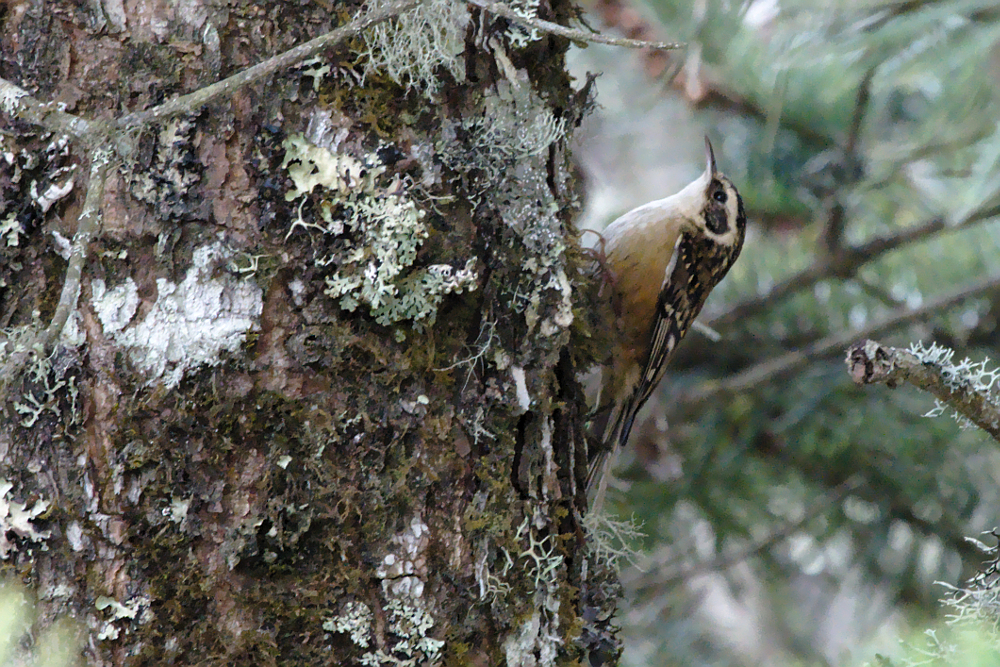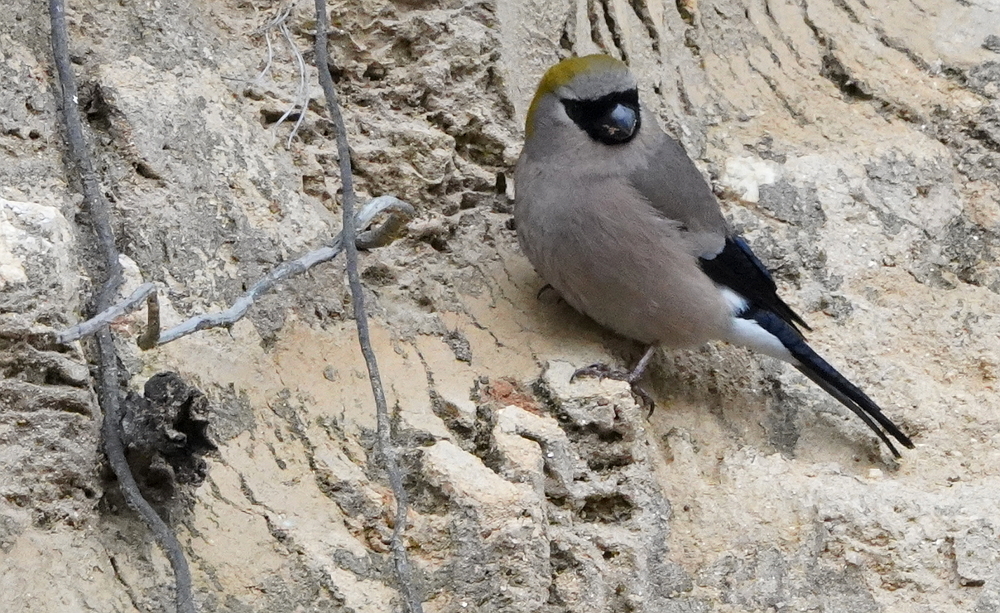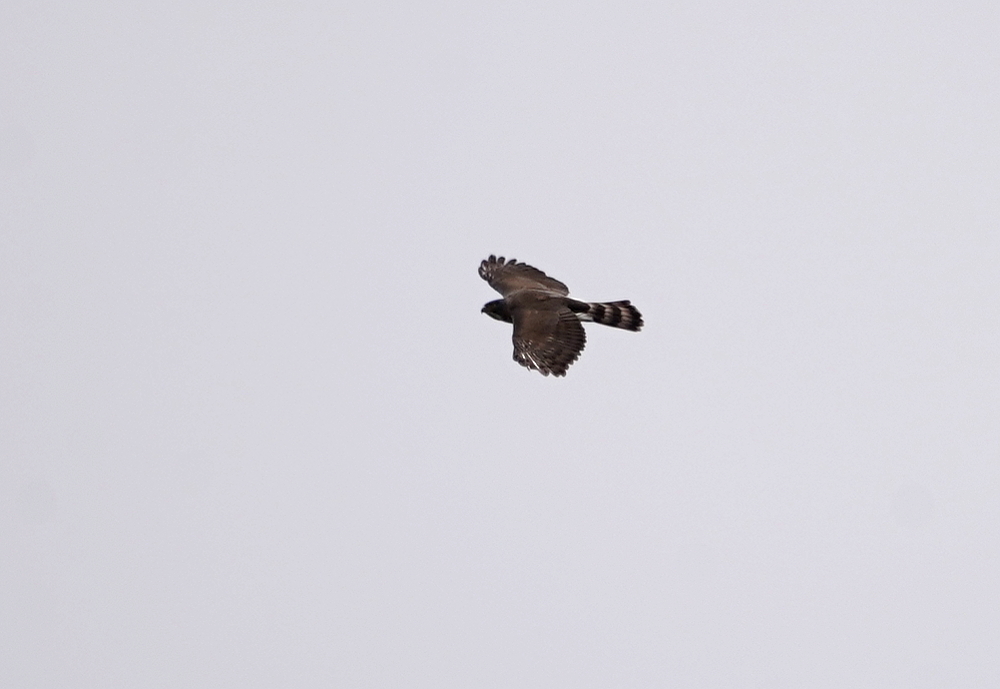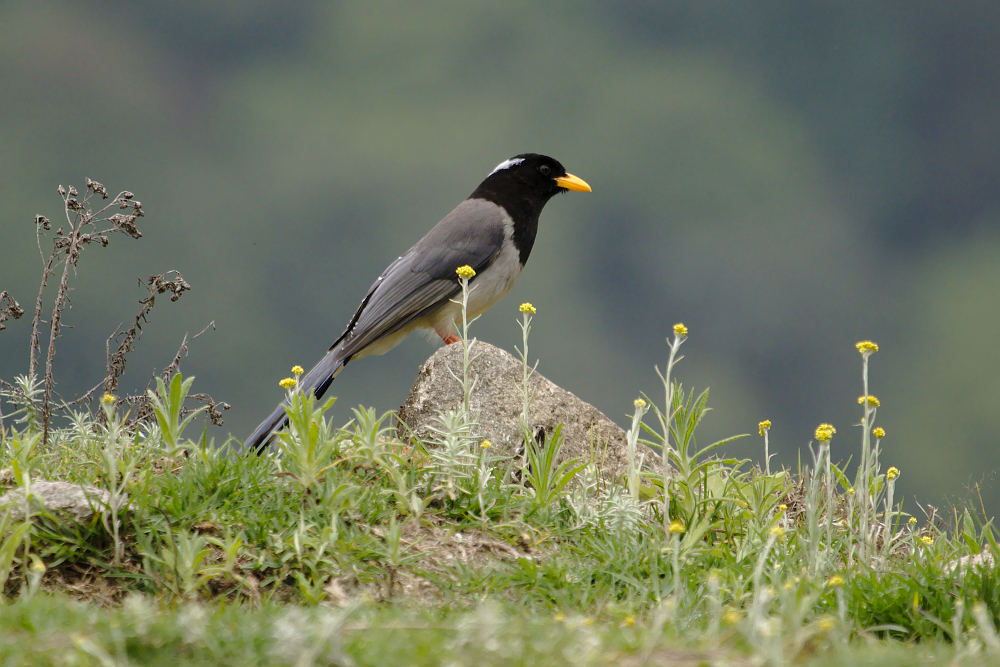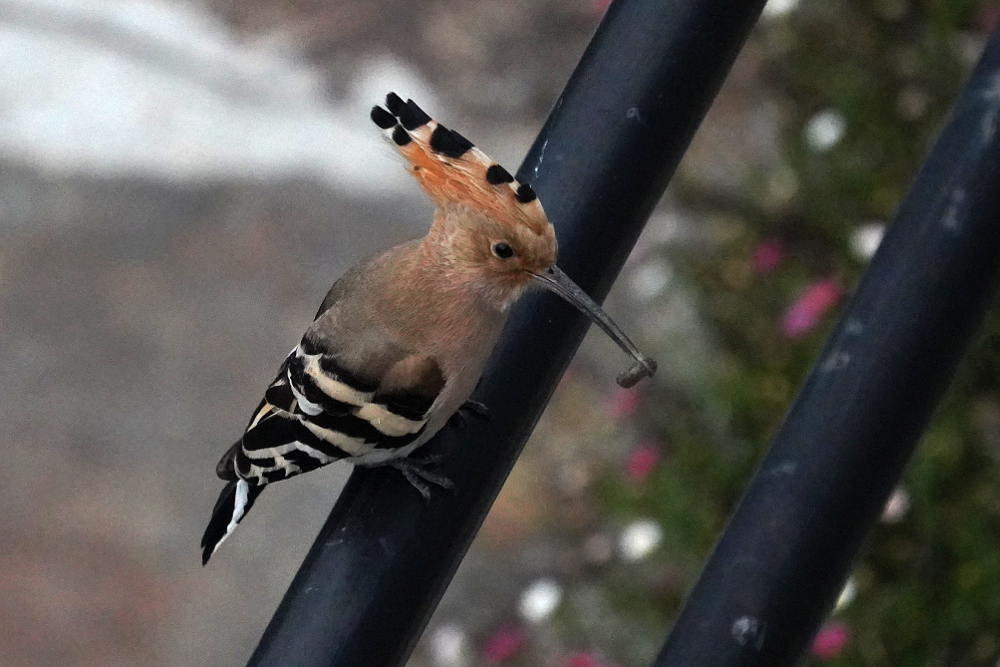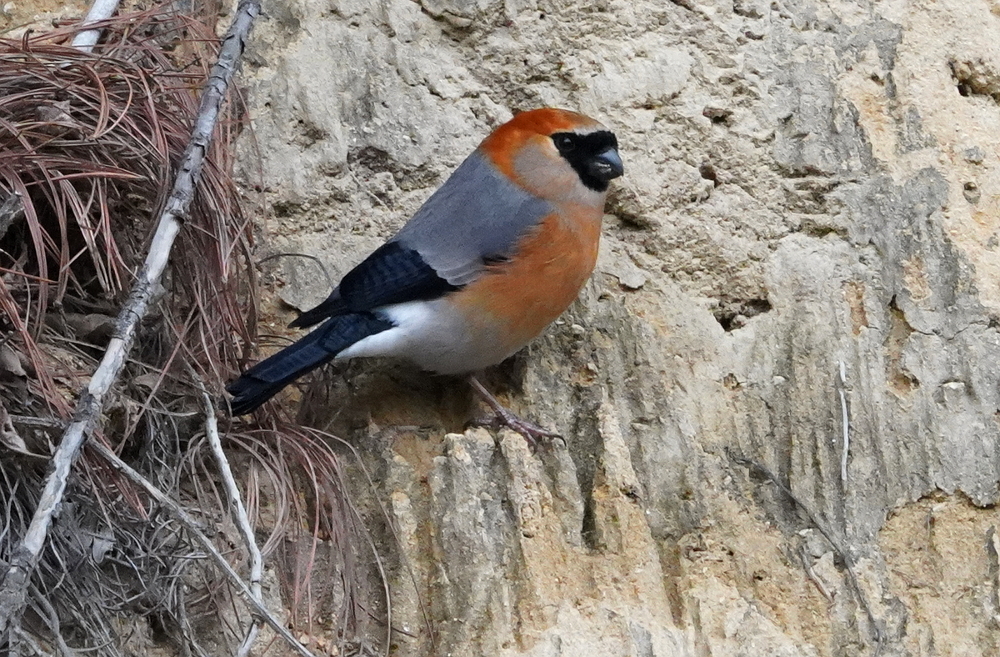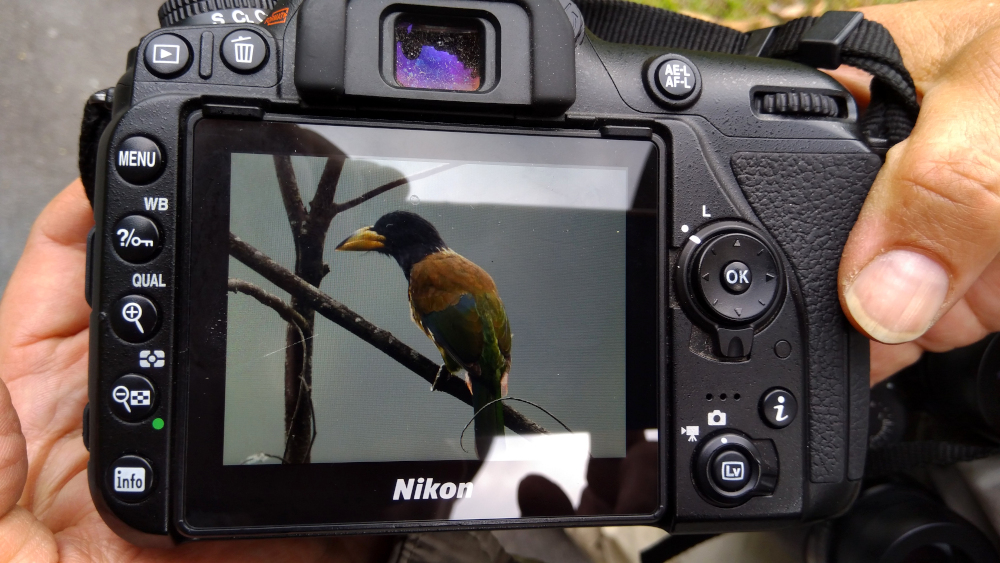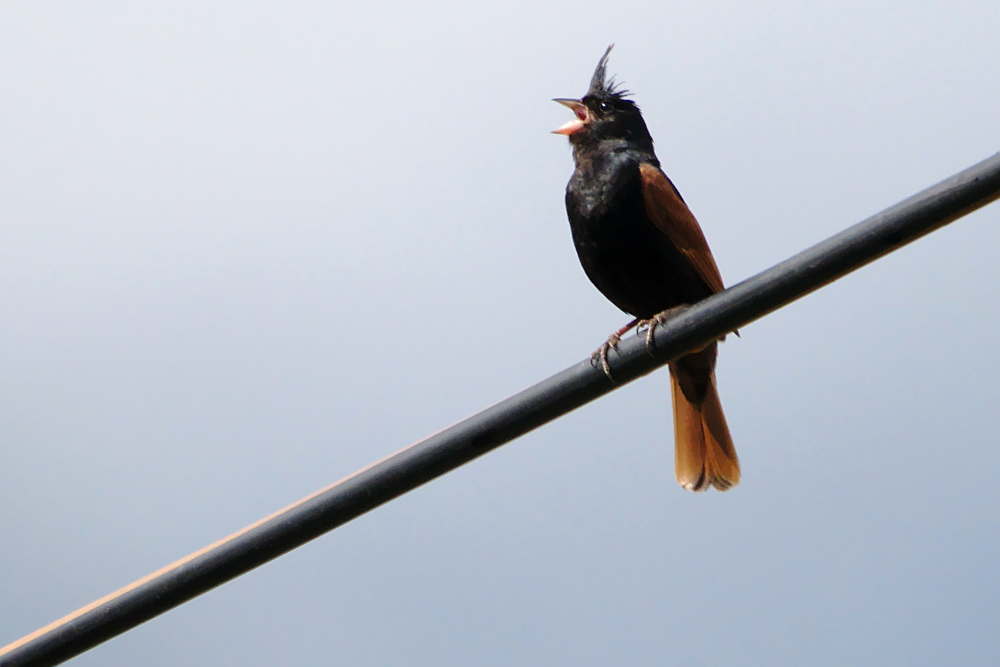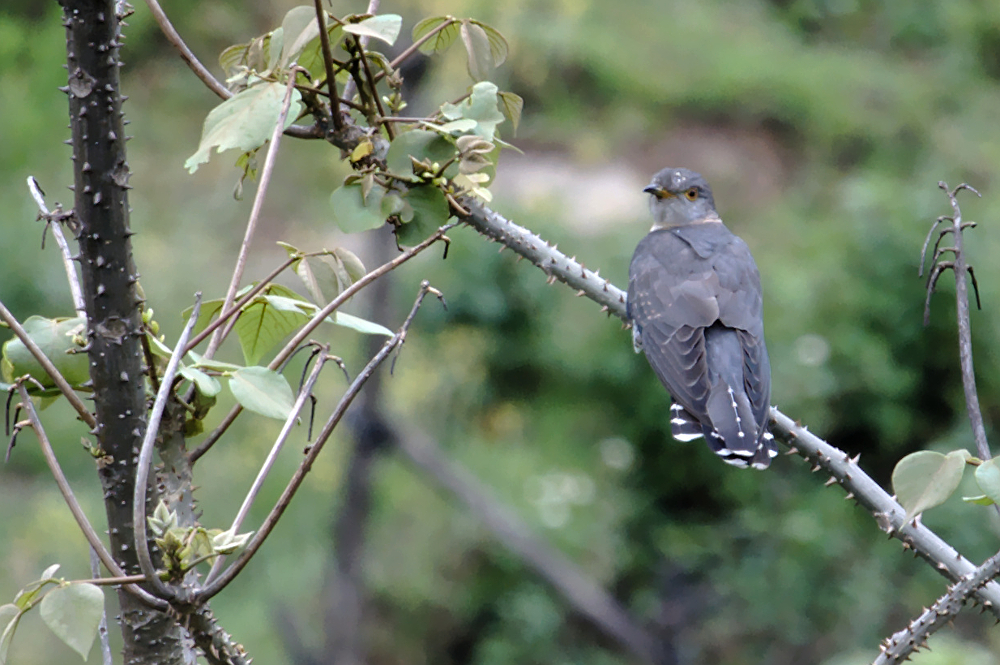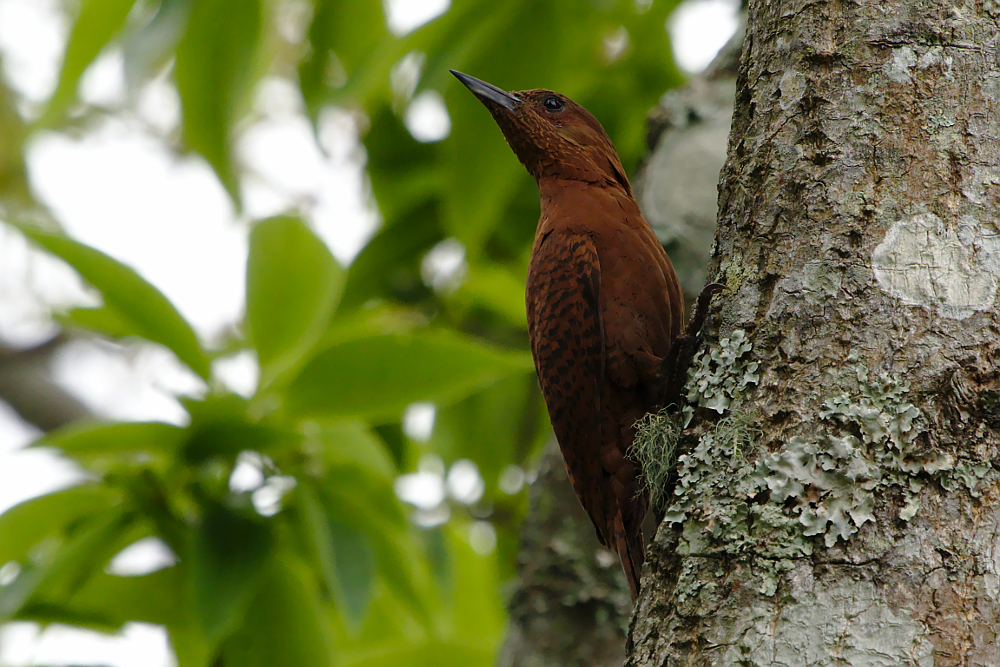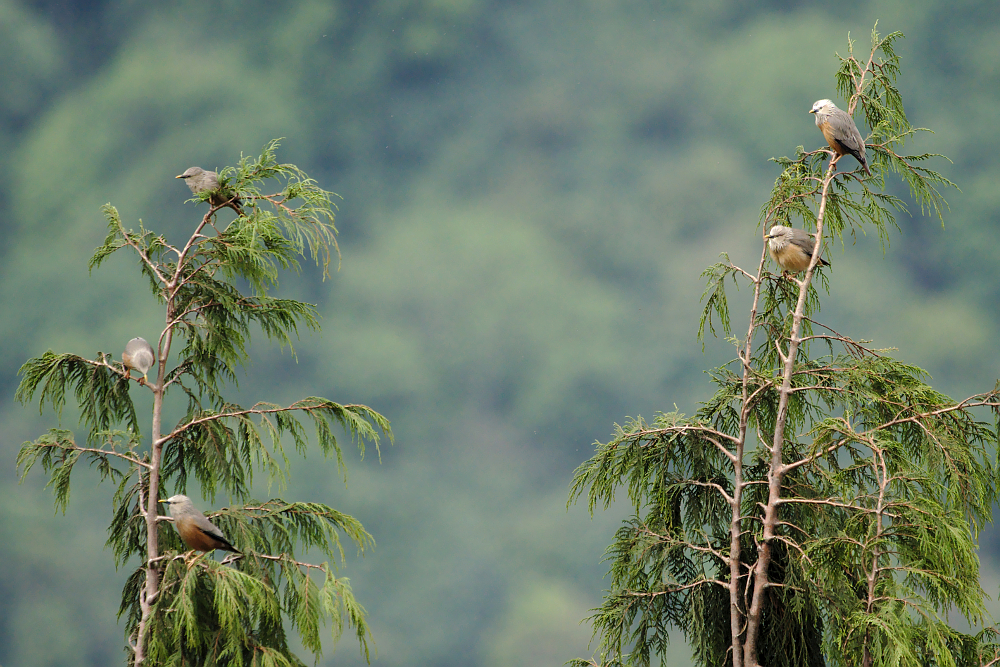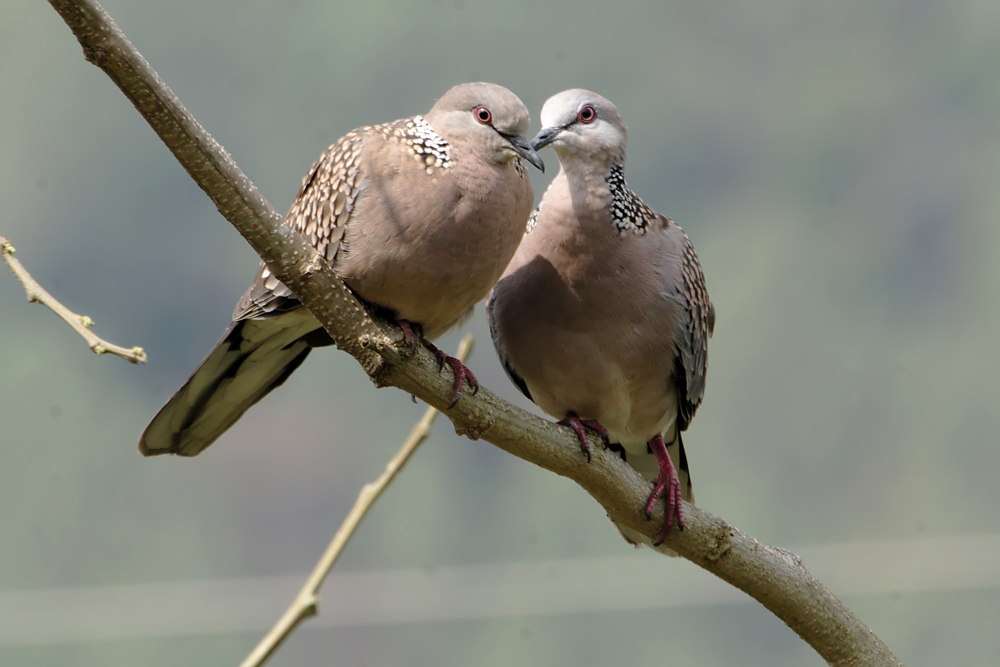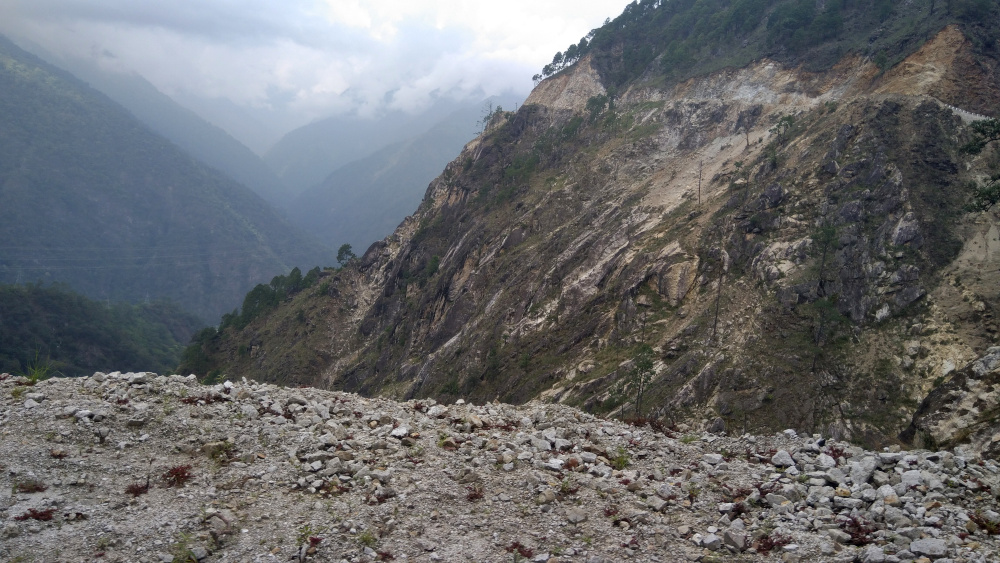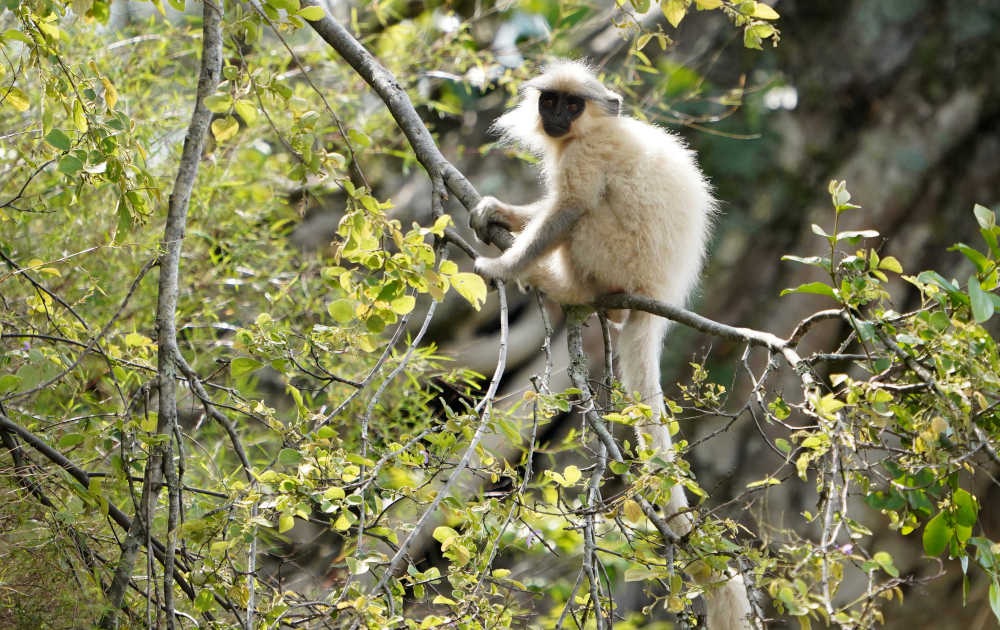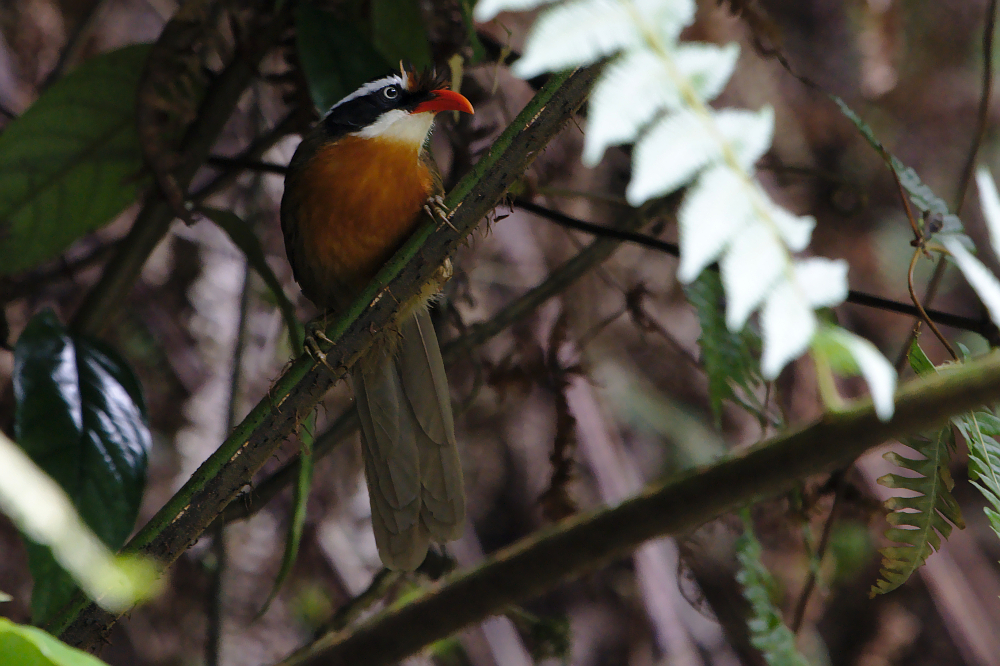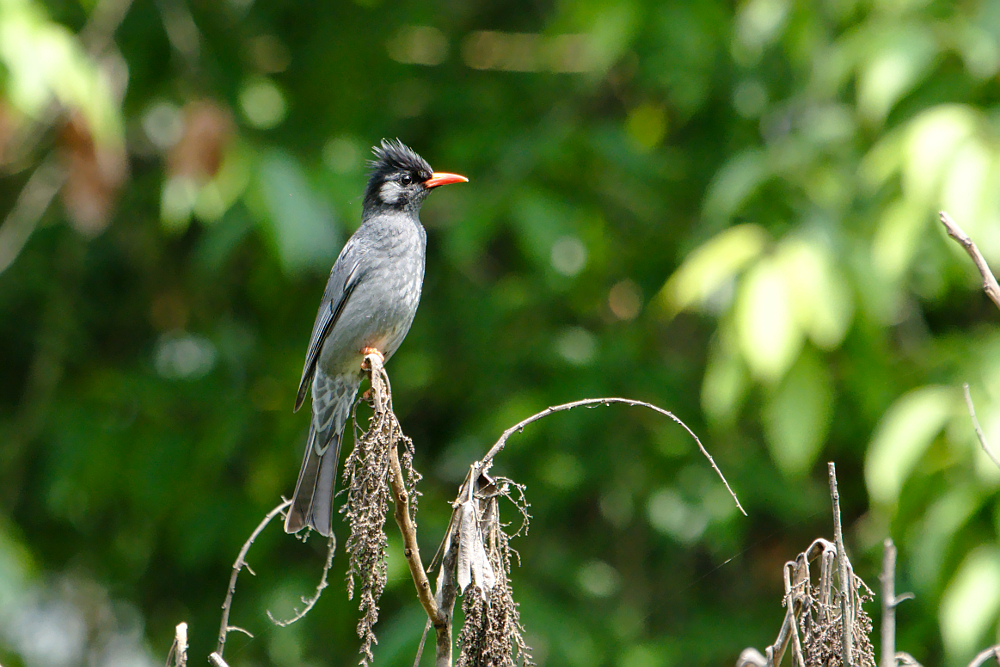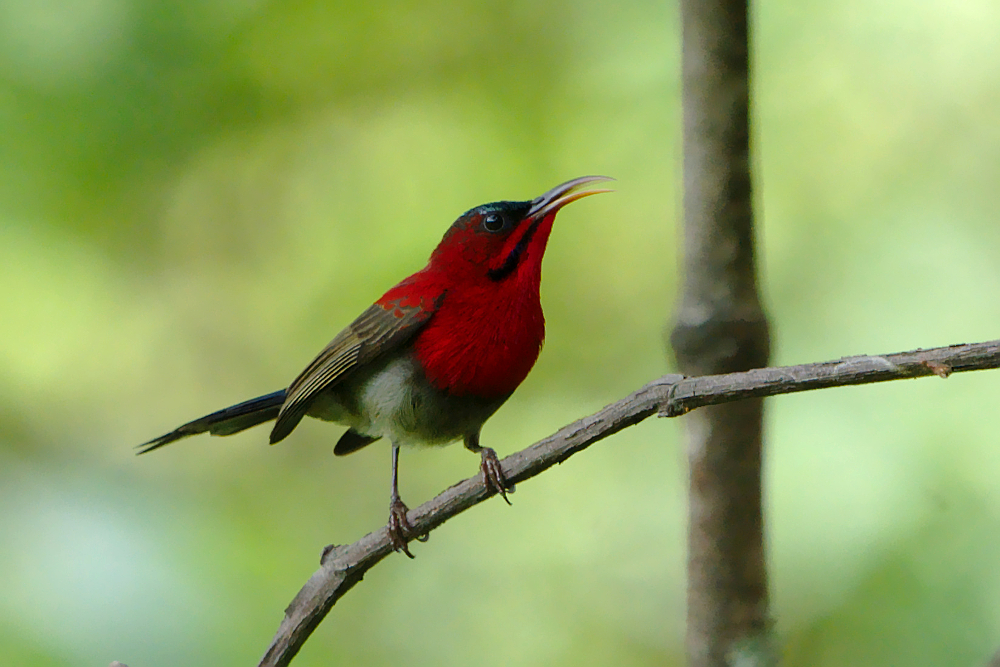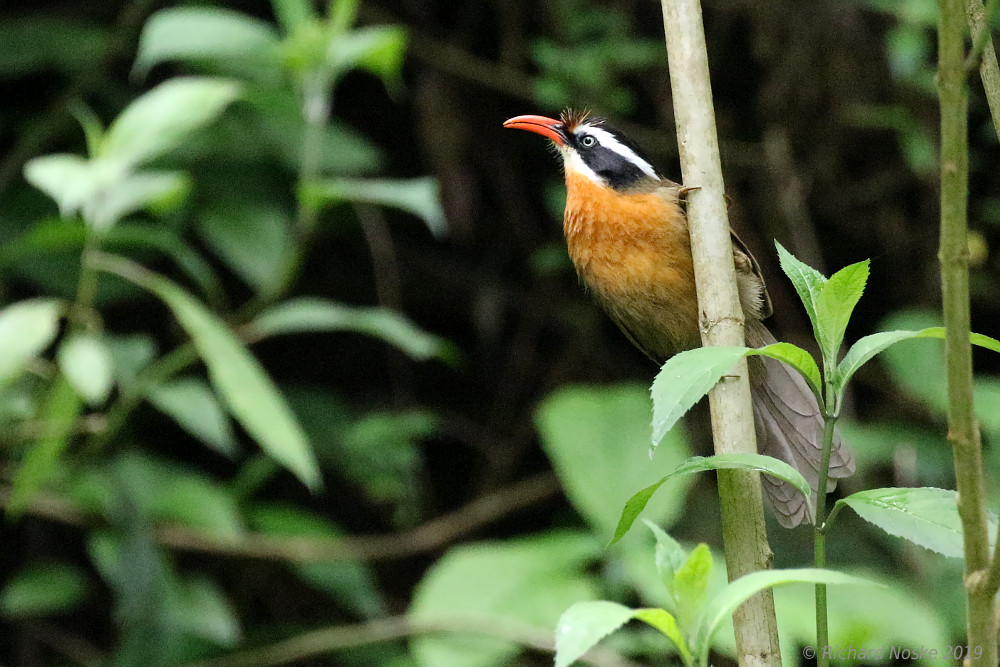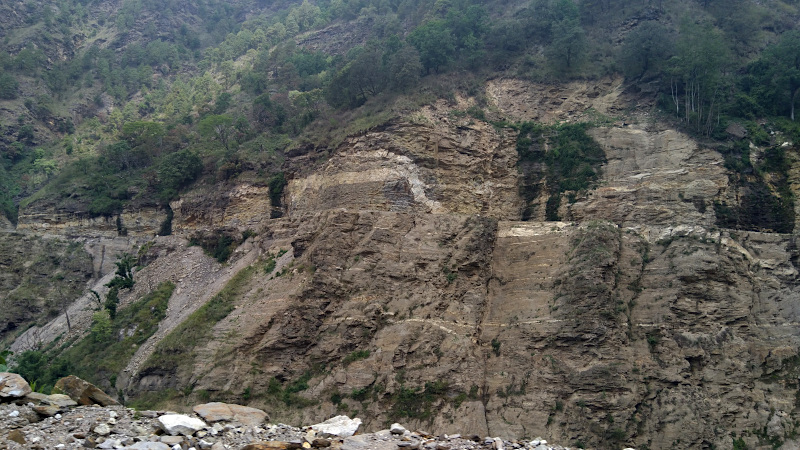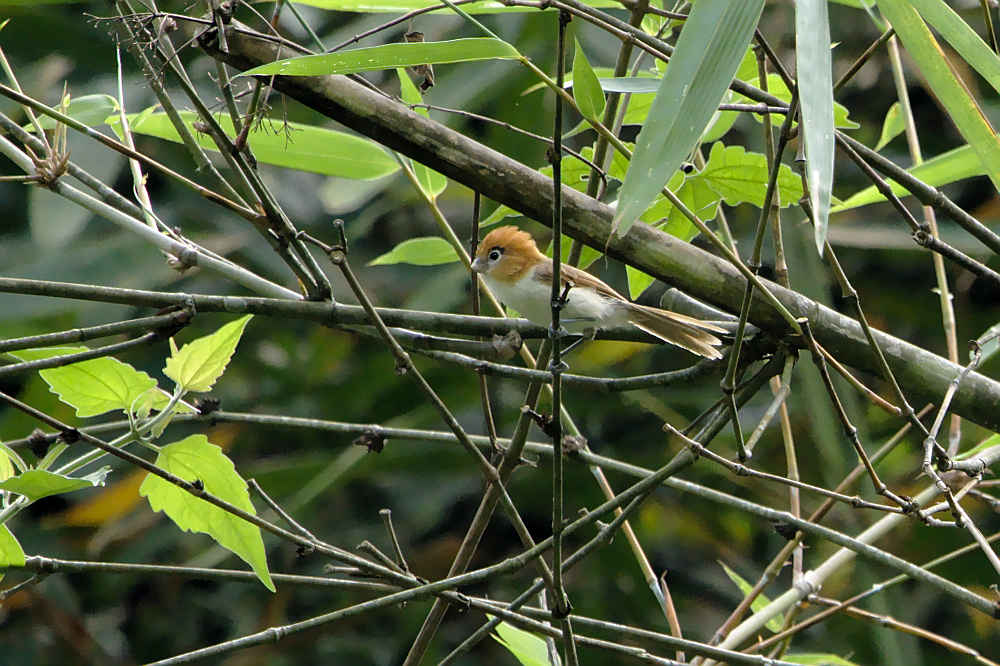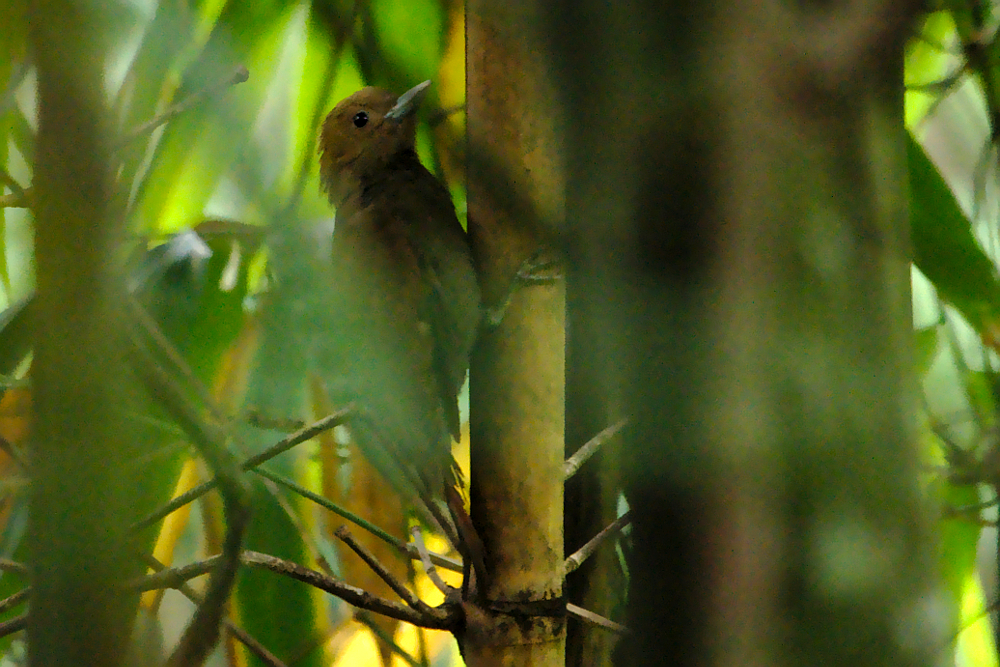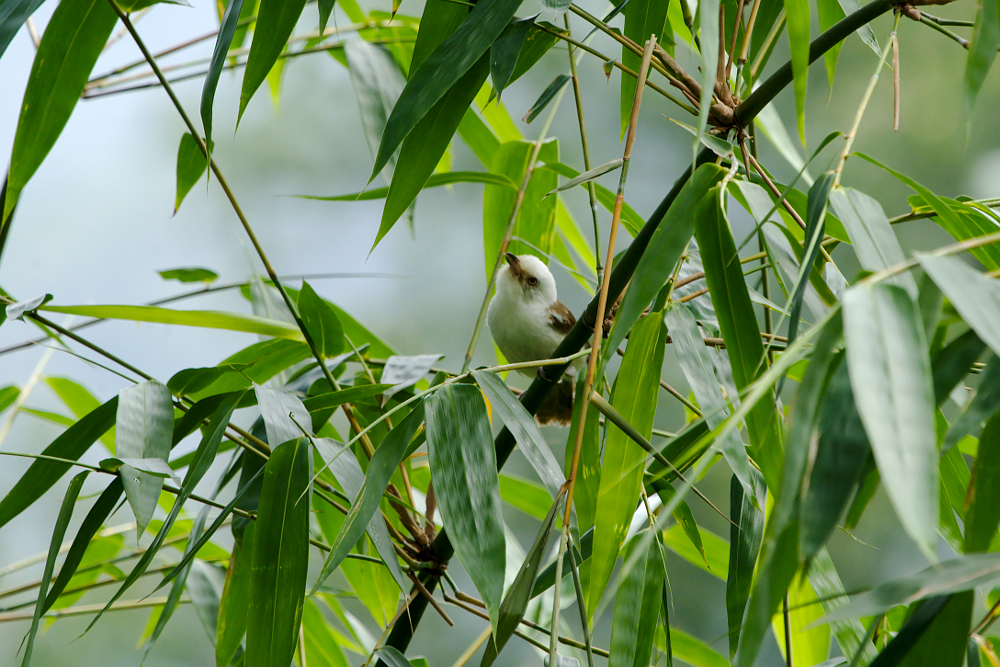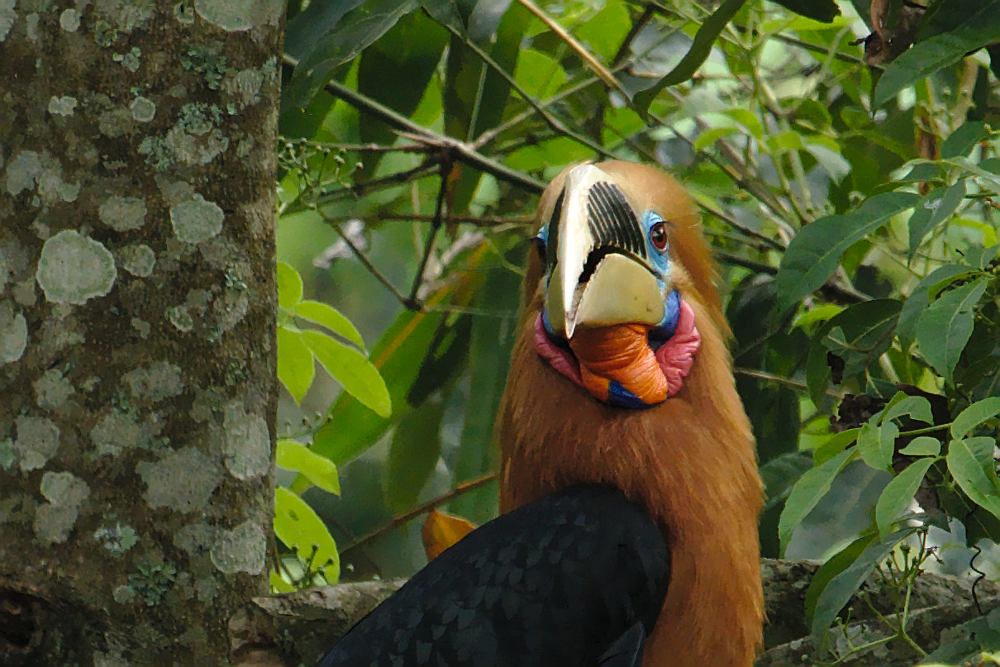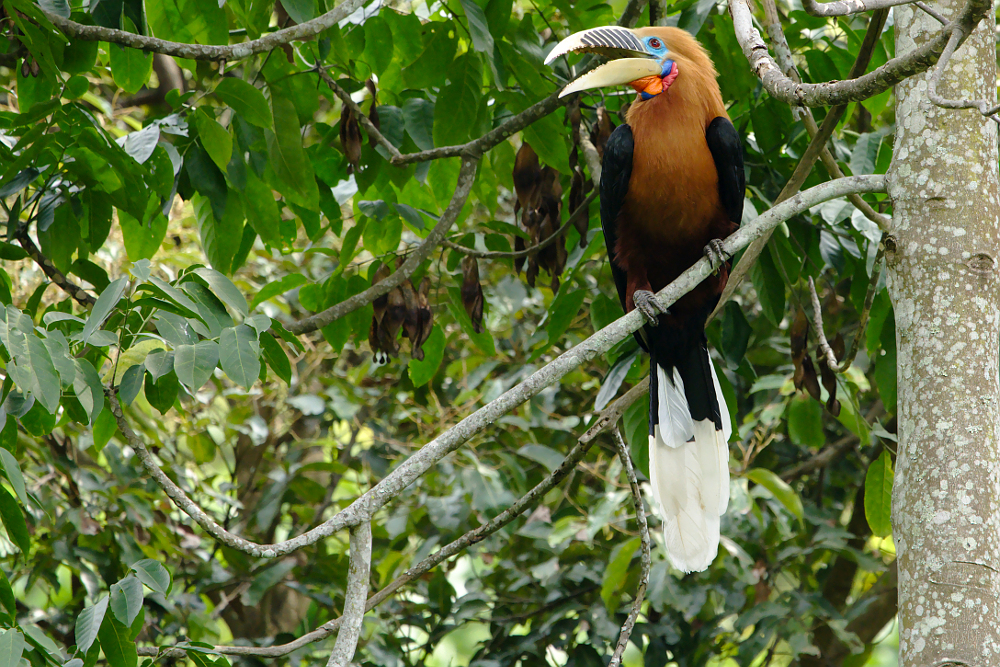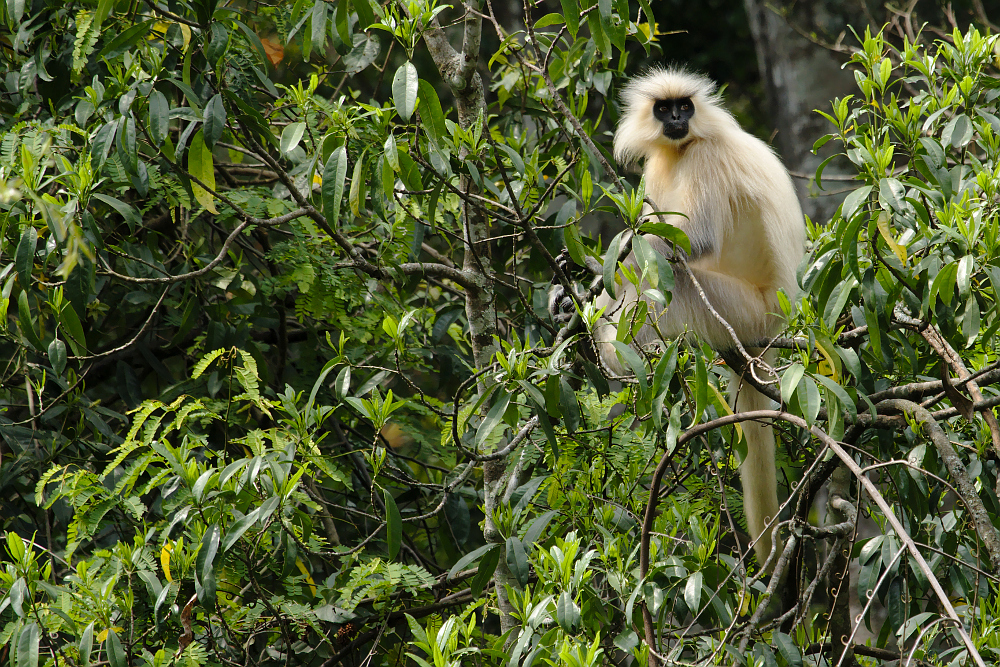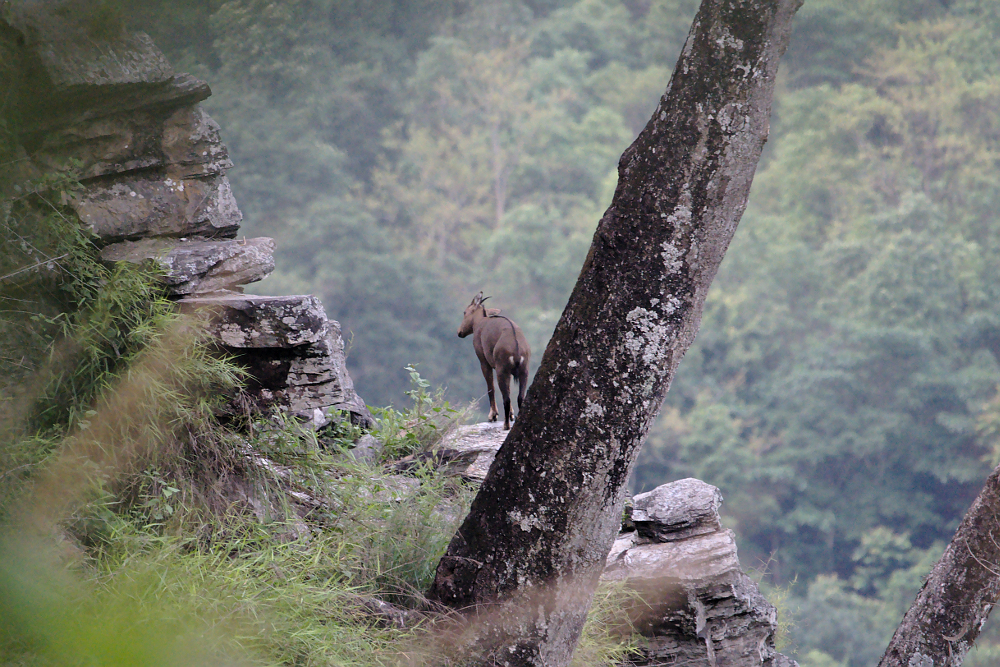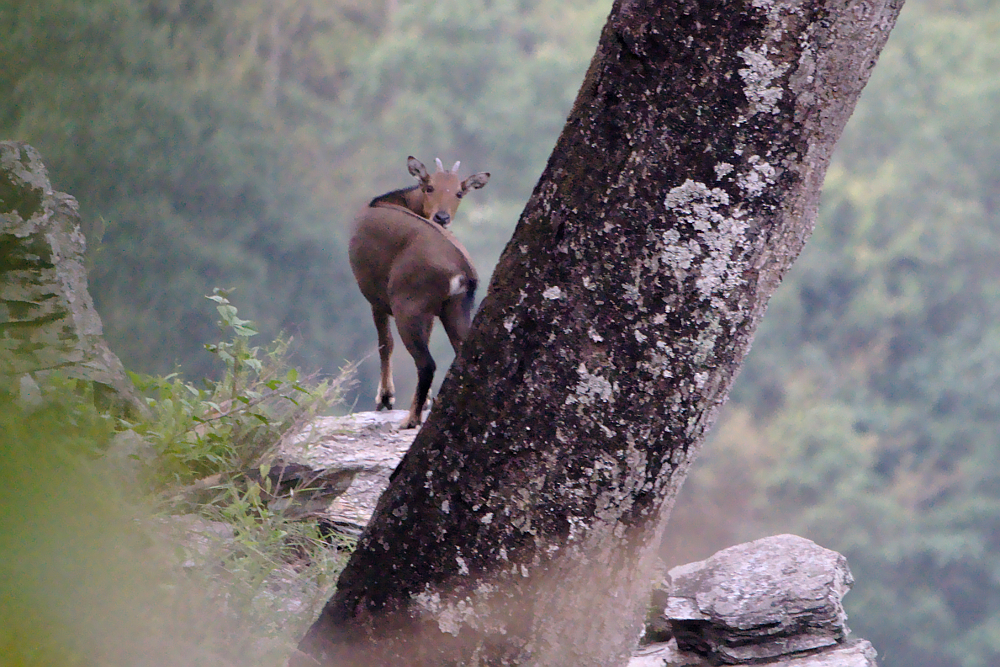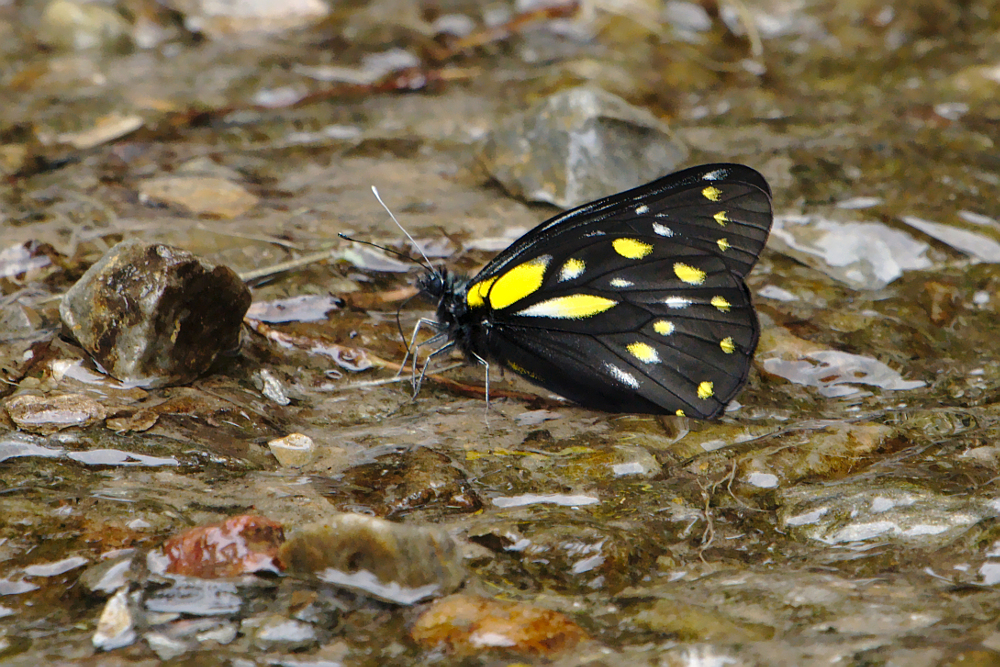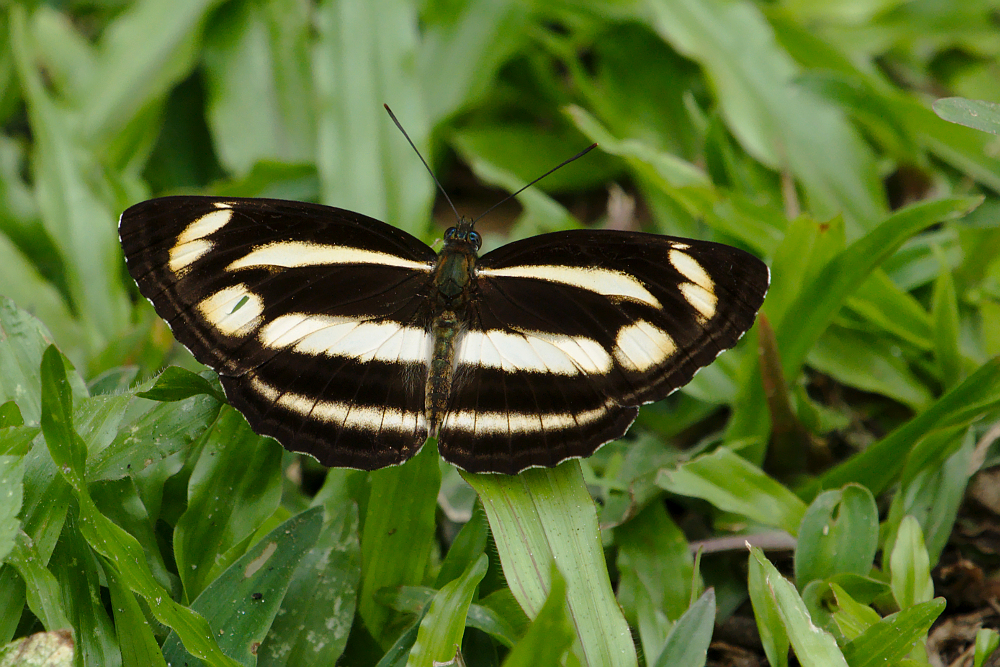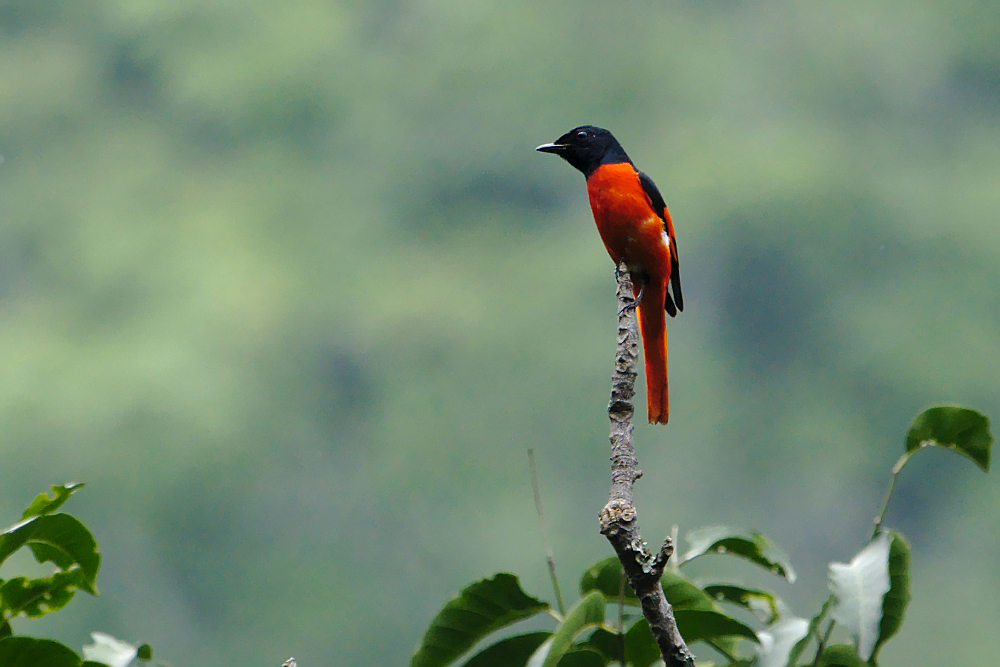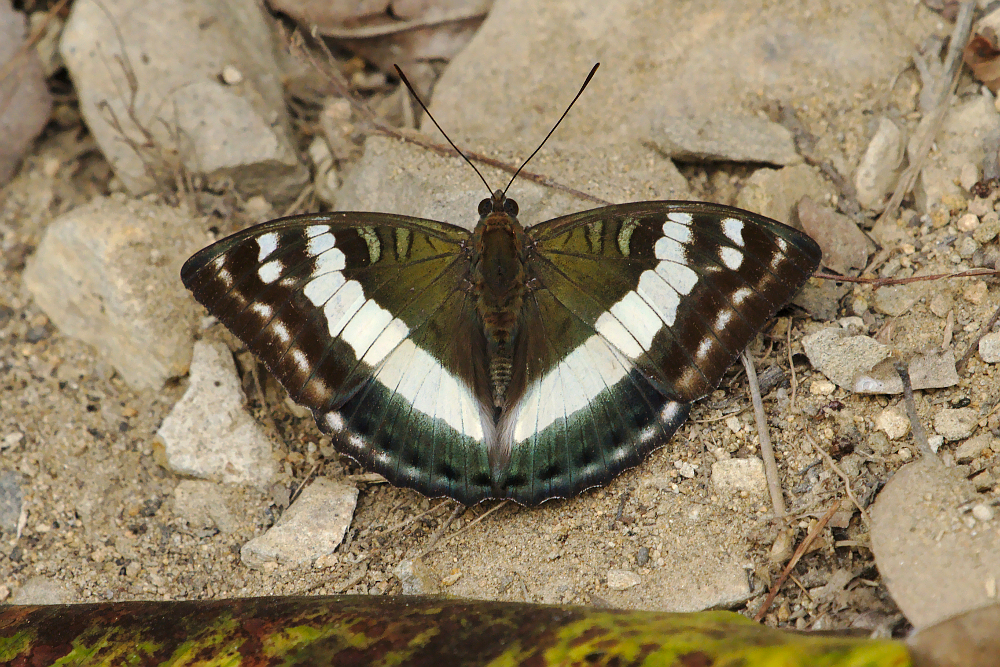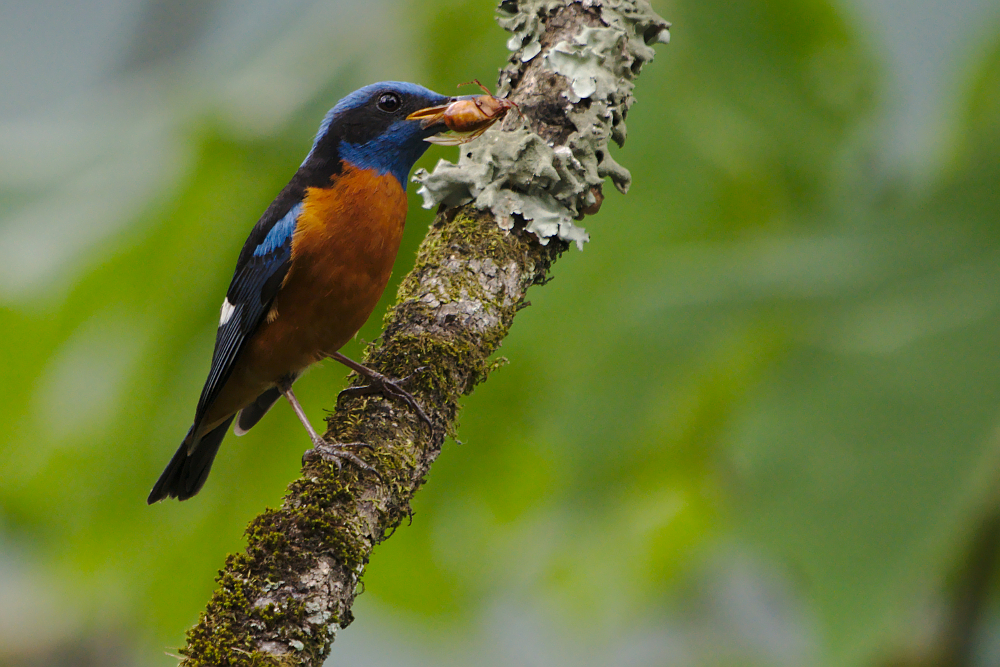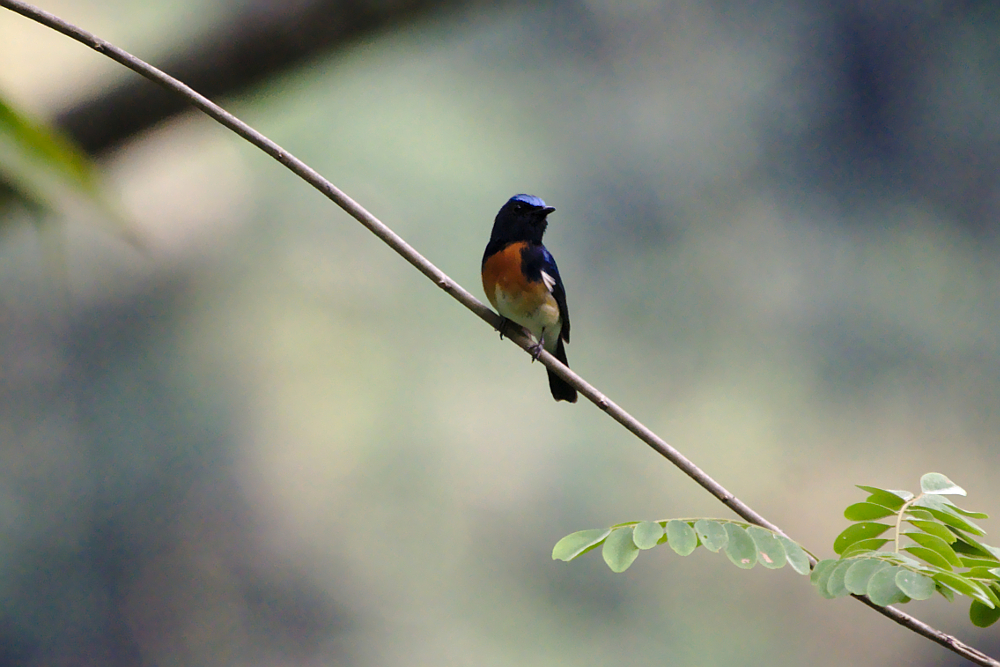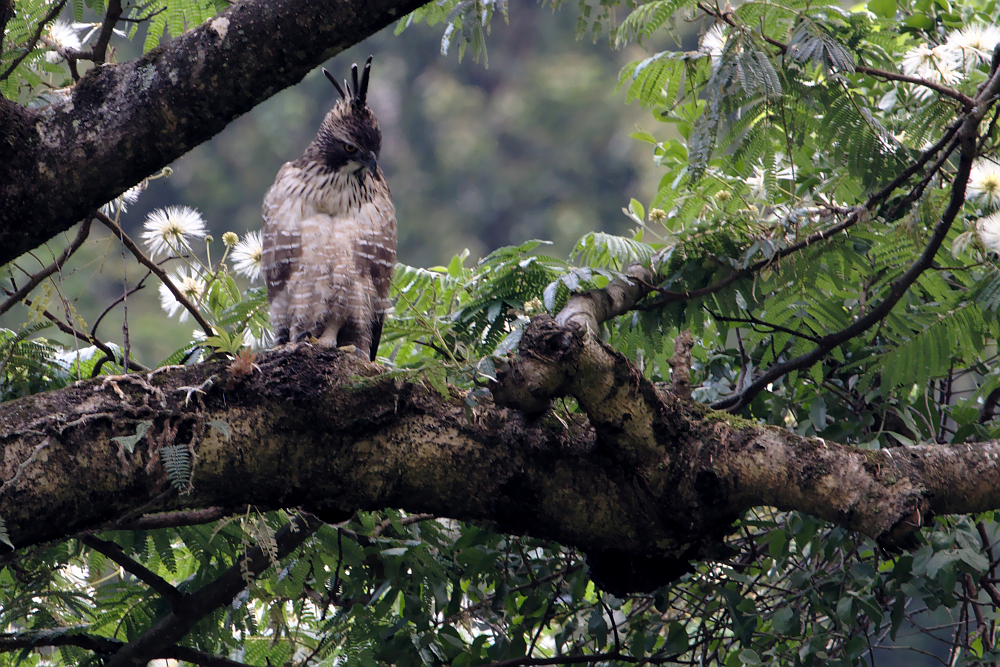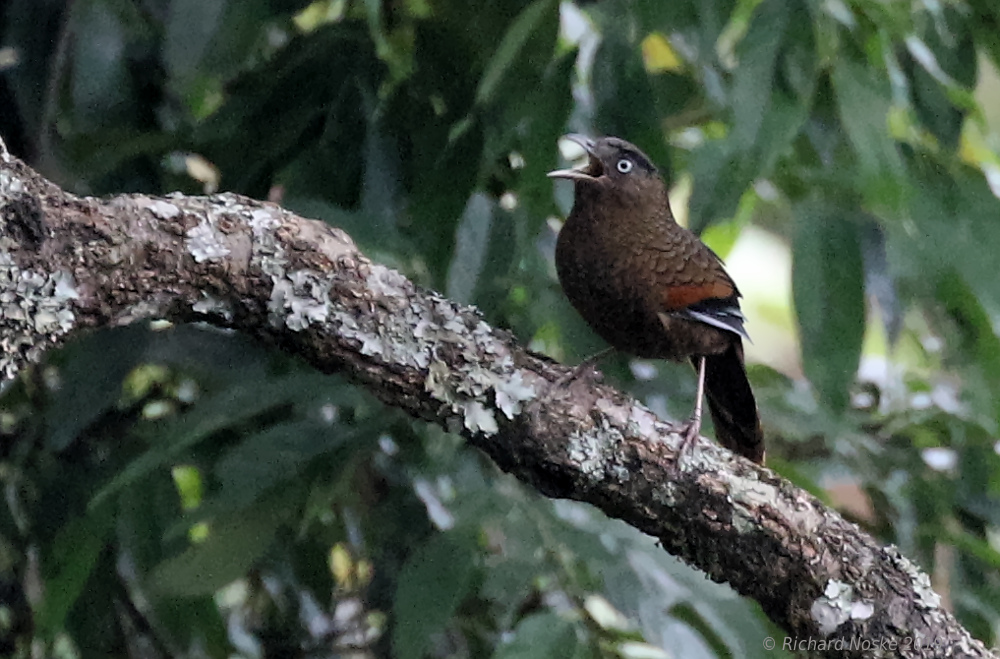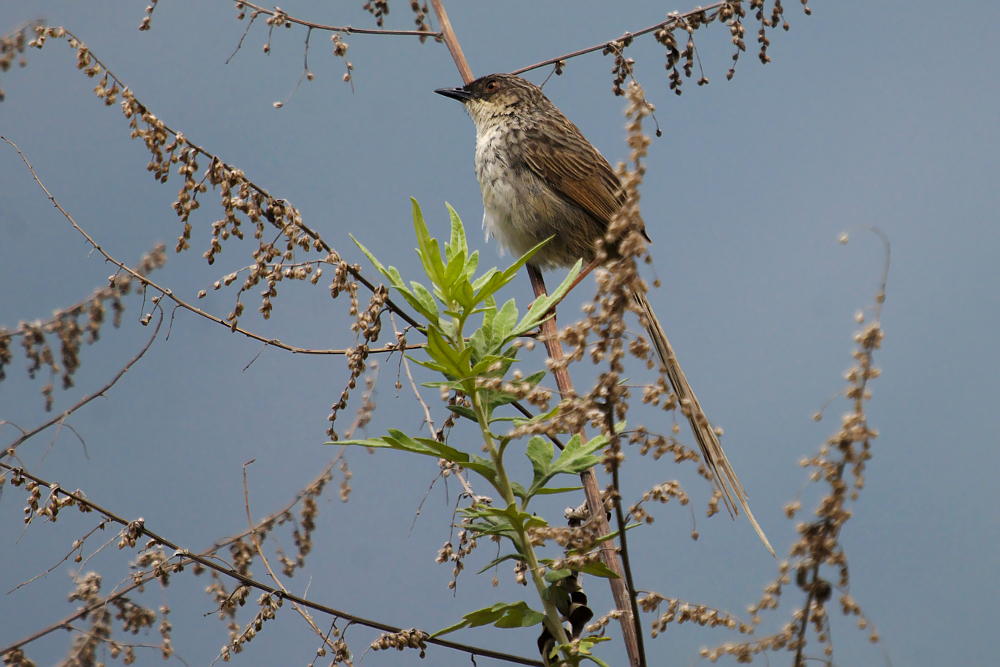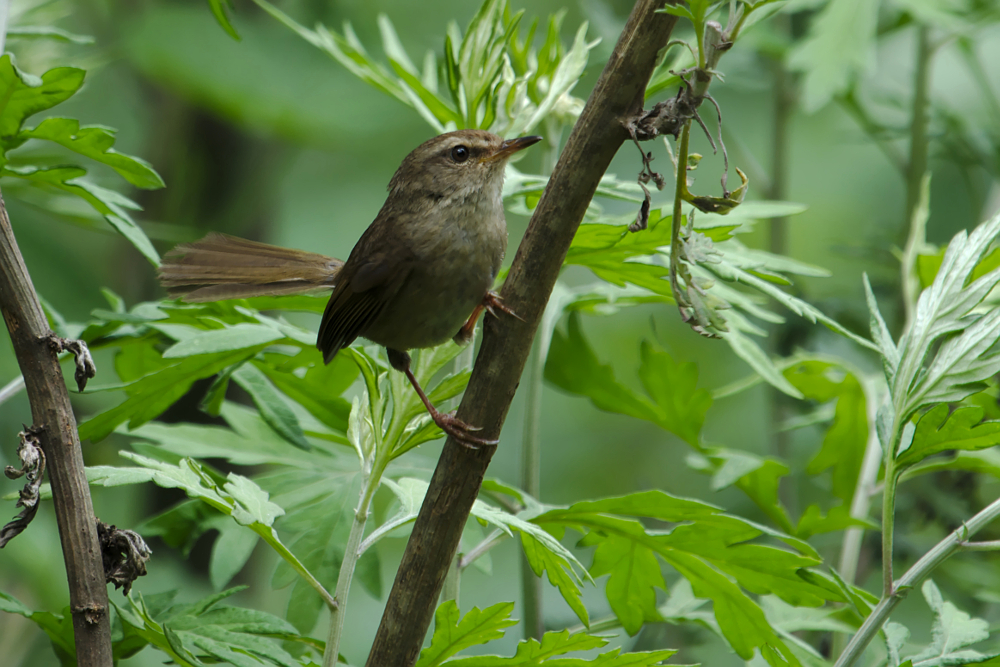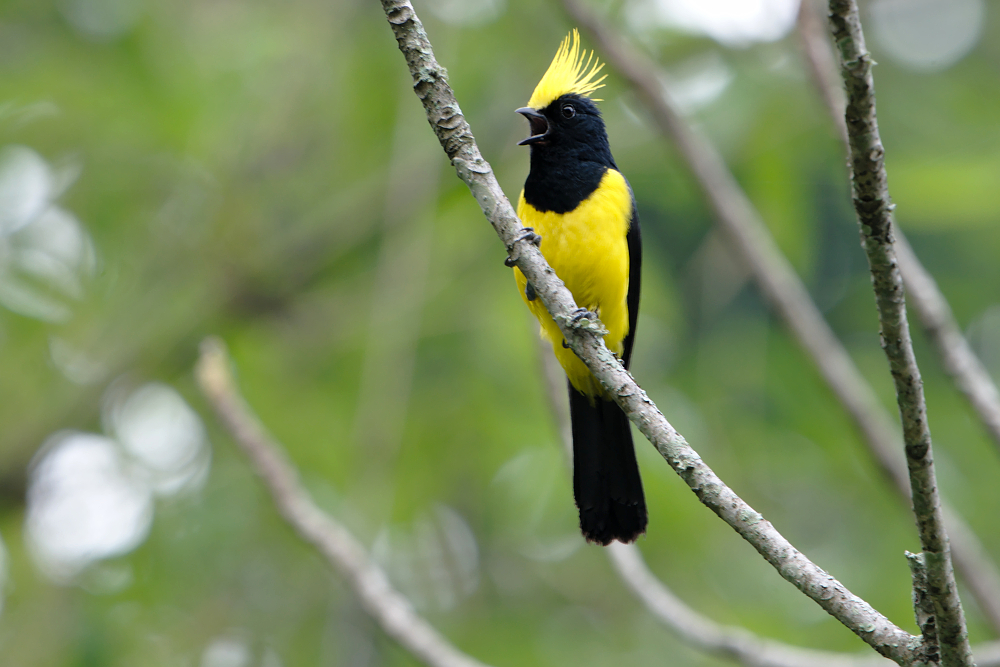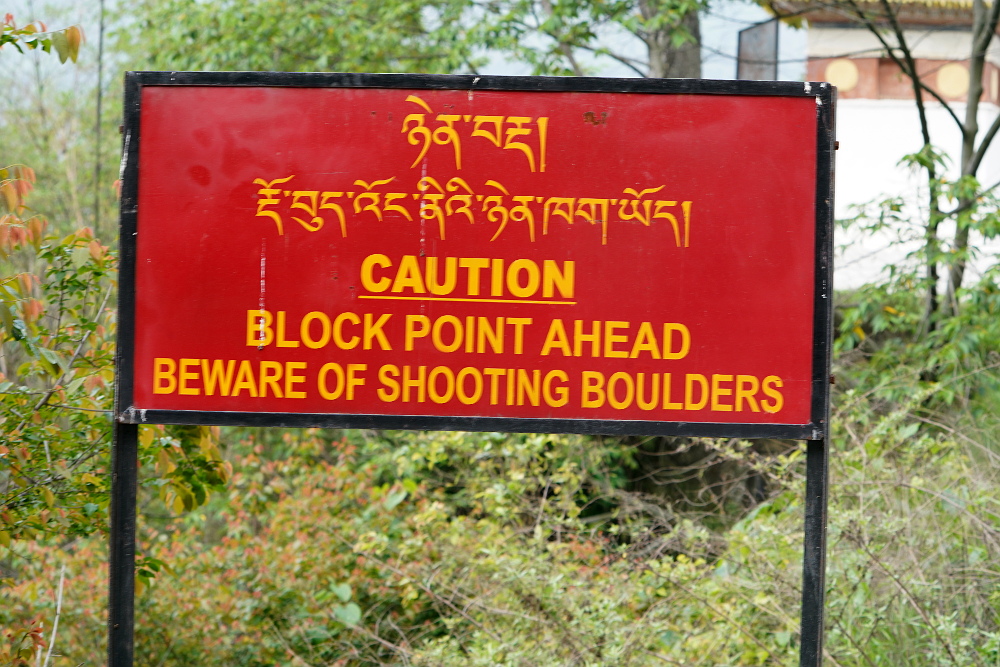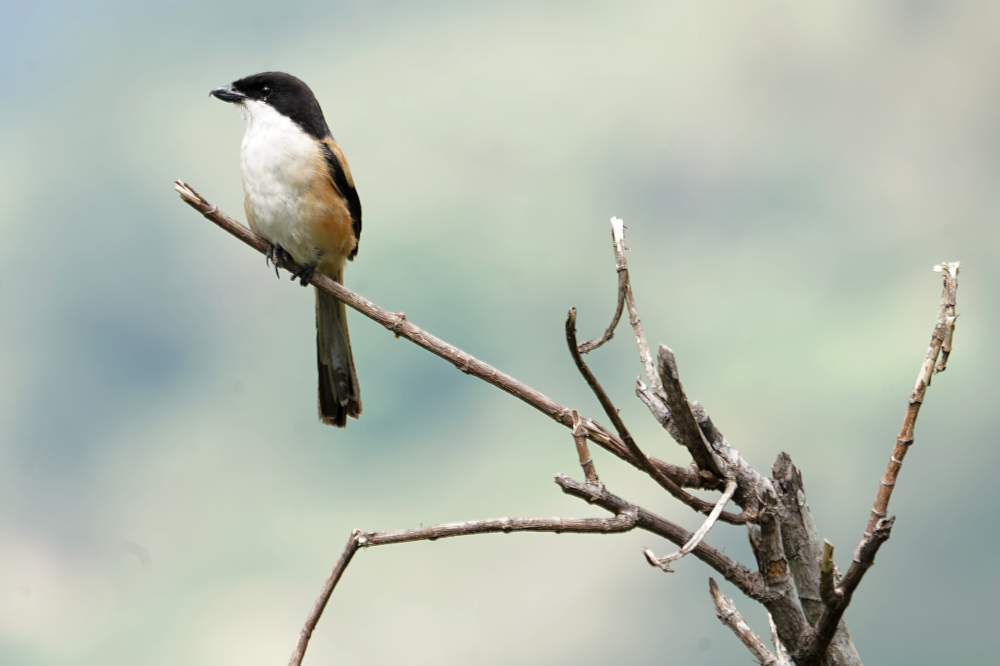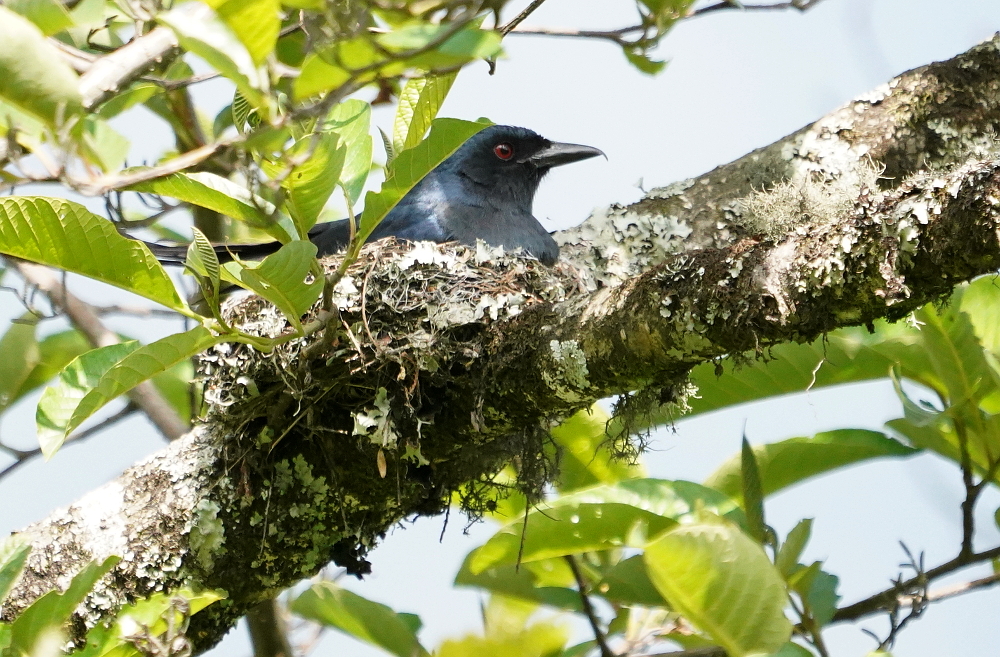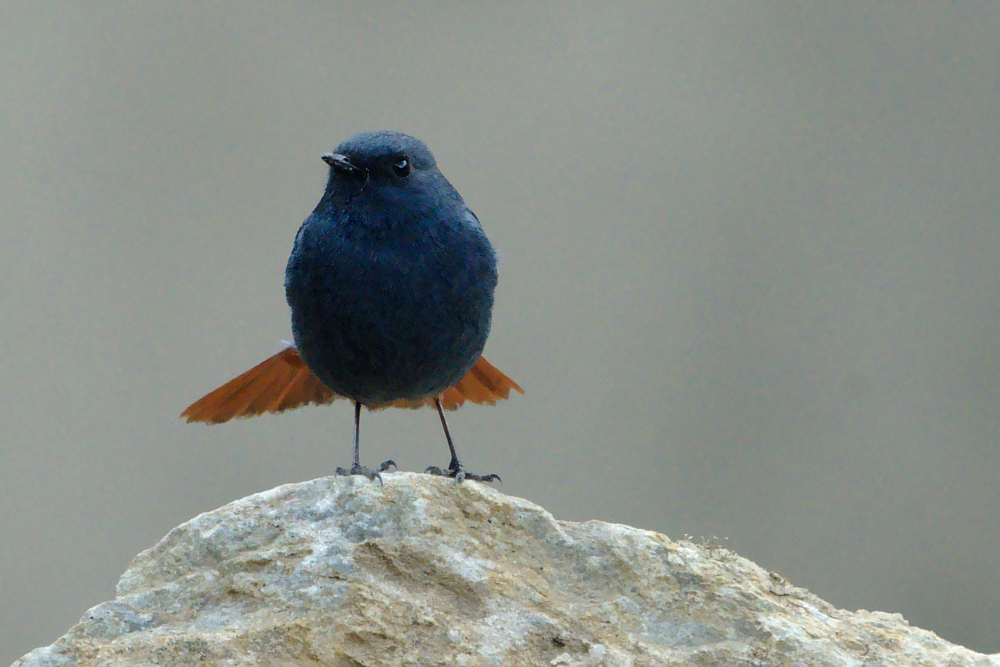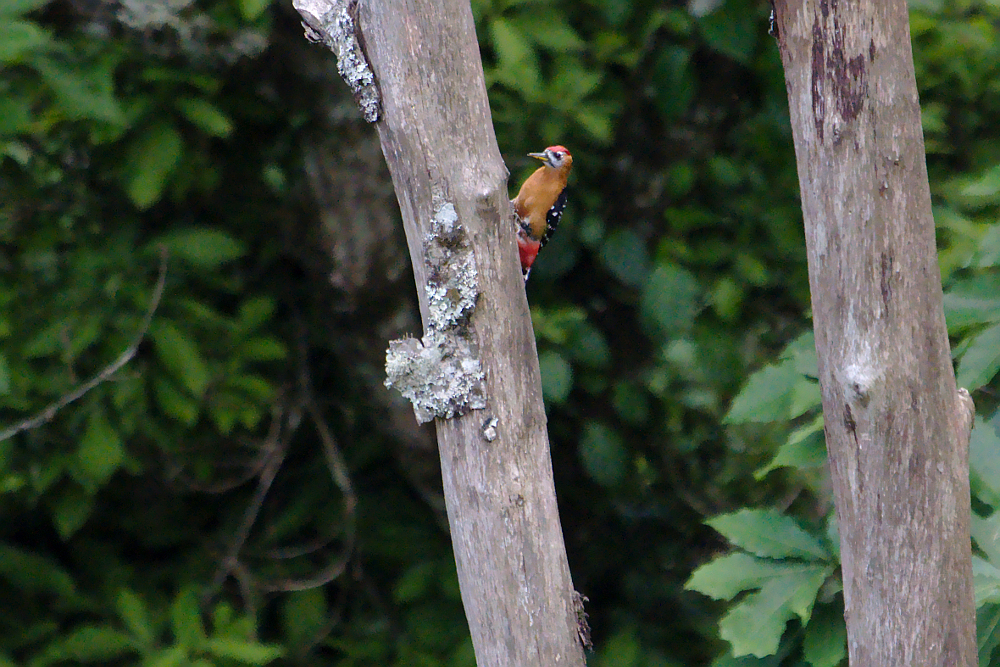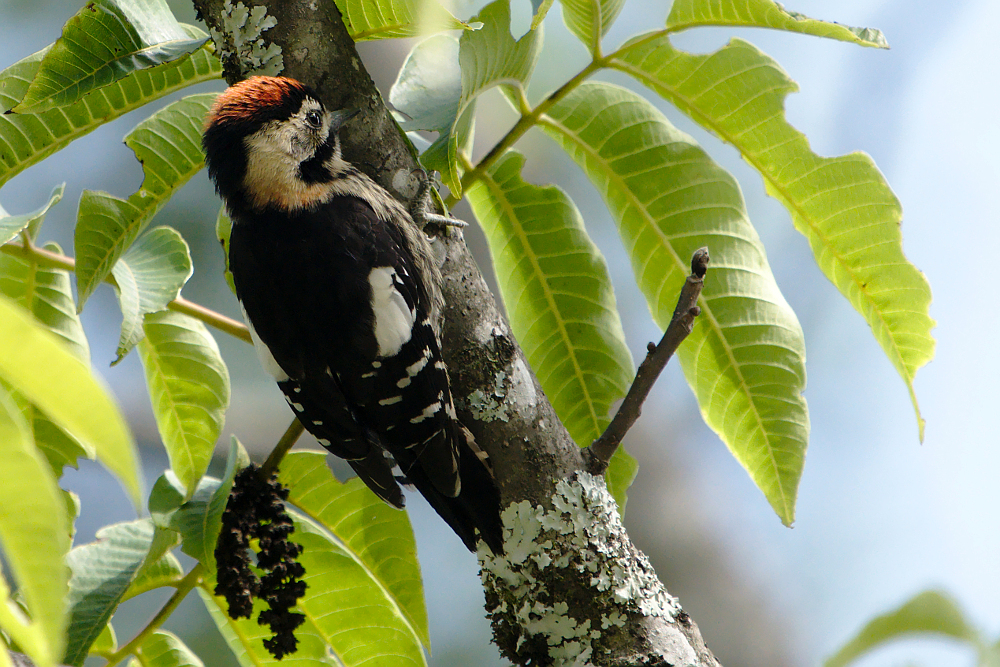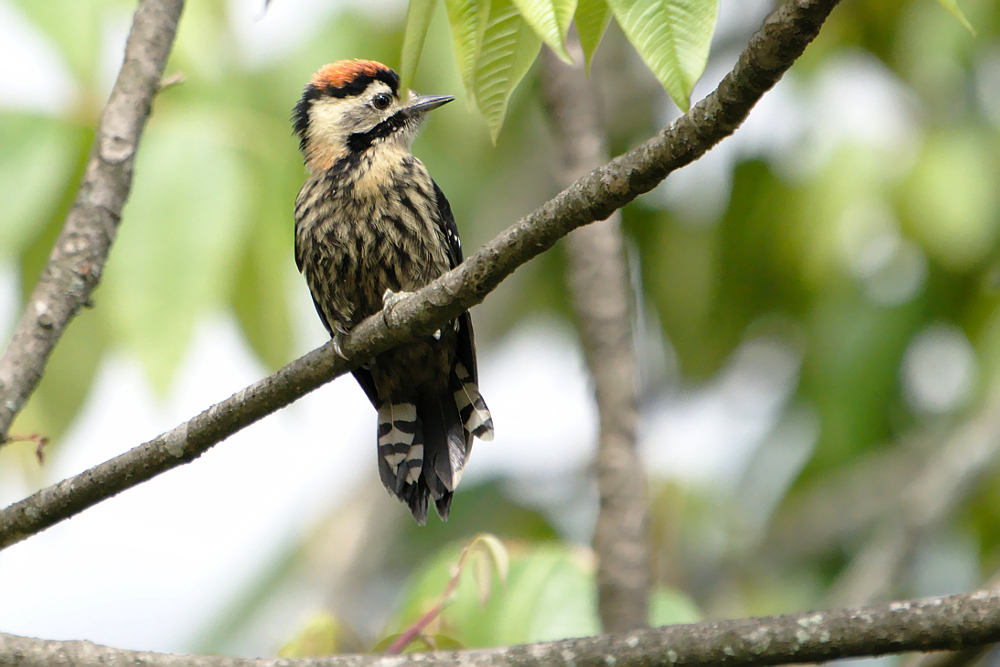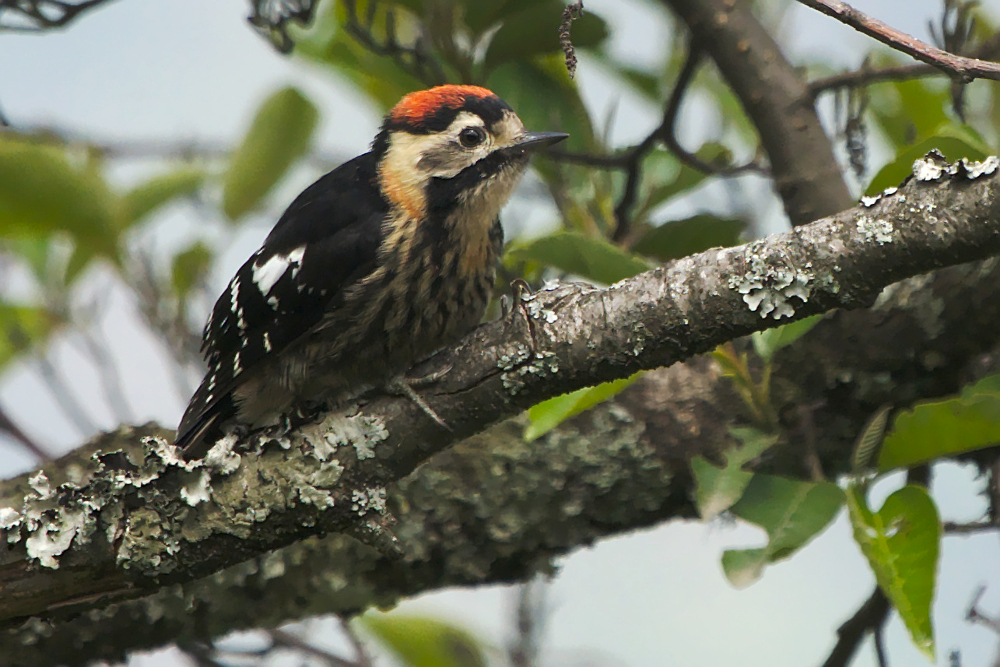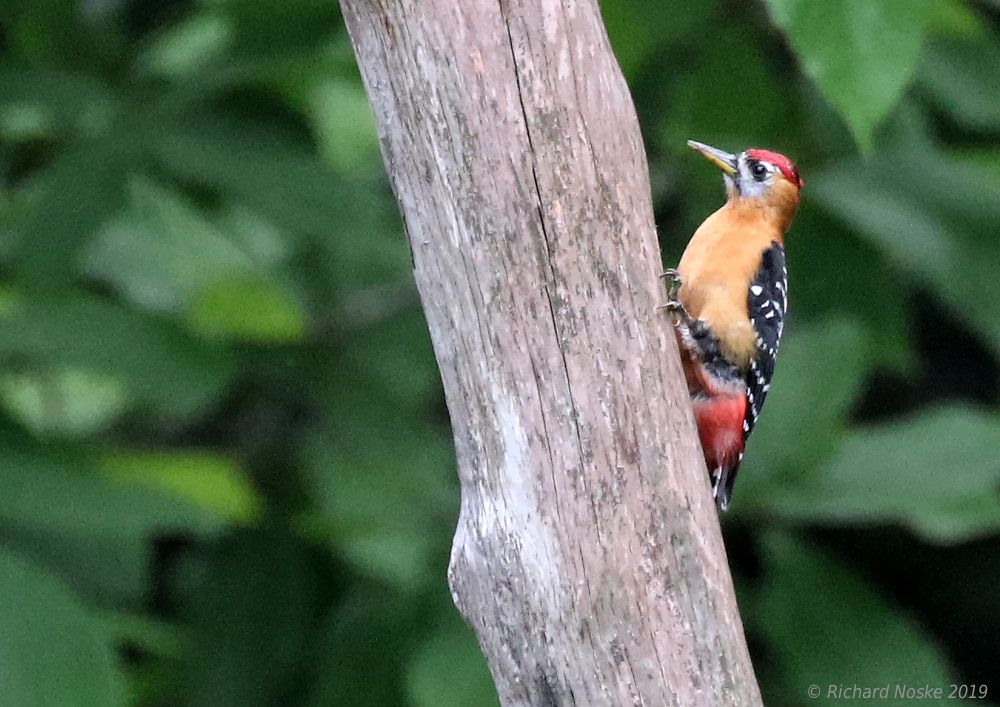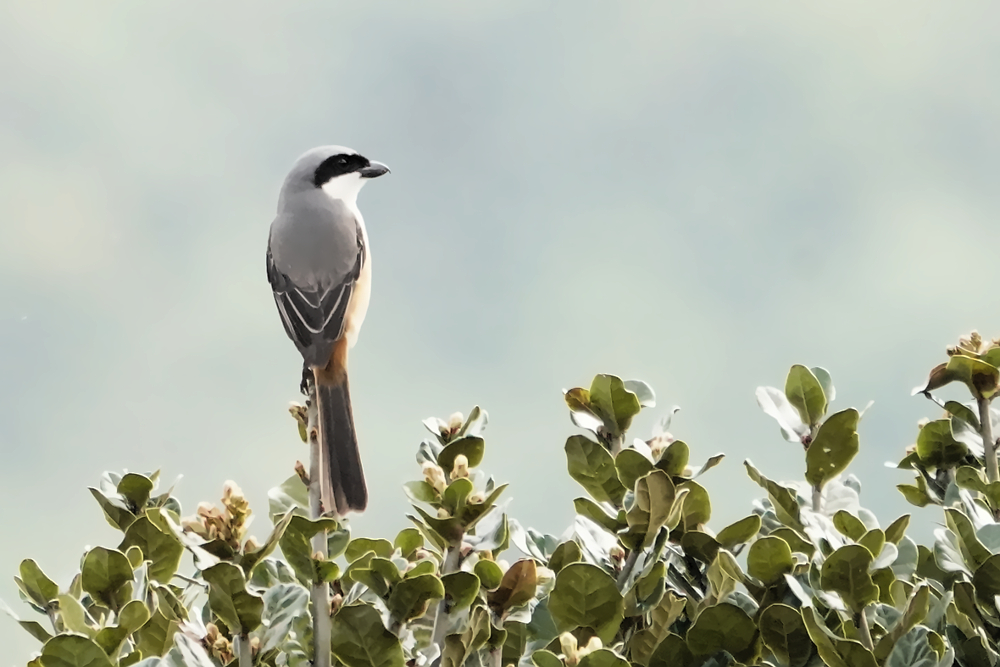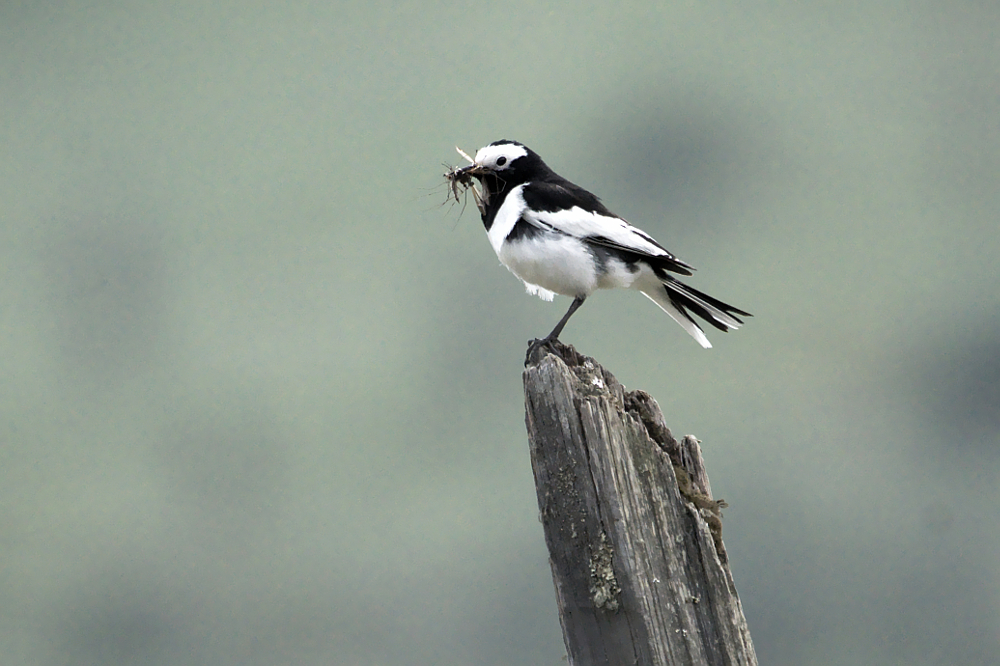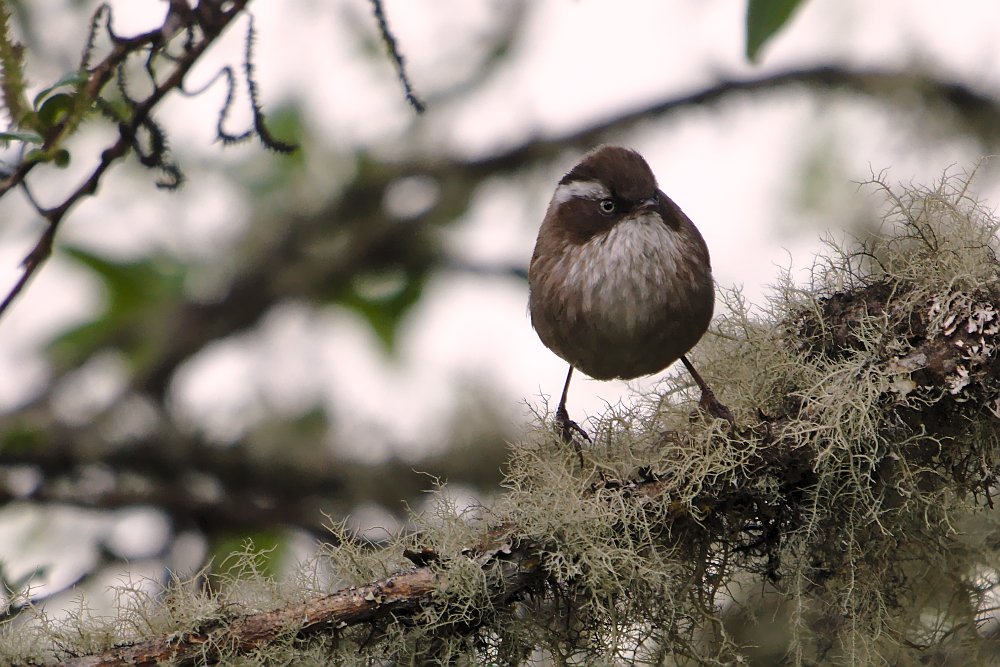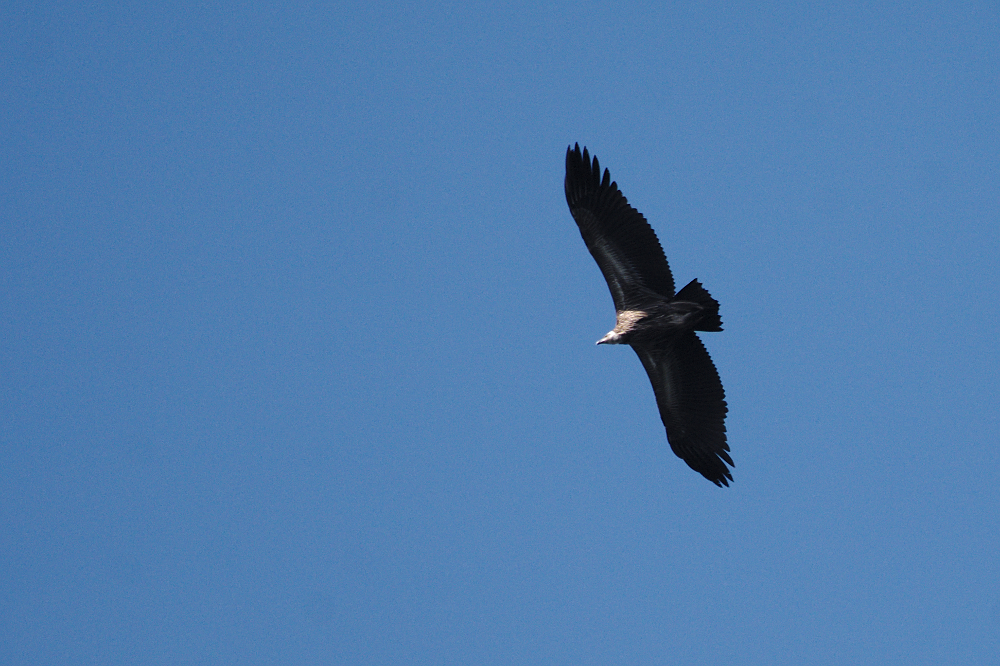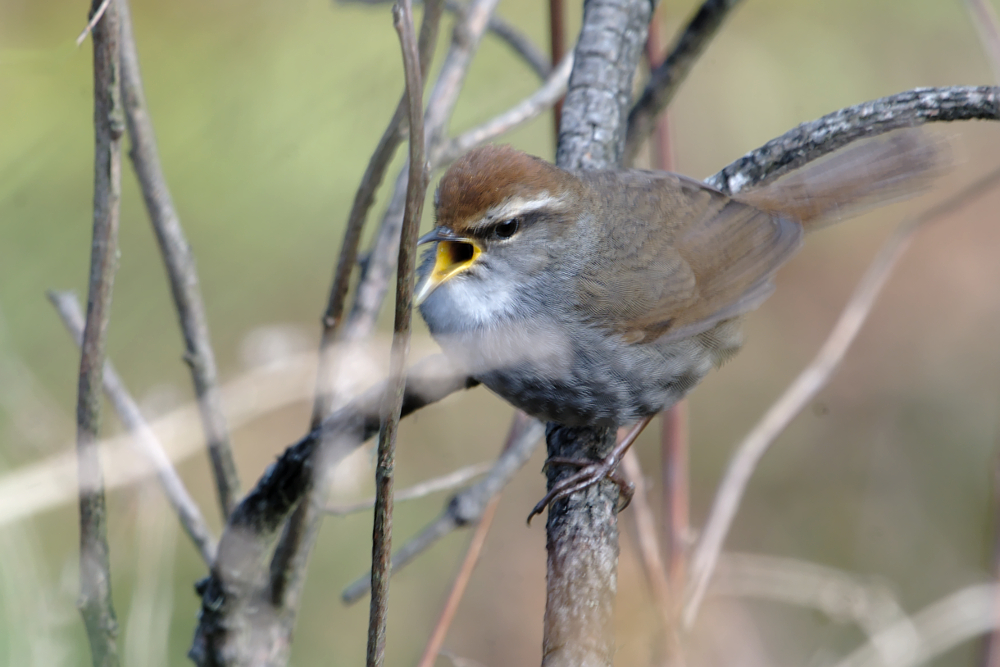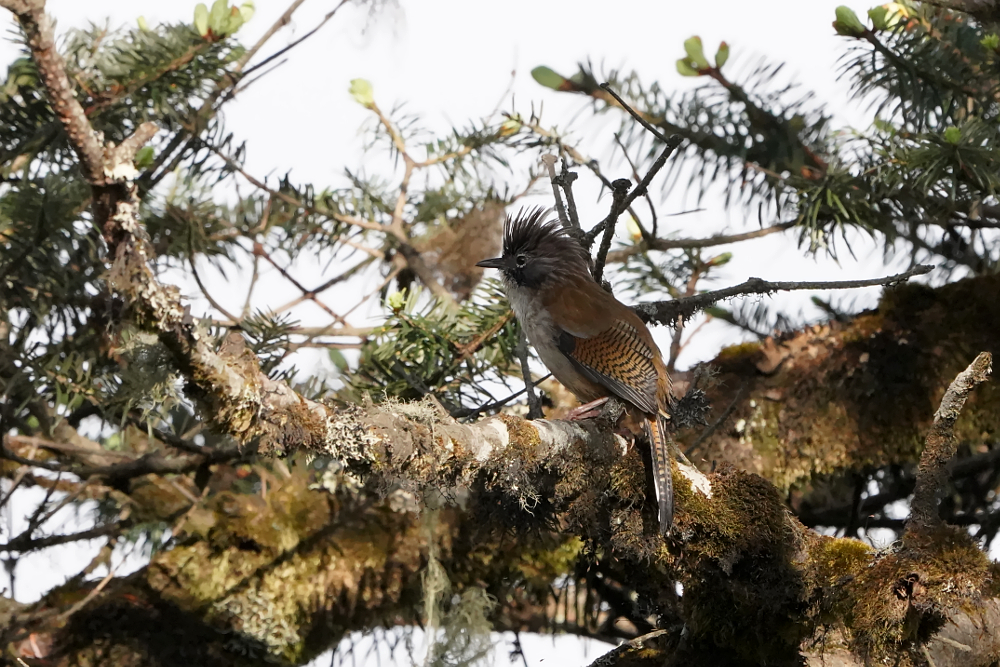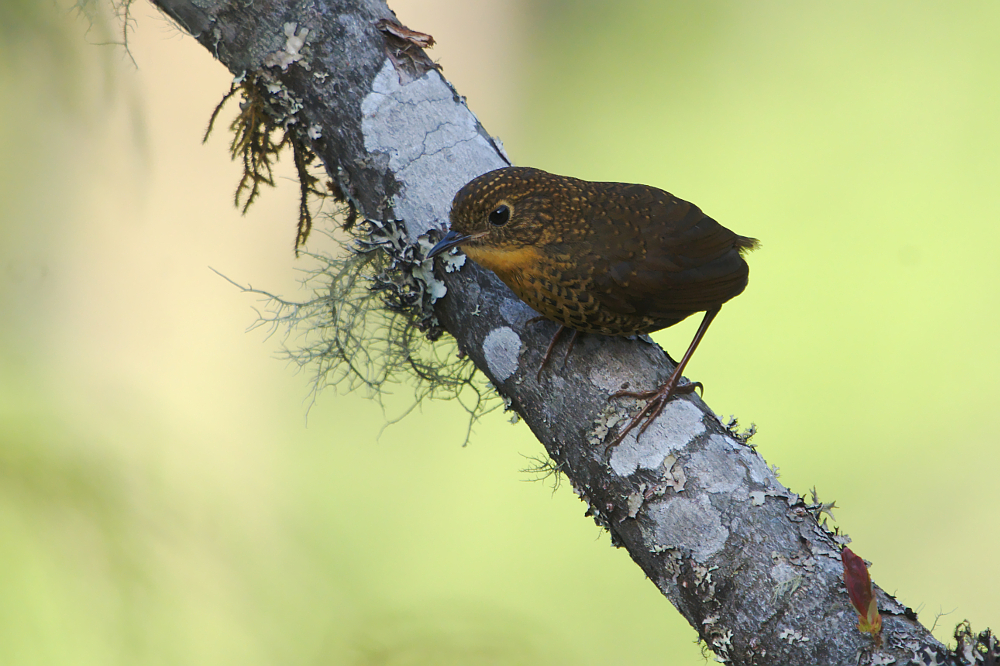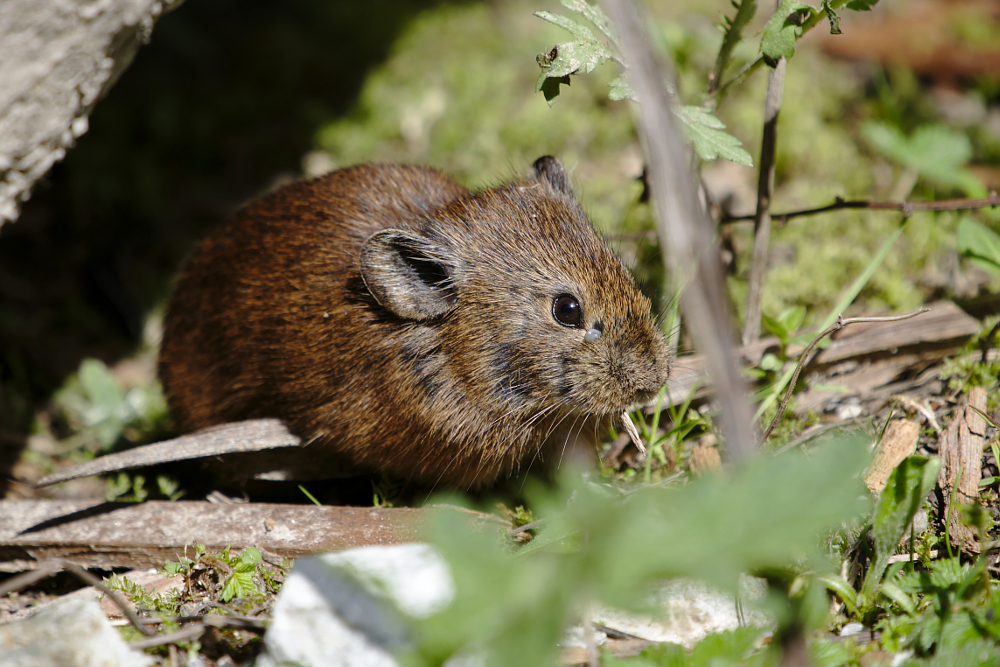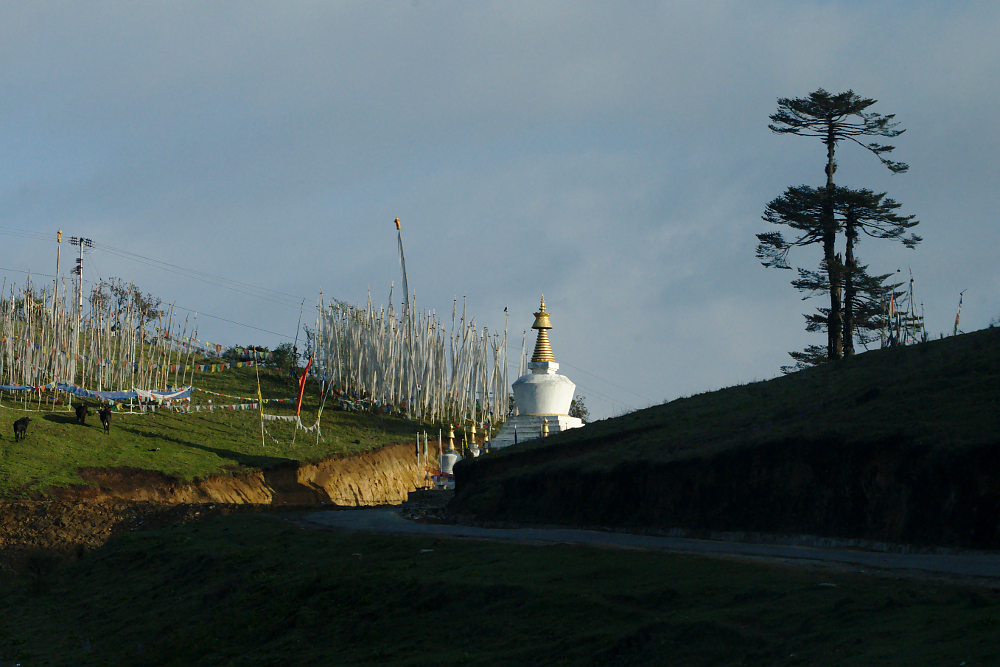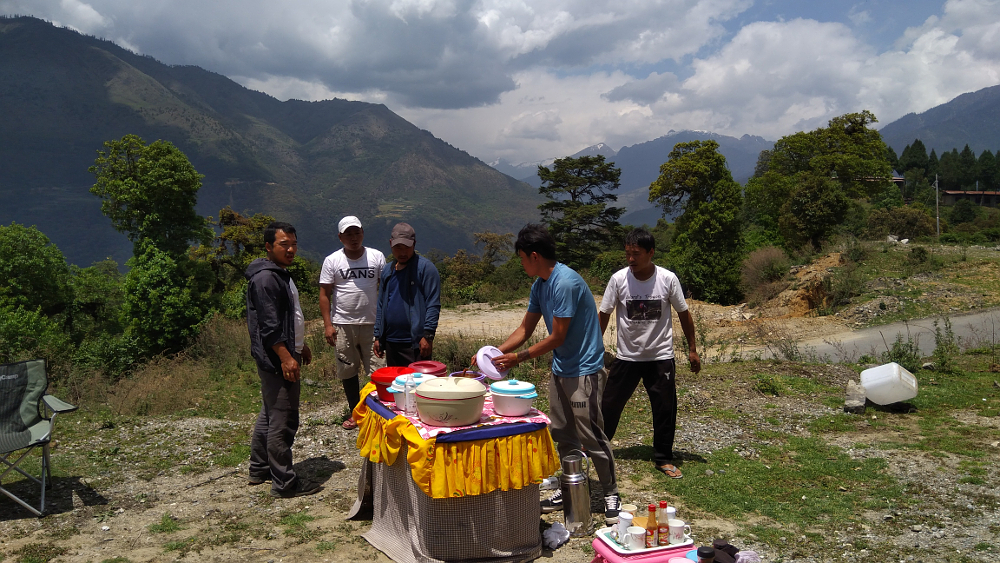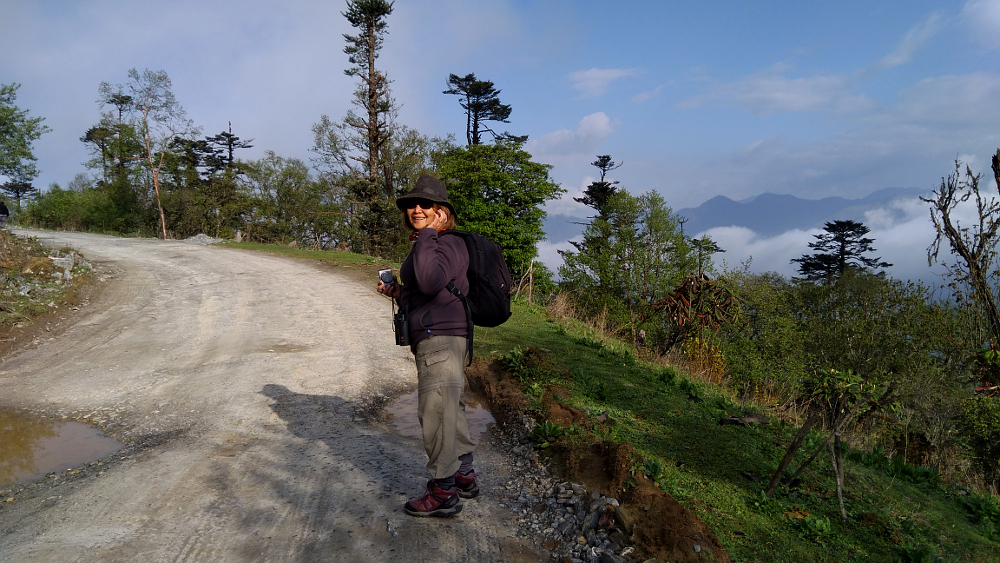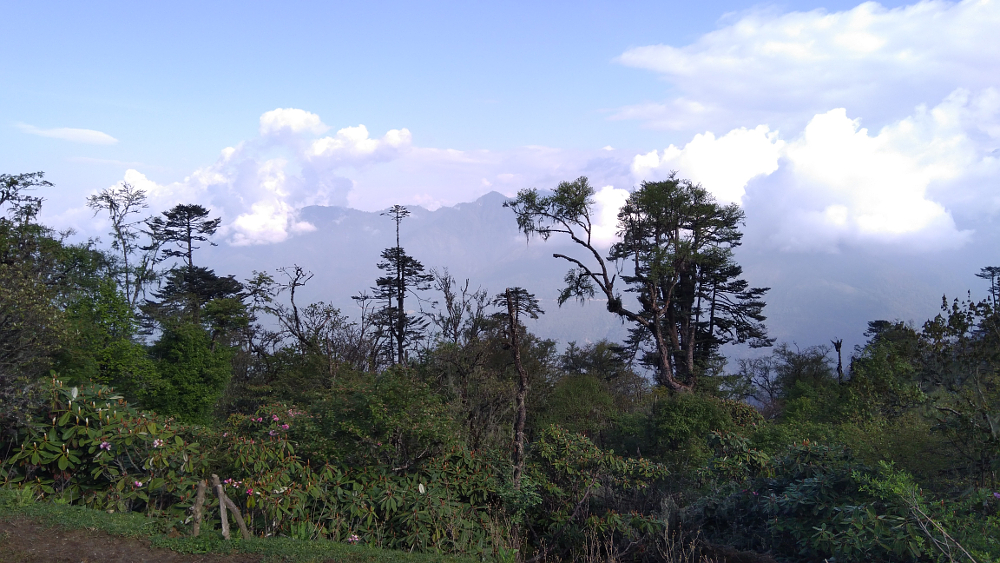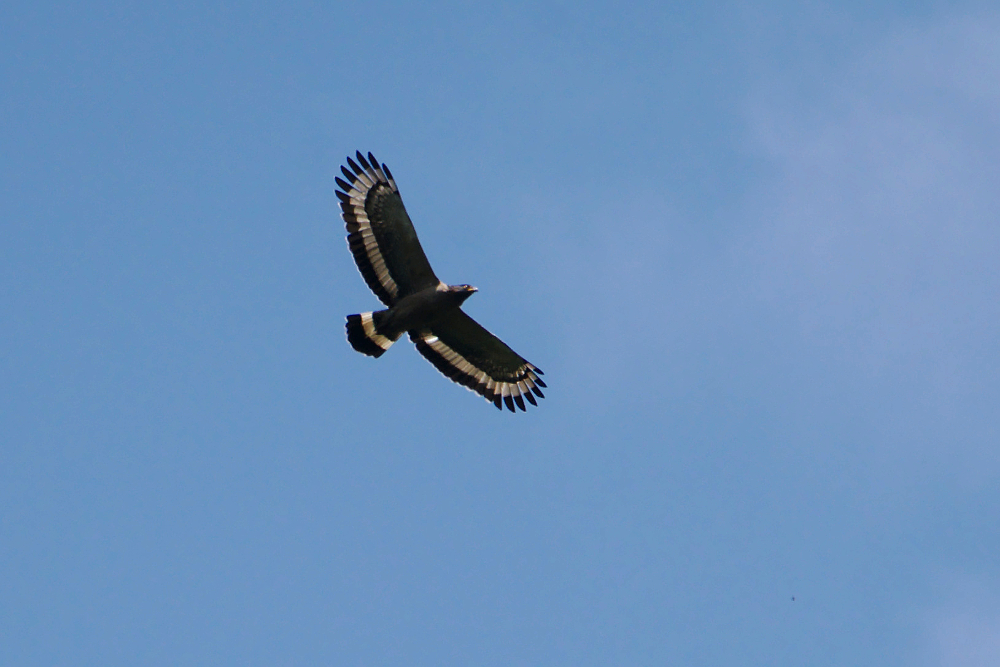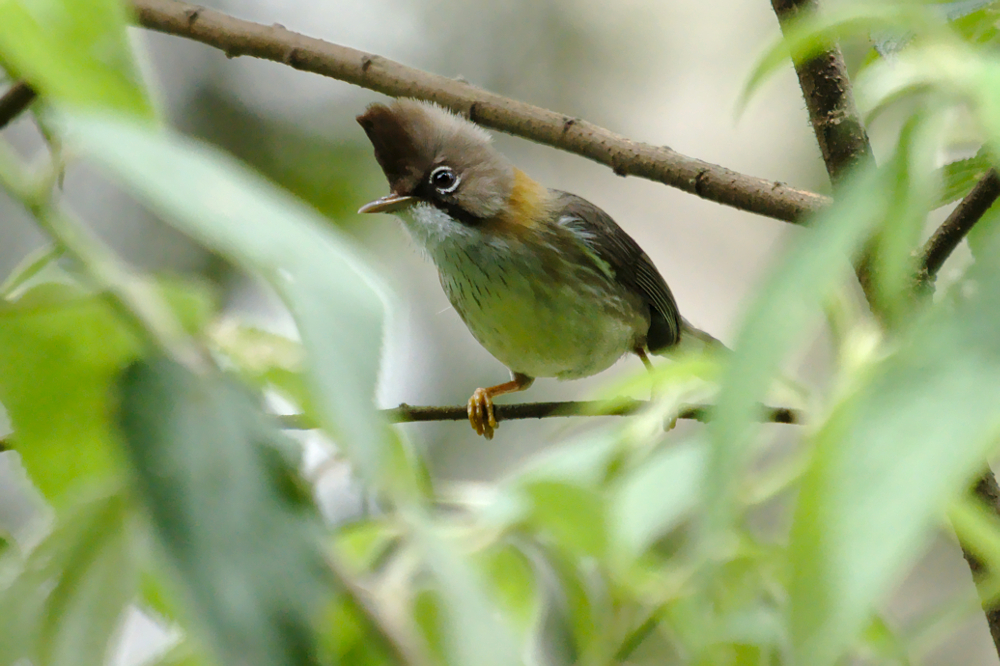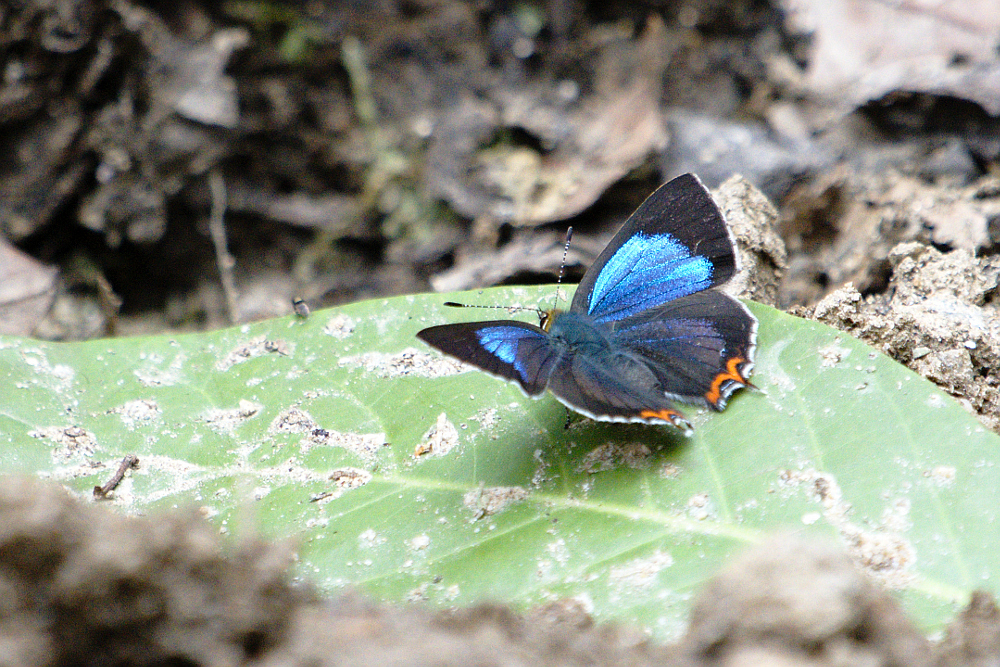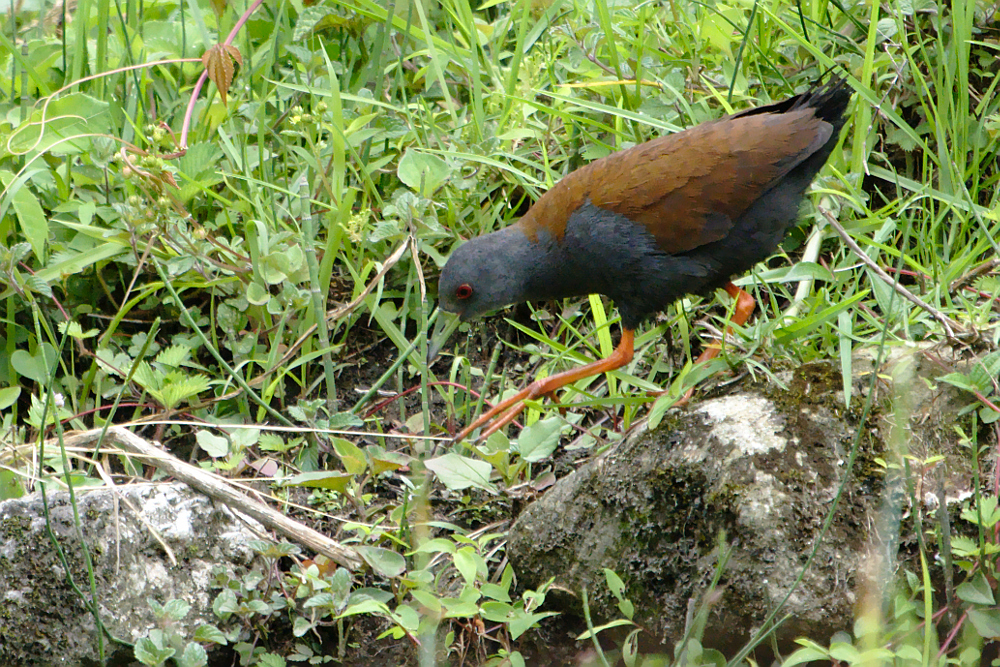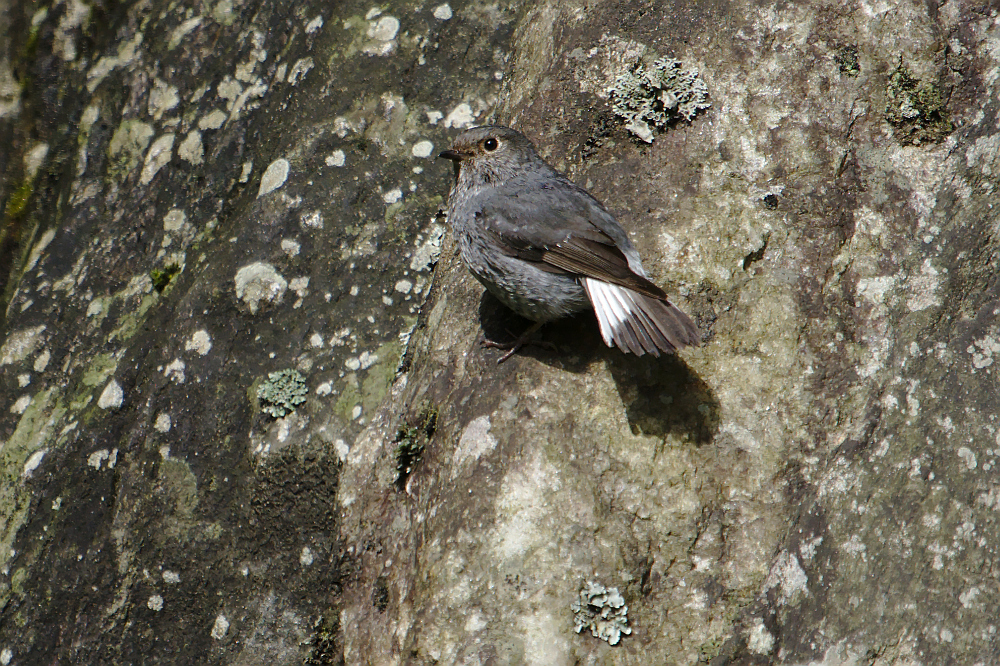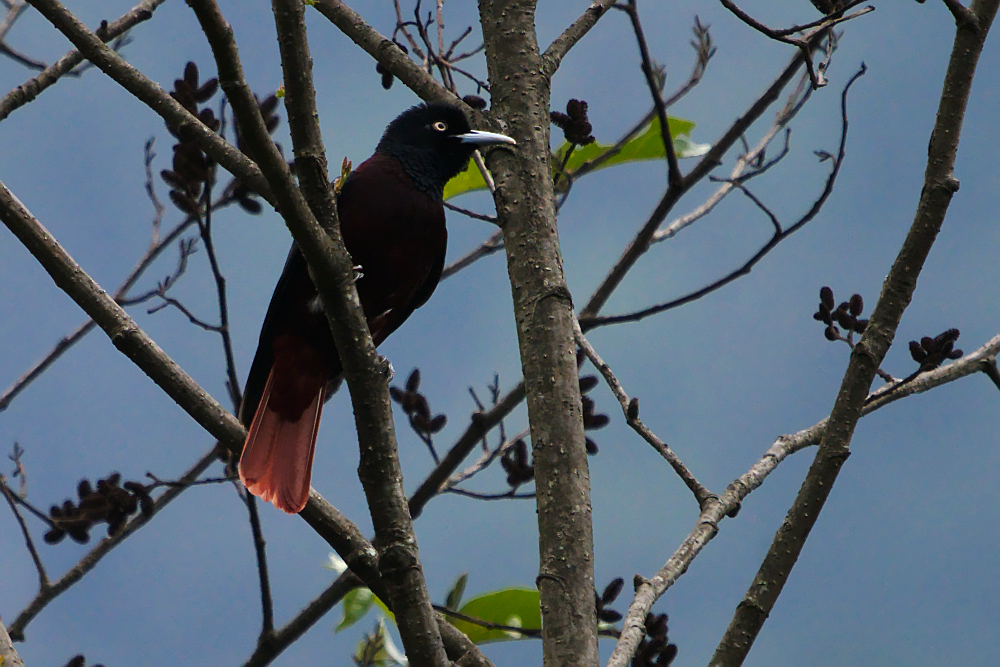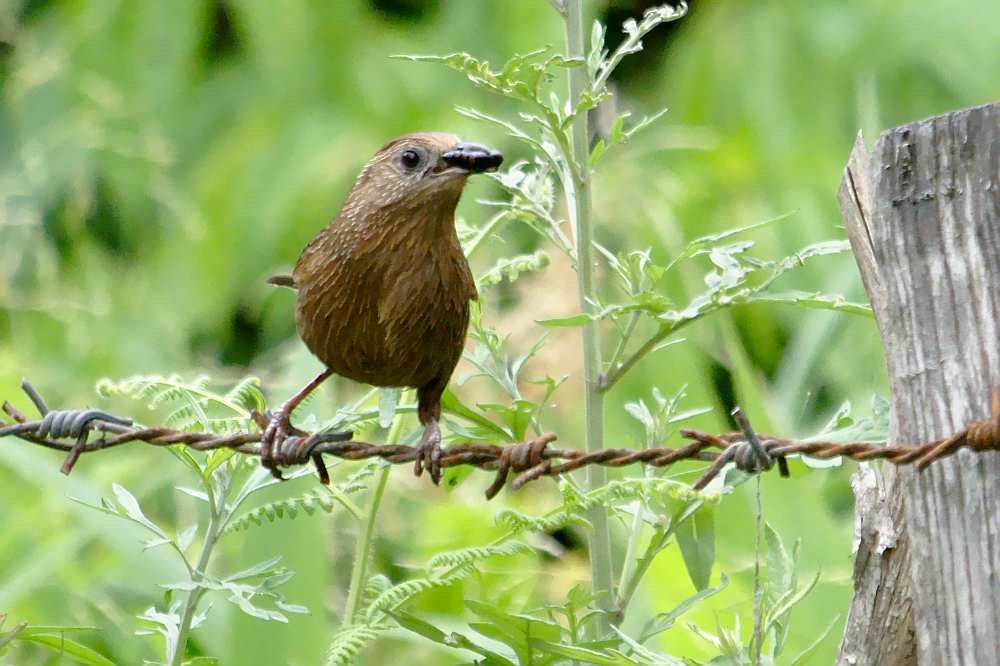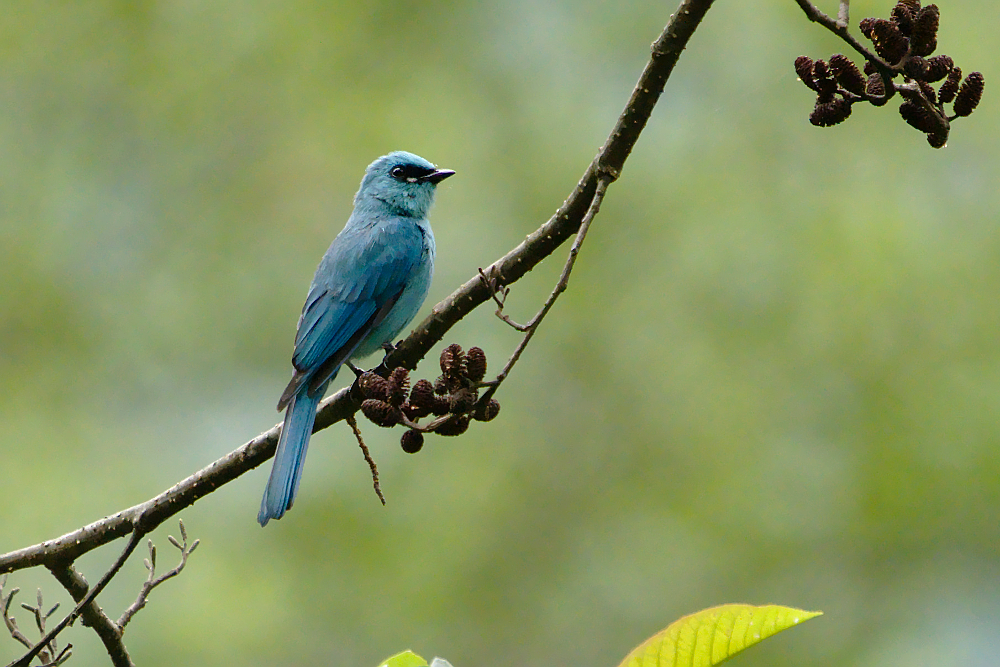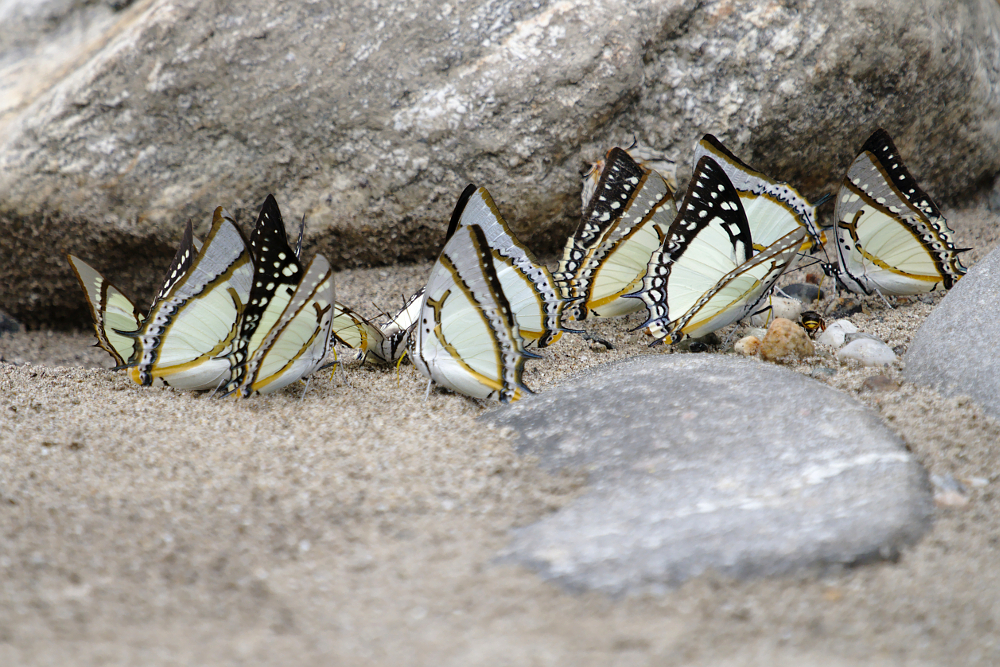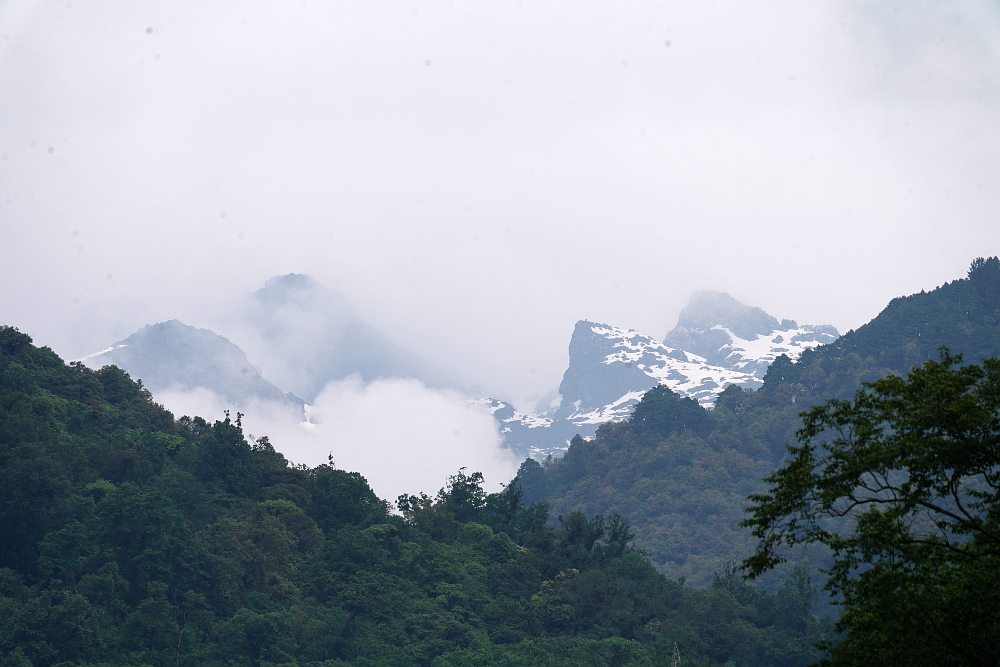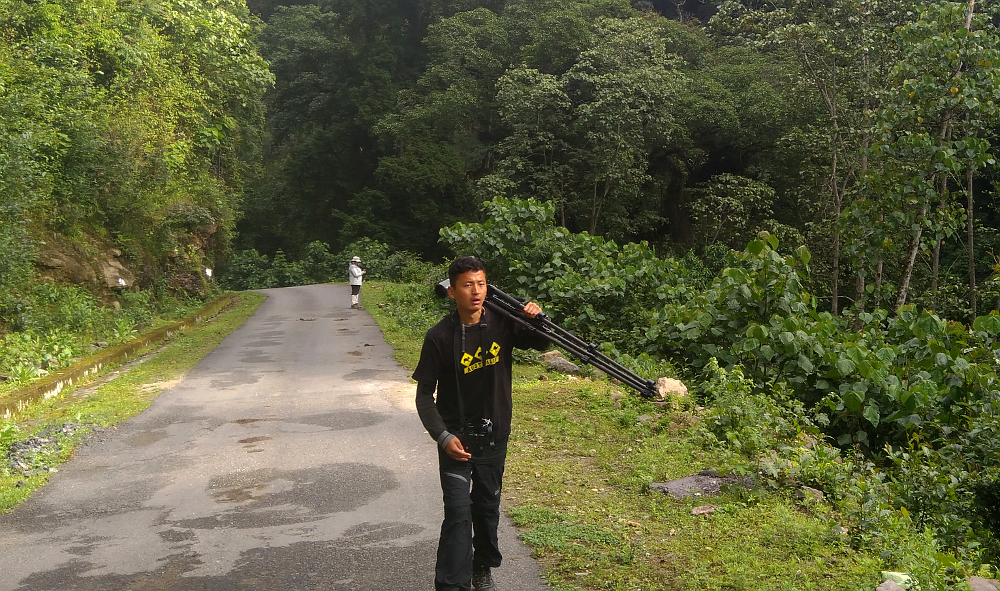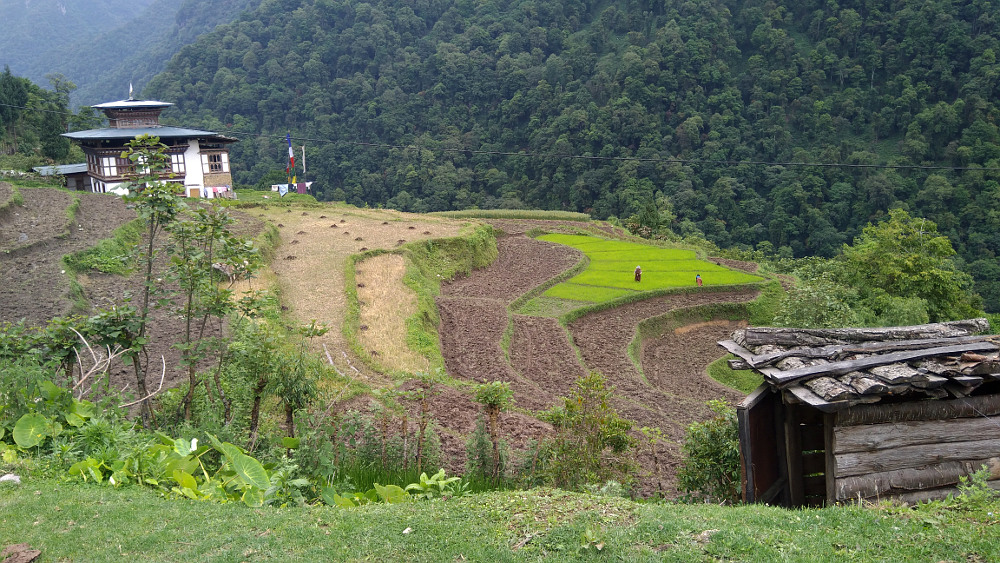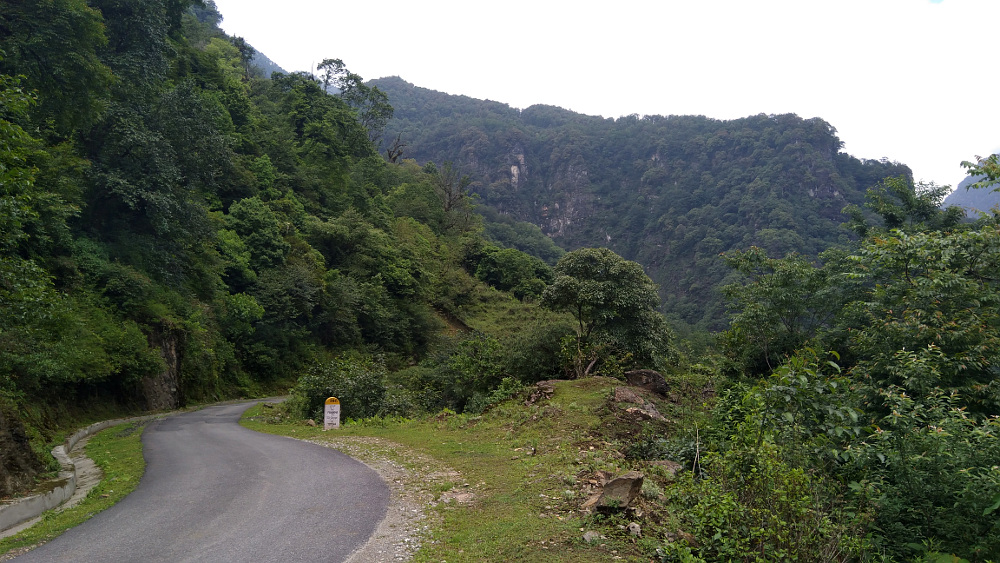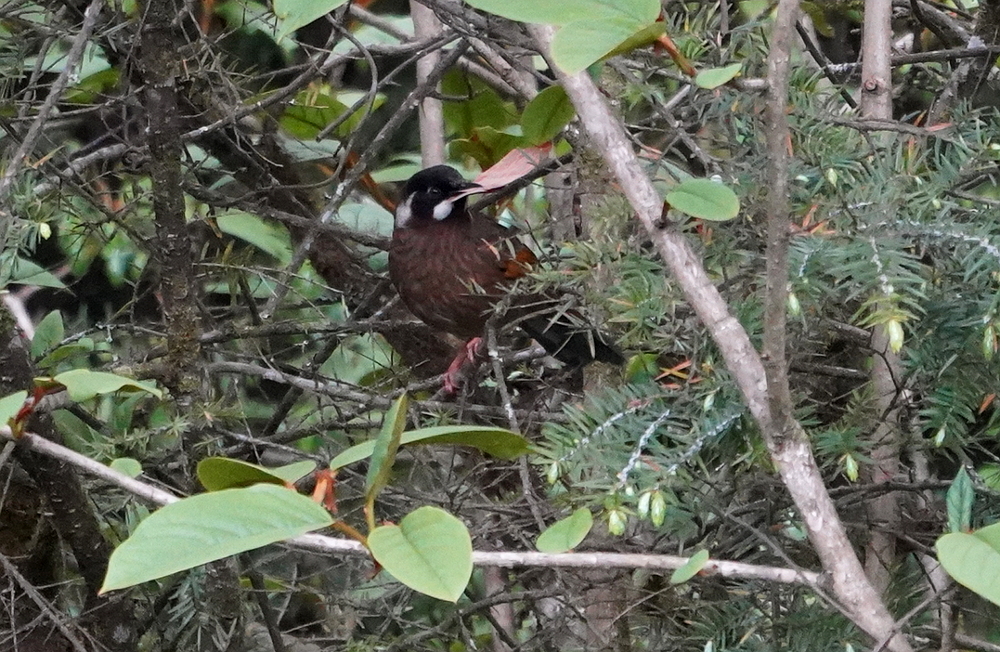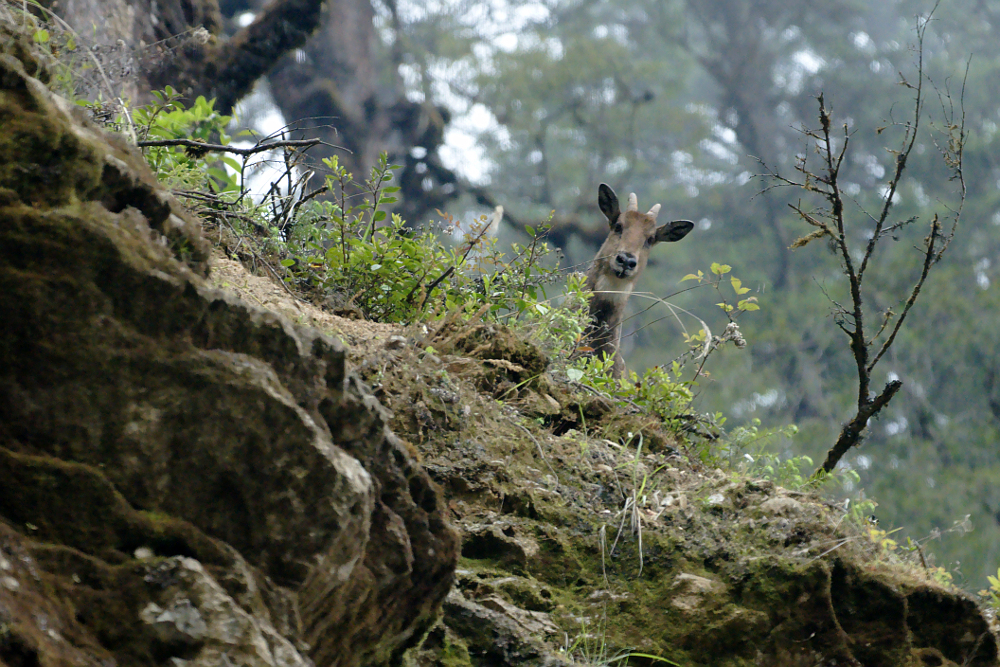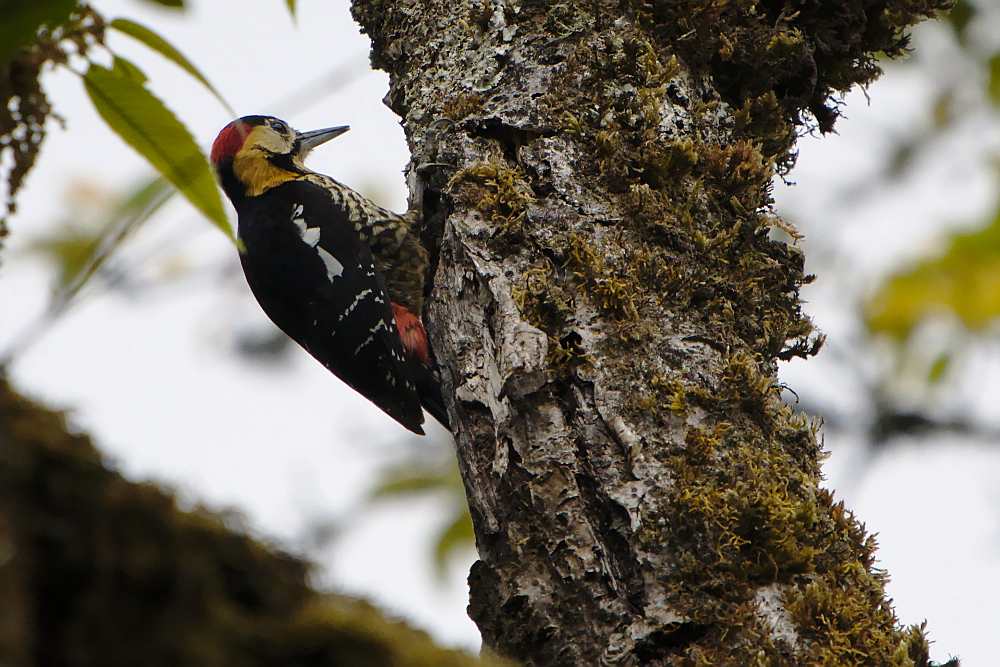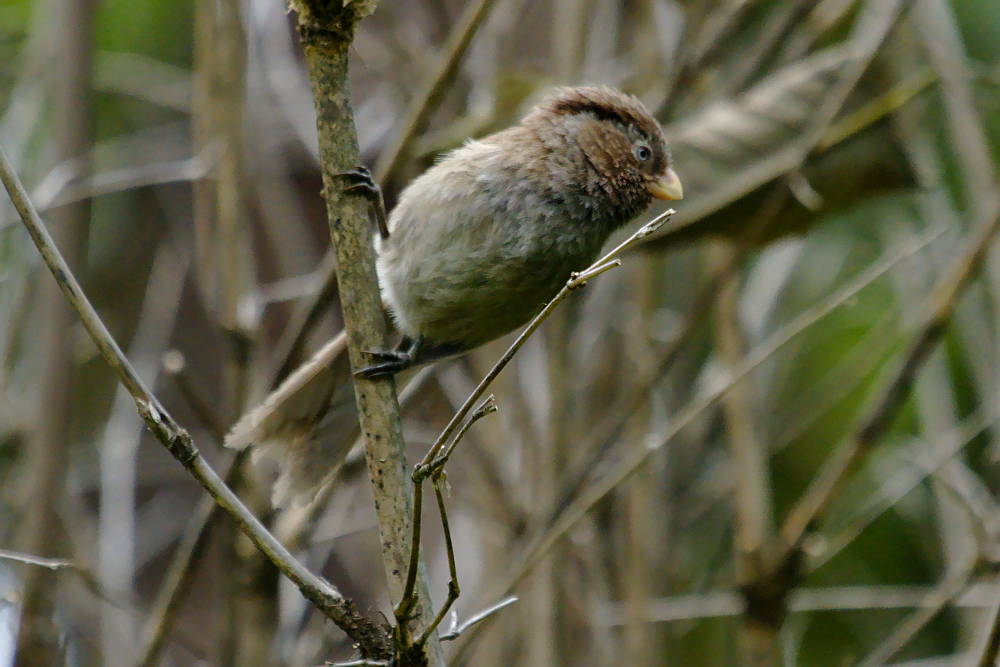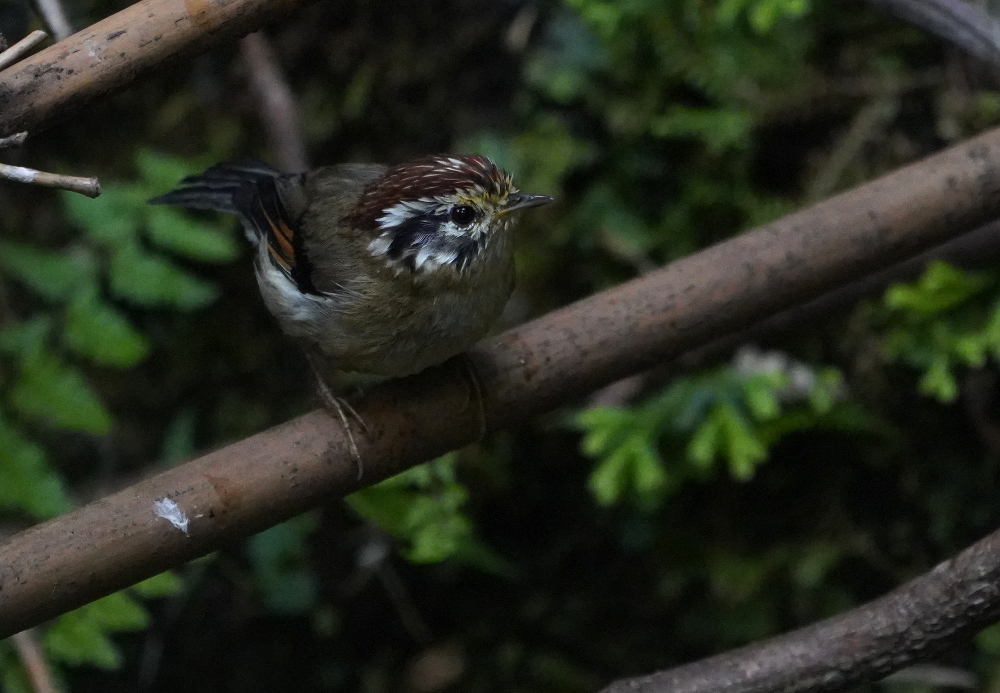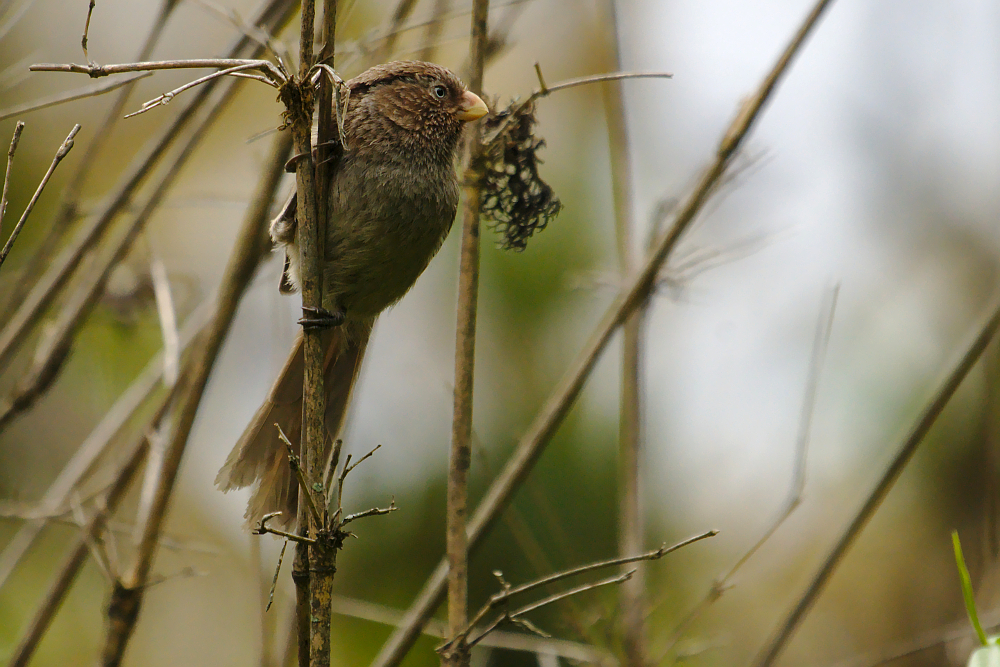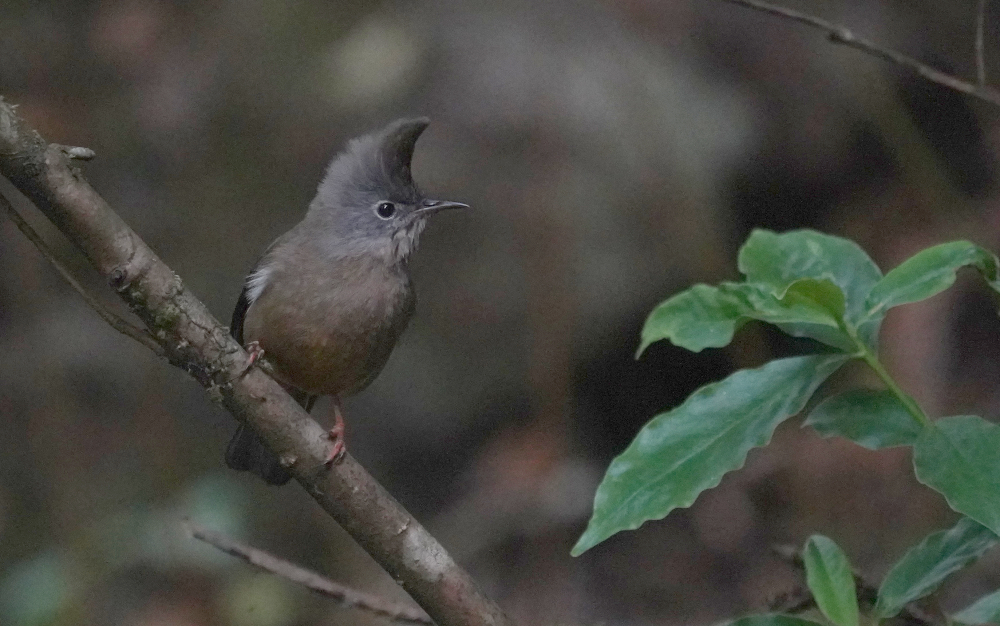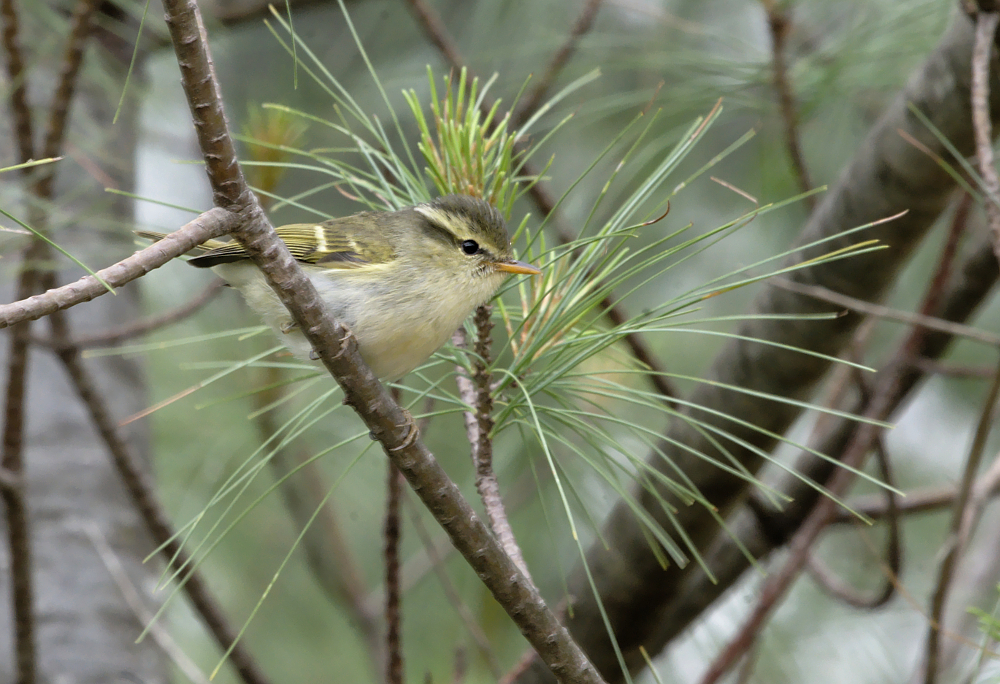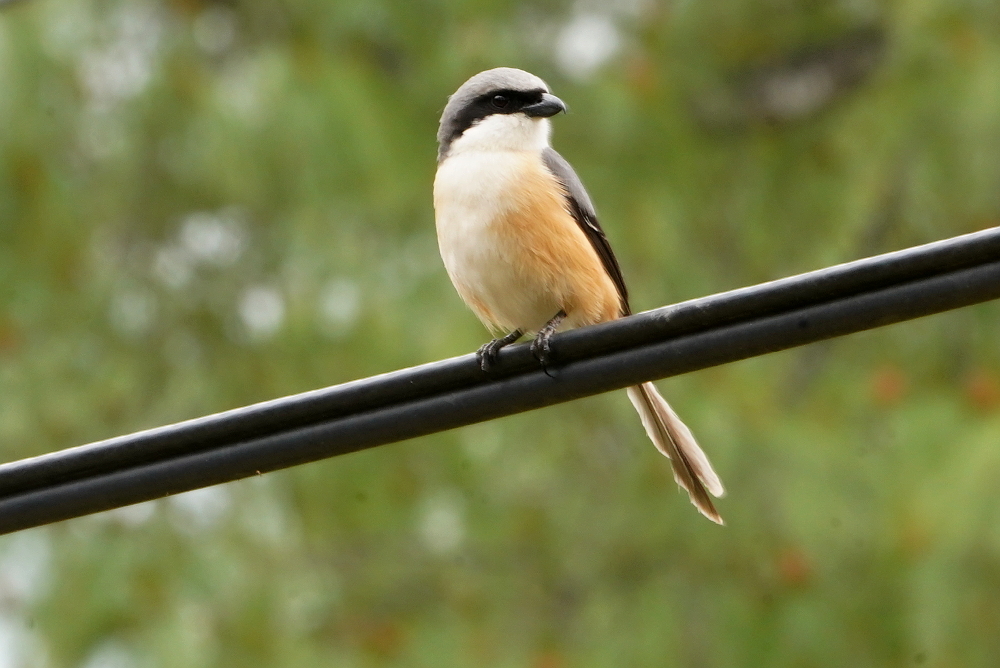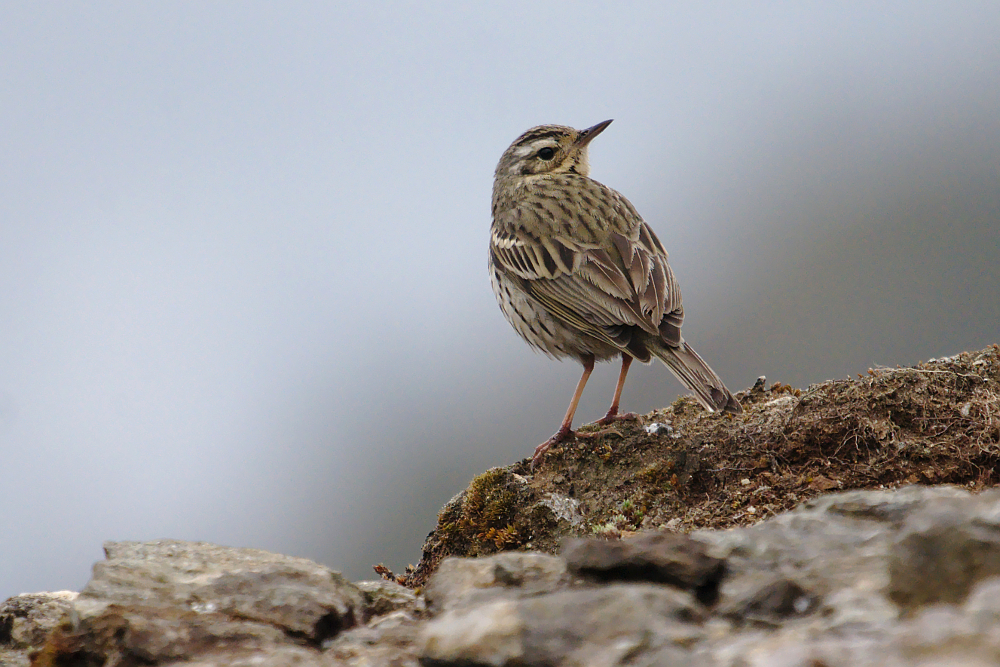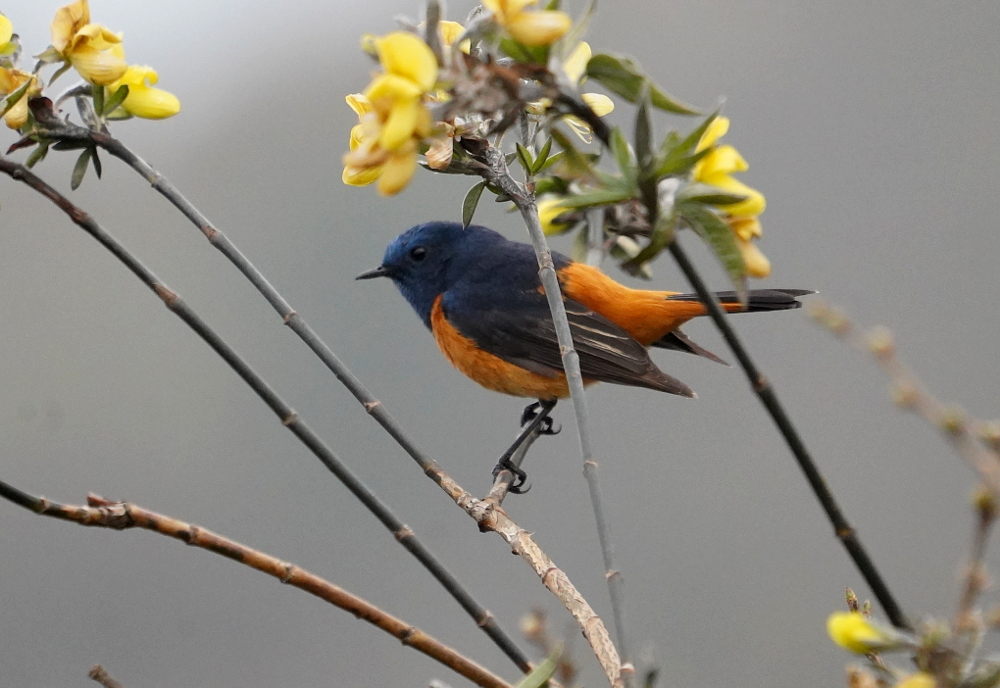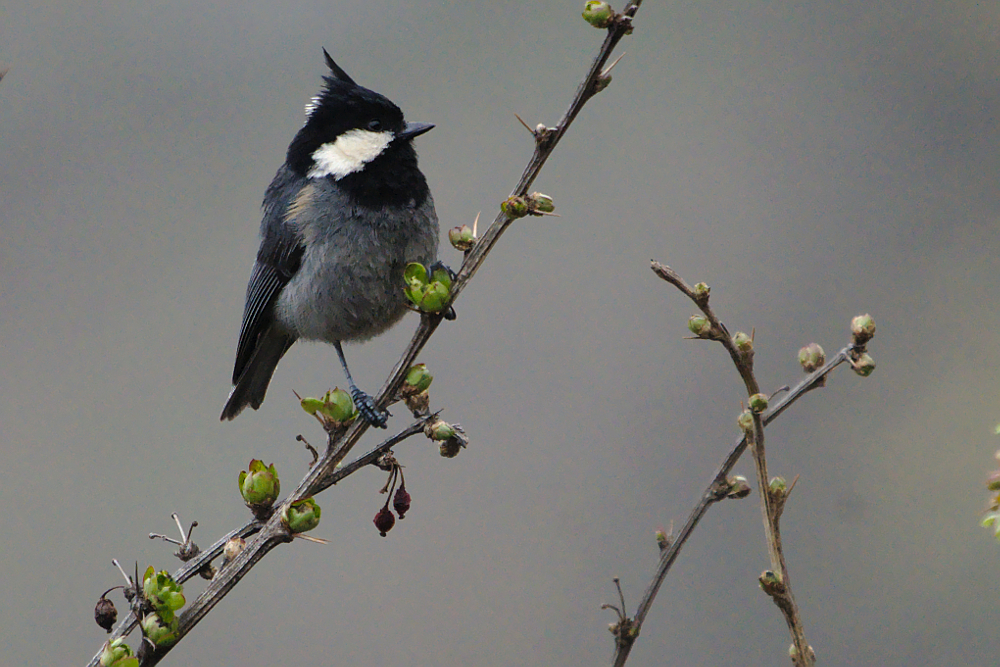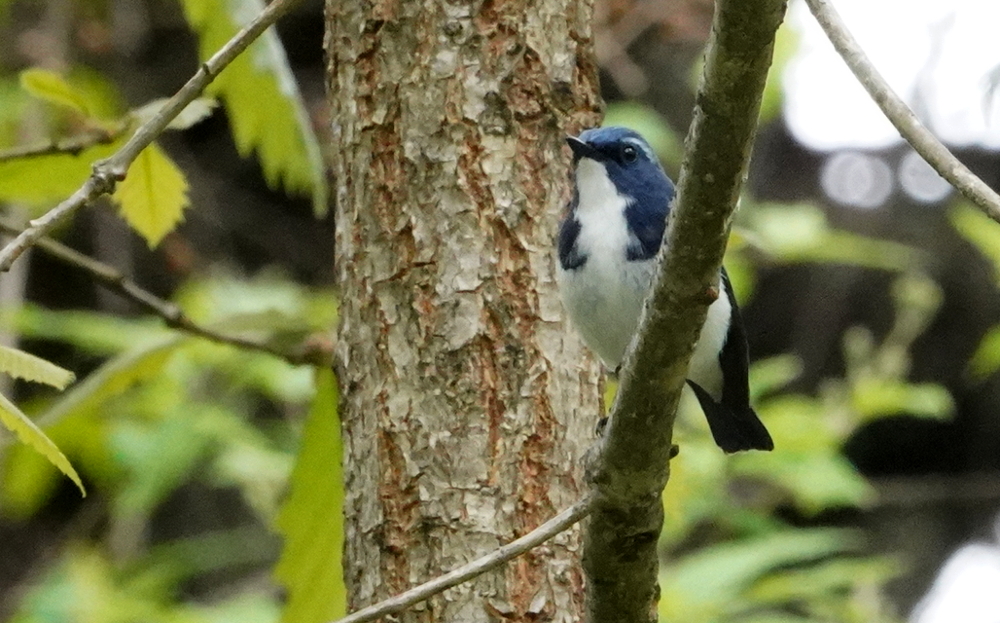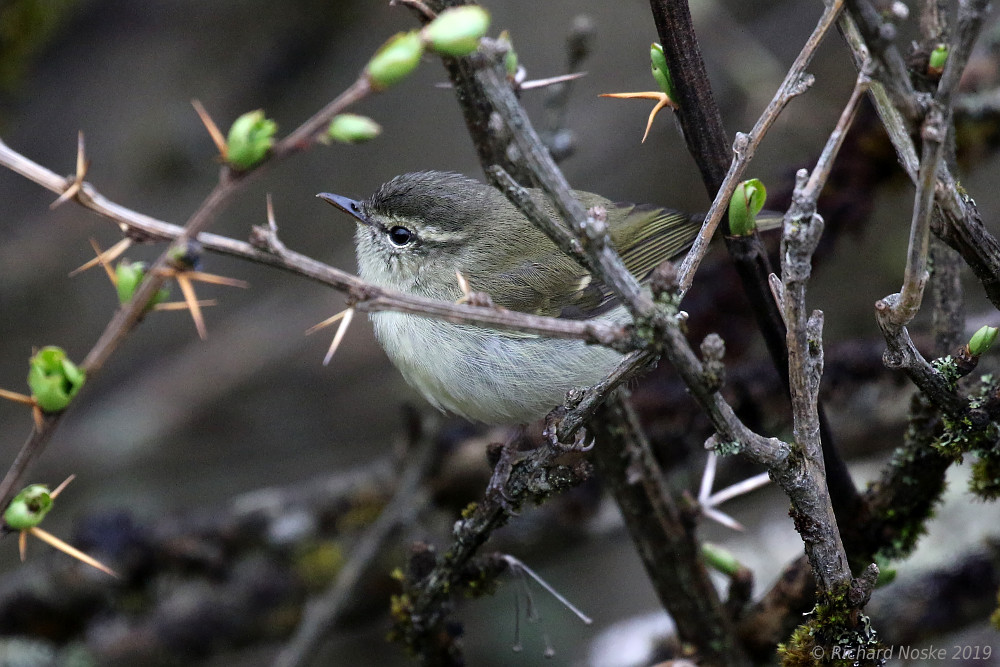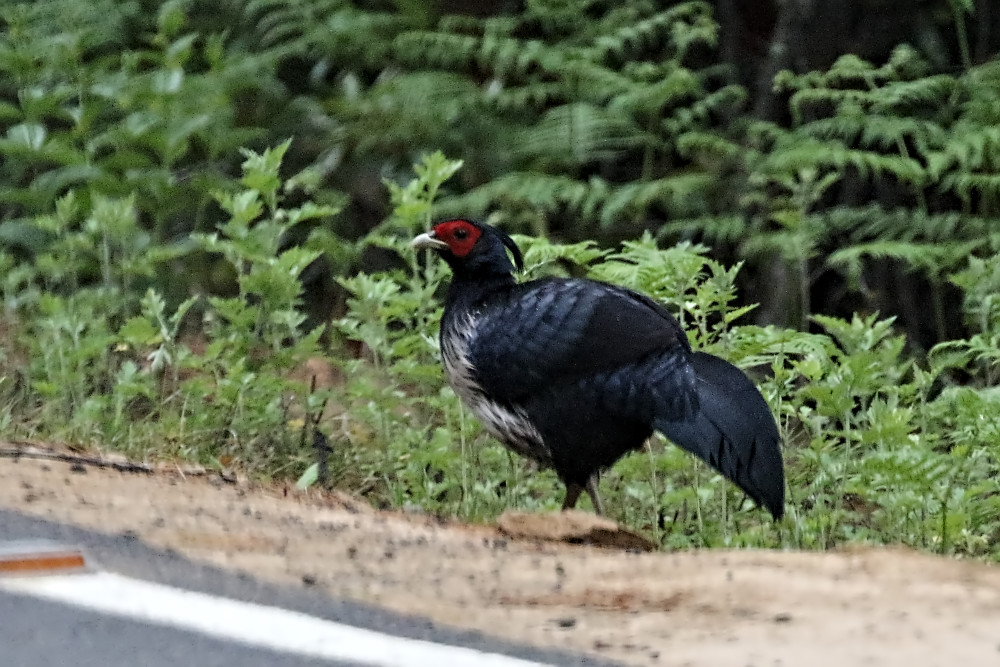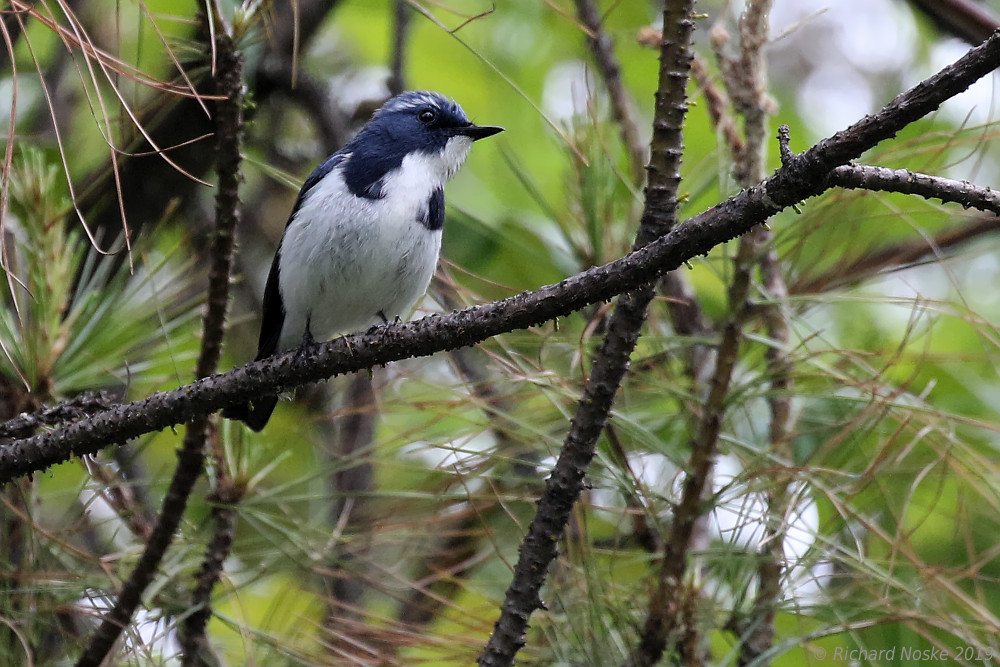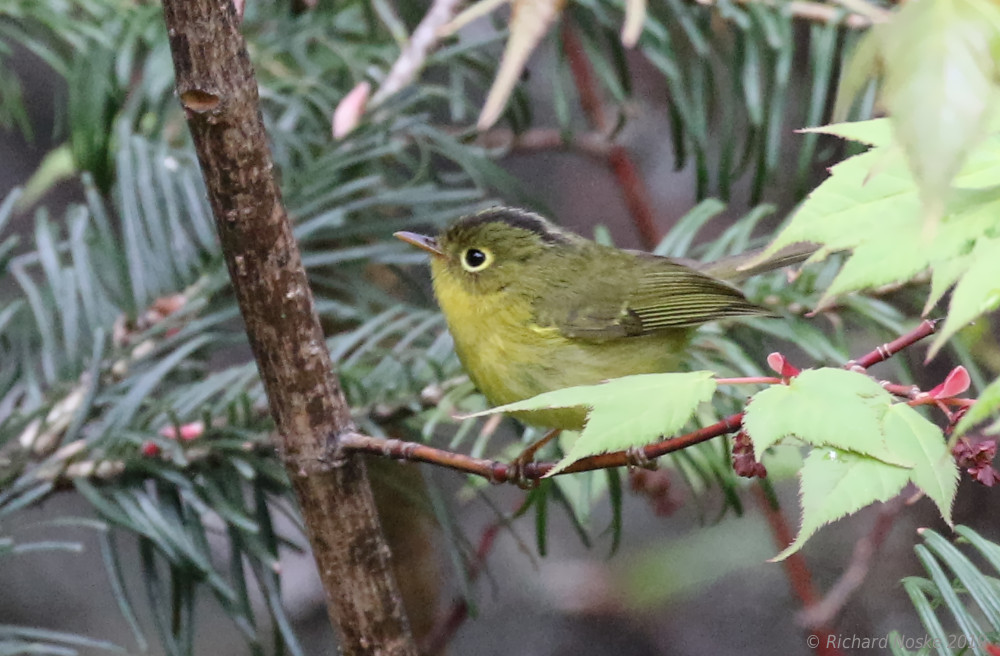Next morning we ascended towards the ‘heavens’, to Tharpaling Monastery…..on a previous visit I had visited late in the day so it was nice to arrive early. Climbing from the car-park to the temple was rather ‘strenuous’ (…it’s about 3600+ metres above sea-level!) and after short-while we spotted our first Himalayan Monal (Lophophorus impejanus) fly down from the mountain and begin calling. These birds are wild but feed on rice put out by the resident monks. Males usually arrive first and call down their mates when it appears safe to do so. Ebird list
From the monastery we made our way to Trongsa, with roadside stops near Yotongla, we found a great pair of Red-headed Bullfinch (Pyrrhula erythrocephala) several Great Parrotbill (Conostoma oemodium) a Green Shrike Babbler (Pteruthius xanthochlorus) and Rusty-flanked Treecreeper (Certhia nipalensis), Crested Goshawk (Accipiter trivirgatus) Yellow-billed Blue Magpie (Urocissa flavirostris) and Grey Bushchat (Saxicola ferreus) performed while we had lunch. Ebird List

After a night at the Yankhil Resort near Trongsa we headed south towards the border with India to Tingtibi. Much of the area is agricultural and cleared of forestry but it still can be an exciting journey, with different species. We came across species such as Crested Bunting (Emberiza lathami), Little Forktail (Enicurus scouleri), Lesser Cuckoo (Cuculus poliocephalus), Rufous Woodpecker (Micropternus brachyurus), Chestnut-tailed Starling (Sturnia malabarica) and another pair of Rufous-chinned Laughingthrush (Garrulax rufogularis)
Approaching the Zhemgang region, the area is more densely-forested and the birding becomes very exciting, ‘bird-waves’ can often occur with species passing-by rapidly, usually led by species such as drongos with scimitar-babblers, minivets, barbets, laughingthrushes, woodpeckers often seen racing by, frequently some get ‘missed’ by the birding-group who are concentrating on recording other species. Wedge-tailed Green Pigeons (Treron sphenurus), Coral-billed Scimitar-babblers (Pomatorhinus ferruginosus), Black Bulbuls (Hypsipetes leucocephalus), Crimson Sunbird (Aethopyga siparaja) and our third primate species, the Gee’s Golden Langur (Trachypithecus geei) were also noted. Ebird List
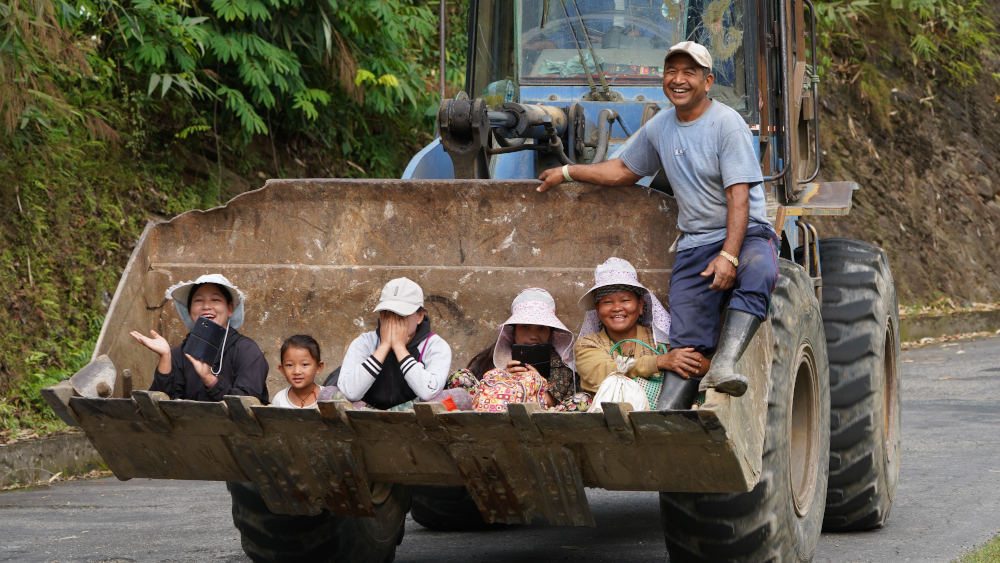
Tingtibi is a small town with a hotel that I’ve stayed in previously, the T-Wang Hotel is a basic place but very popular with Bhutanese people, the appeal of the area for birders is the wet lowland-forest and plentiful bamboo-stands, home for several very ‘localized’ species, such as White-hooded Babbler (Gampsorhynchus rufulus), Pale-headed Woodpecker (Gecinulus grantia) and Pale-billed Parrotbill (Chleuasicus atrosuperciliaris) Ebird List
It’s also a great area for hornbills and Rufous-necked (Aceros nipalensis) showed on most days.
A common mammal species here is the Golden Langur (Trachypithecus geei), however we only came across the goat-like Brown or Himalayan Goral (Naemorhedus goral) a couple of times on incredibly-steep mountain-slopes. Ebird List
We spent three days in the area looking for the ‘Critically Endangered’ White-bellied Heron (Ardea insignis) which had been seen nesting along one of the valleys, however one previously-occupied nest we visited was sadly found to be ‘abandoned’. One of the species that I had ‘heard-only’ on previous visits was the almost ‘mythical’ Blue-winged Laughingthrush (Trochalopteron squamatum) fortunately Norbu fixed this with excellent views of a pair. Ebird List
From Tingtibi we returned to Trongsa for another evening at the Yankhil Resort seeing more great birds en-route. Ebird List
The following-day we had an early start and headed west towards the Phobjihka Valley, leaving Trongsa the scenery was spectacular, ‘scary-roads’ on steep-sides, I’ve included this brief clip from my mobile to help ‘share’ the experience.
Stopping for lunch along this road, we were ‘surprised’ to find two ‘new’ woodpecker species, Crimson-breasted (Dryobates cathpharius) and Rufous-bellied (Dendrocopos hyperythrus), a nesting Ashy Drongo (Dicrurus leucophaeus) and a handsome male Plumbeous Redstart (Rhyacornis fuliginosus). The woodpecker was initially ID’d on it’s call and was probably an ‘immature’ as it looked quite different to others that I have seen on previous-trips. Ebird List
We spent one night at the Gakiling Hotel in the Phobjhika Valley, but the birding was a bit quiet compared to previous trips that I’ve made here. Ebird List
In the morning we made our way to one of my favourite birding places in Bhutan, the Old Pelela Road, at first the birding was fairly quiet, however it improved closer to the quarry where Norbu found a Scaly-breasted Cupwing (Pnoepyga albiventer) (…or as it was previously-known Scaly-breasted Wren-babbler) Unfortunately as we were ‘pushed’ for time we had little-time to really explore it properly. Ebird List
Our next stop was Punakha, and in the late-afternoon we tried in vain again to find a White-bellied Heron (Ardea insignis) at the Puna Tsang Chu (River), we did see River (Vanellus duvaucelii) and Red-wattled Lapwing (Vanellus indicus), and the very special Ibisbill (Ibidorhyncha struthersii)
In the morning we were up early for a fairly short drive to Jigme Dorji National Park, it was fairly overcast but the birding improved as we ‘ascended’ the mountain. There were several ‘skulkers’ that we tried to glimpse such as Black-tailed Crake (Zapornia bicolor) and Spotted Elachura (Elachura formosa) but surely the ‘hardest bird to see on earth’ must be the Slaty-bellied Tesia (Tesia olivea)….the pic underneath this is my best ‘shot’….hopefully one of the group improved on that! Ebird List
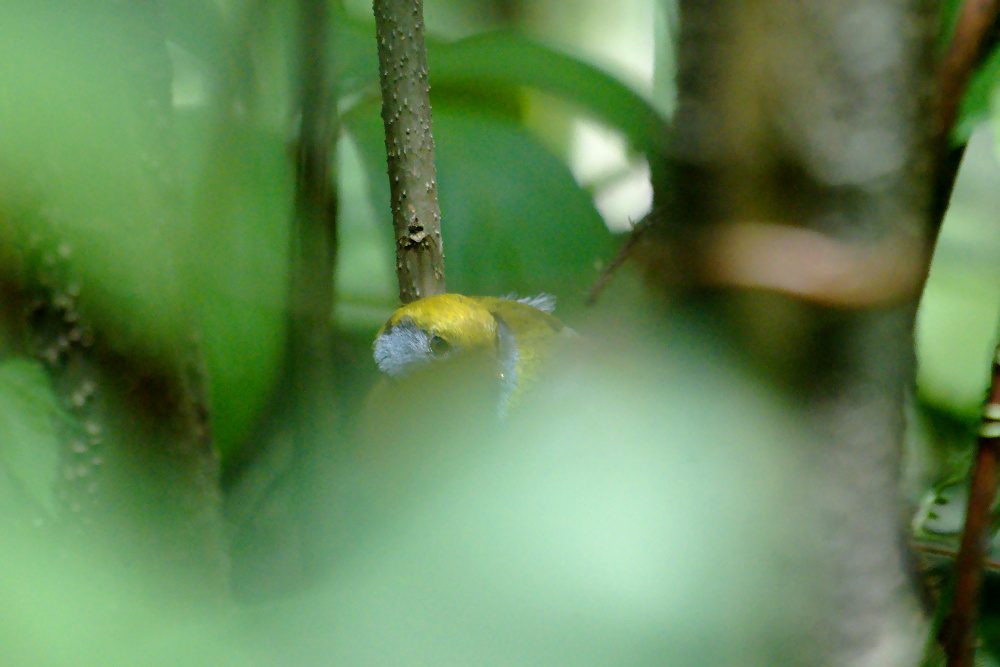
Again in the late-afternoon we tried the Puna Tsang Chu (river) for the heron but still no luck.
From Punakha we headed back towards the capital Thimphu stopping to bird in the Royal Botanic Gardens, things were very quiet but we found a flock of Brown Parrotbill (Cholornis unicolor) in the ‘sparse’ bamboo, along the walking trail we bumped into an old friend and guide Tshering Dorjee who immediately found a new species for the trip (…and a Bhutan ‘lifer’ for me) a Yellow-bellied Flowerpecker (Dicaeum melanozanthum) .We searched ‘in-vain’ for the usually resident Black-tailed Crake but fortunately were rewarded with another frequent visitor there, a Darjeeling Woodpecker (Dendrocopos darjellensis). From the gardens we went up to one of my favourite places in Bhutan, Dochula but the birding was rather quiet this time. Ebird List
After a night of luxury in Thimphu we took a walk around the sewage-works and found Ibisbill (Ibidorhyncha struthersii) with young.
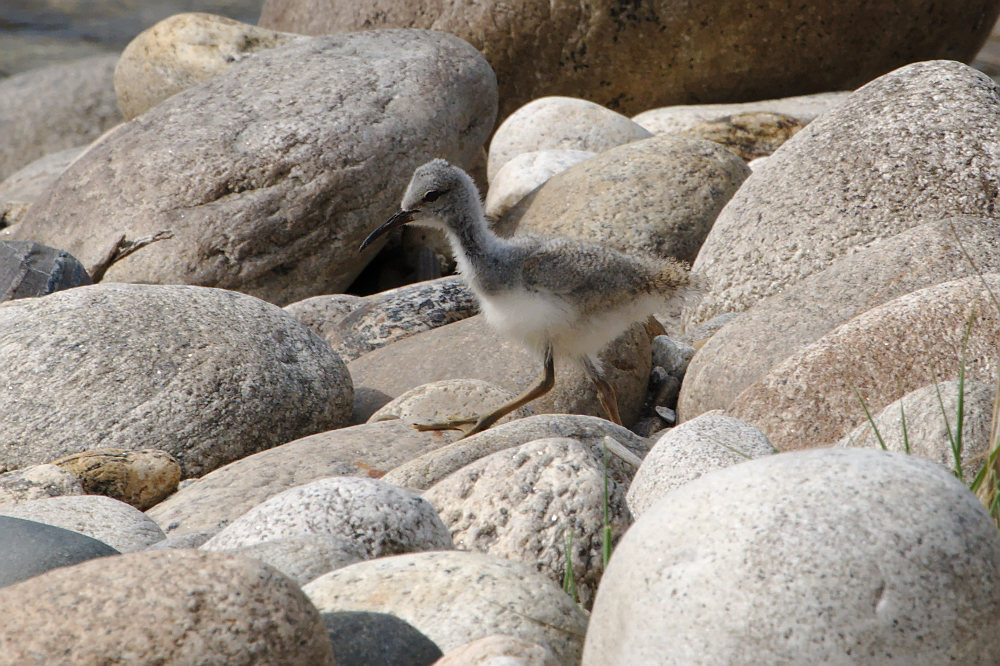
Our last stop was the Hotel Olathang at Paro, where we would leave from the International Airport in a couple of days. Most of the group elected to visit the Tiger’s Nest Monastery, probably Bhutan’s premier tourist attraction, however Nina, Giles and myself decided to ‘bird’ the forestry at the base. Our highlight was undoubtedly getting great-views of an Indian Blue Robin (Larvivora brunnea), an incredible ‘skulker’ that I’d struggled to see on my two previous visits to the country. I’ve ‘created’ a video-clip of the bird singing but it’s rather poor.
Faye, Richard and Linda, completed the ascent (….and returned in one piece) with a sense of accomplishment. Ebird List
After returning to Paro we continued birding along the river near the airport in search of Ibisbill (Ibidorhyncha struthersii). They were found easily with Brown Dipper (Cinclus pallasii) and River Lapwing (Vanellus duvaucelii) less than one kilometre from the main airport buildings.
In the hotel grounds we found a few interesting birds such as Blyth’s Leaf-warbler (Phylloscopus reguloides), White-collared Blackbird (Turdus albocinctus) and Grey-backed Shrike (Lanius tephronotus)
On the penultimate day we set-off early and headed up to another of my favourite places in Bhutan, the pass at Chelela, unfortunately this time the weather was very poor with low-visibilty and was so much less-rewarding from a birding point-of-view. However we did manage to see some of the regular species such as Blue-fronted Redstart (Phoenicurus frontalis), Whistler’s Warbler (Phylloscopus whistleri) Khalij Pheasant (Lophura leucomelanos) Greenish Warbler (Phylloscopus trochiloides) Olive-backed Pipit (Anthus hodgsoni) Himalayan White-browed Rosefinch (Carpodacus thura) but the highlight (for me) was a species which seems to have a very local distribution in the area at a lower-elevation, the Ultramarine Flycatcher (Ficedula superciliaris). Ebird list
So ended another trip to a beautiful country, I wish to thank all the participants, guides and especially the ‘support-team’, for all their efforts in making the trip such a success.
Please note: The list below is a summary of the entire trip, taken from Ebird, some of the observations (mostly from India) would not have been recorded by all the participants.
Date Range May 1, 2019 – May 31, 2019 Total Number of Species 343
Locations (26.93, 91.554) : (27.363, 91.034) : (27.388, 89.389) : (27.483, 89.36) : BT-Unnamed Road – 27.669×89.774 – Jun 8, 2017 06:11 : Brahmaputra Jungle Resort : Bridge north of Airport : Bumthang – Ura Highway, Mongar, BT (27.308, 91.165) : Dochula : Guwahati Waste Disposal : Hotel Olathang
- 27.429×89.4 – Jun 5, 2017 20:01 : Paro District (27.4815, 89.3602) : Pelela : Phobjikha Valley : Pobitora WLS : Sarpang – Gelephu – Trongsa Highway, BT (27.176, 90.657) : Sarpang – Gelephu – Trongsa Highway, Trongsa, BT (27.39, 90.53) : Sarpang – Gelephu – Trongsa Highway, Zhemgang, Zhemgang, BT (27.15, 90.688) : Sengor–camp and upper Lingmethan Rd (2700-3000m) : Shonkhar Chu Valley, Limithang Road. : TH-Bangkok-Lat Krabang-90 ถนน หลวงแพ่ง – 13.721×100.795 : Tharpaling Monastery : Tingtibi camp : Trashigang – Semtokha Highway, Ngatshang, Mongar, BT (27.298, 91.328) : Trongsa, BT (27.338, 90.599) : Unnamed Road, Jakar, Bumthang, BT (27.557, 90.745) : Unnamed Road, Punakha, BT (27.581, 89.855) : Unnamed Road, Samdrup Jongkhar, BT (26.93, 91.546) : Unnamed Road, Samdrup Jongkhar, BT (26.936, 91.553) : Unnamed Road, Zhemgang, Zhemgang, BT (27.141, 90.69) : Unnamed Road, Zhemgang, Zhemgang, BT (27.143, 90.691) : Ura Valley : Wangdue Phodrang – Trongsa Highway, Trongsa, BT (27.504, 90.494) : Yongkhola camp : Yotongla area
- Total Number of Checklists 47 May 1-5 May 6-10 May 11-15 May 16-20 May 21-25 May 26-31
Number of Species 83 137 166 146 102 —
Number of Individuals 270 475 712 569 284 —
Number of Checklists 3 10 14 10 10 — May 1-5 May 1-5 May 6-10 May 6-10 May 11-15 May 11-15 May 16-20 May 16-20 May 21-25 May 21-25 May 26-31 May 26-31
Species Name High Count Sample Size High Count Sample Size High Count Sample Size High Count Sample Size High Count Sample Size High Count Sample Size
Lesser Whistling-Duck – Dendrocygna javanica 14 1 — — — 3 1 —
Greylag Goose – Anser anser 1 1 — — — — —
Hill Partridge – Arborophila torqueola — — 1 1 — 1 1 —
Chestnut-breasted Partridge – Arborophila mandellii — — 1 1 — — —
Rufous-throated Partridge – Arborophila rufogularis — 2 1 — — — —
Blood Pheasant – Ithaginis cruentus — — 4 1 — 1 1 —
Himalayan Monal – Lophophorus impejanus — — 3 1 1 1 — —
Satyr Tragopan – Tragopan satyra — 5 1 6 2 — 1 1 —
Kalij Pheasant – Lophura leucomelanos — — — 1 1 8 1 —
Rock Dove – Columba livia 3 1 — — 32 3 — —
Snow Pigeon – Columba leuconota — — — 6 1 — —
Speckled Wood-Pigeon – Columba hodgsonii — 20 1 17 2 — 15 1 —
Oriental Turtle-Dove – Streptopelia orientalis — 1 1 4 7 2 3 8 3 —
Red Collared-Dove – Streptopelia tranquebarica 1 2 — — — 6 2 —
Spotted Dove – Streptopelia chinensis 1 1 2 2 4 3 2 5 — —
Barred Cuckoo-Dove – Macropygia unchall — 1 1 — 2 3 — —
Asian Emerald Dove – Chalcophaps indica 1 1 — — 1 2 — —
Zebra Dove – Geopelia striata 1 1 — — — 3 2 —
Pink-necked Green-Pigeon – Treron vernans 7 1 — — — 1 1 —
Pin-tailed Green-Pigeon – Treron apicauda — 3 1 — 1 1 — —
Wedge-tailed Green-Pigeon – Treron sphenurus — — 3 3 6 2 1 1 —
Mountain Imperial-Pigeon – Ducula badia — 2 2 — — — —
Greater Coucal – Centropus sinensis 1 1 — — — 1 1 —
Lesser Coucal – Centropus bengalensis 1 1 — — — — —
Green-billed Malkoha – Phaenicophaeus tristis — 1 1 — 1 1 — —
Chestnut-winged Cuckoo – Clamator coromandus — — 1 1 1 1 — —
Asian Koel – Eudynamys scolopaceus 2 3 1 1 — — 2 1 —
Plaintive Cuckoo – Cacomantis merulinus 1 1 — — 1 1 1 2 —
Grey-bellied Cuckoo – Cacomantis passerinus — 1 1 1 1 1 3 — —
Square-tailed Drongo-Cuckoo – Surniculus lugubris — 1 1 1 2 1 3 — —
Large Hawk-Cuckoo – Hierococcyx sparverioides — 1 4 1 4 2 5 2 2 —
Common Hawk-Cuckoo – Hierococcyx varius 1 1 — — — — —
Hodgson’s Hawk-Cuckoo – Hierococcyx nisicolor — 1 1 1 1 — — —
Lesser Cuckoo – Cuculus poliocephalus — 1 1 1 2 1 1 1 1 —
Indian Cuckoo – Cuculus micropterus 1 1 1 2 1 1 1 3 1 1 —
Himalayan Cuckoo – Cuculus saturatus — — 2 4 1 5 1 1 —
Common Cuckoo – Cuculus canorus — 1 1 4 6 1 3 1 2 —
Cuculus sp. – Cuculus sp. — — — 1 1 — —
Grey Nightjar – Caprimulgus jotaka — — — — 2 1 —
White-throated Needletail – Hirundapus caudacutus — — 31 4 7 1 — —
Himalayan Swiftlet – Aerodramus brevirostris — — 20 2 — — —
Germain’s Swiftlet – Aerodramus germani — — — — 1 1 —
Blyth’s Swift – Apus leuconyx — 2 1 14 5 5 1 — —
Pacific/Cook’s Swift – Apus pacificus/cooki — — — — 1 1 —
swift sp. – Apodidae sp. — — 1 1 — — —
White-breasted Waterhen – Amaurornis phoenicurus 3 1 — — — — —
Ruddy-breasted Crake – Zapornia fusca — — 2 1 — — —
Black-tailed Crake – Zapornia bicolor — — 1 1 2 1 — —
Ibisbill – Ibidorhyncha struthersii — — — — 5 1 —
River Lapwing – Vanellus duvaucelii — — — 1 1 — —
Red-wattled Lapwing – Vanellus indicus 3 2 — — — 1 2 —
Bronze-winged Jacana – Metopidius indicus 1 1 — — — — —
Oriental Pratincole – Glareola maldivarum — — — — 2 1 —
Asian Openbill – Anastomus oscitans 7 2 — — — 5 2 —
Black-necked Stork – Ephippiorhynchus asiaticus 3 1 — — — — —
Lesser Adjutant – Leptoptilos javanicus 2 1 — — — — —
Greater Adjutant – Leptoptilos dubius — 120 1 — — — —
Painted Stork – Mycteria leucocephala 1 1 — — — — —
Oriental Darter – Anhinga melanogaster 12 1 — — — — —
Little Cormorant – Microcarbo niger 5 2 — — — — —
Indian Cormorant – Phalacrocorax fuscicollis — — — — 7 1 —
Spot-billed Pelican – Pelecanus philippensis 2 1 — — — — —
Yellow Bittern – Ixobrychus sinensis — — — — 1 1 —
Grey Heron – Ardea cinerea 1 1 — — — — —
Purple Heron – Ardea purpurea 1 1 — — — 1 1 —
Great Egret – Ardea alba 7 2 1 1 — — 1 1 —
Intermediate Egret – Ardea intermedia 3 1 — — — — —
Little Egret – Egretta garzetta 3 2 — — — — —
Cattle Egret – Bubulcus ibis 7 2 12 2 — 1 1 — —
Indian Pond-Heron – Ardeola grayii 3 1 — — — — —
Javan Pond-Heron – Ardeola speciosa — — — — 1 2 —
Black-crowned Night-Heron – Nycticorax nycticorax 4 1 — — — 4 1 —
Glossy Ibis – Plegadis falcinellus 8 1 — — — — —
Black-winged Kite – Elanus caeruleus 1 1 — — — — —
Oriental Honey-buzzard – Pernis ptilorhynchus — — 2 1 — — —
Himalayan Griffon – Gyps himalayensis — — 4 1 6 1 — —
Crested Serpent-Eagle – Spilornis cheela 5 1 2 1 1 2 1 3 — —
Mountain Hawk-Eagle – Nisaetus nipalensis — 3 2 — 2 3 — —
Rufous-bellied Eagle – Lophotriorchis kienerii — 1 1 — — — —
Black Eagle – Ictinaetus malaiensis — 1 1 2 2 1 1 — —
Crested Goshawk – Accipiter trivirgatus 1 1 1 1 1 1 2 1 — —
Black Kite – Milvus migrans — 5 1 — — — —
Grey-headed Fish-Eagle – Haliaeetus ichthyaetus 1 1 — — — — —
Himalayan Buzzard – Buteo refectus — — — 1 1 1 1 —
Collared Scops-Owl – Otus lettia — — — 1 1 — —
Collared Owlet – Glaucidium brodiei — 1 2 1 1 — — —
Asian Barred Owlet – Glaucidium cuculoides — — — 1 2 — —
Brown Wood-Owl – Strix leptogrammica — 1 1 — — — —
Himalayan Owl – Strix nivicolum — — 2 1 — — —
Red-headed Trogon – Harpactes erythrocephalus — 1 2 — 1 1 — —
Ward’s Trogon – Harpactes wardi — 1 1 — — — —
Eurasian Hoopoe – Upupa epops 1 1 — 4 2 1 1 — —
Great Hornbill – Buceros bicornis — — 2 1 1 1 — —
Rufous-necked Hornbill – Aceros nipalensis — 2 5 1 2 2 2 — —
White-throated Kingfisher – Halcyon smyrnensis 2 2 1 1 — 1 1 — —
Crested Kingfisher – Megaceryle lugubris — — — 3 1 — —
Blue-bearded Bee-eater – Nyctyornis athertoni — — 3 2 2 2 — —
Green Bee-eater – Merops orientalis 2 1 — — — — —
Indochinese Roller – Coracias affinis 2 1 — — — — —
Coppersmith Barbet – Psilopogon haemacephalus 1 2 — — — 2 1 —
Great Barbet – Psilopogon virens — 3 4 1 5 1 6 — —
Lineated Barbet – Psilopogon lineatus 1 1 1 1 — — — —
Golden-throated Barbet – Psilopogon franklinii — 2 2 1 2 2 3 — —
Blue-throated Barbet – Psilopogon asiaticus — 1 2 2 2 1 3 — —
White-browed Piculet – Sasia ochracea — 1 1 — 2 1 — —
Grey-capped Woodpecker – Yungipicus canicapillus — — — 2 1 — —
Rufous-bellied Woodpecker – Dendrocopos hyperythrus — — — 1 1 — —
Darjeeling Woodpecker – Dendrocopos darjellensis — — — — 2 1 —
Crimson-breasted Woodpecker – Dryobates cathpharius — — — 1 1 — —
Bay Woodpecker – Blythipicus pyrrhotis — — 2 1 1 1 — —
Rufous Woodpecker – Micropternus brachyurus 5 1 — 1 1 1 3 — —
Pale-headed Woodpecker – Gecinulus grantia — — — 2 1 — —
Black-rumped Flameback – Dinopium benghalense 1 1 — — — — —
Lesser Yellownape – Picus chlorolophus — — — 1 1 — —
Grey-headed Woodpecker – Picus canus — 2 3 — 1 1 — —
Greater Yellownape – Chrysophlegma flavinucha — 2 2 — 2 1 — —
Amur Falcon – Falco amurensis — 2 1 — — — —
Oriental Hobby – Falco severus — 1 1 — — — —
Rose-ringed Parakeet – Psittacula krameri 6 1 1 1 — — — —
Long-tailed Broadbill – Psarisomus dalhousiae — 2 1 1 1 — — —
Grey-chinned Minivet – Pericrocotus solaris — 3 1 2 1 — — —
Short-billed Minivet – Pericrocotus brevirostris — — 1 1 — — —
Long-tailed Minivet – Pericrocotus ethologus — — 2 1 1 1 — —
Scarlet Minivet – Pericrocotus speciosus 2 1 4 1 2 3 25 2 — —
minivet sp. – Pericrocotus sp. — — 2 1 — — —
Black-winged Cuckooshrike – Lalage melaschistos — 1 1 — 1 2 — —
Green Shrike-Babbler – Pteruthius xanthochlorus — — 1 1 — — —
Black-hooded Oriole – Oriolus xanthornus 2 1 — — — — —
Maroon Oriole – Oriolus traillii — 1 1 3 1 1 4 1 1 —
Ashy Woodswallow – Artamus fuscus 4 1 — 2 1 2 3 — —
Large Woodshrike – Tephrodornis virgatus — 3 1 — — — —
Common Iora – Aegithina tiphia 1 1 2 1 — — 1 1 —
Malaysian Pied-Fantail – Rhipidura javanica 1 1 — — — 1 1 —
White-throated Fantail – Rhipidura albicollis — — 2 1 1 1 — —
Black Drongo – Dicrurus macrocercus 1 1 — — — 1 1 —
Ashy Drongo – Dicrurus leucophaeus 1 1 3 4 4 4 4 3 4 2 —
Bronzed Drongo – Dicrurus aeneus — 1 1 1 1 3 2 — —
Lesser Racket-tailed Drongo – Dicrurus remifer — 1 1 1 1 — — —
Hair-crested Drongo – Dicrurus hottentottus 1 1 — — — — —
Greater Racket-tailed Drongo – Dicrurus paradiseus 2 1 — — — — —
Black-naped Monarch – Hypothymis azurea — 3 1 — — — —
Brown Shrike – Lanius cristatus — 1 1 — — — —
Long-tailed Shrike – Lanius schach — — 2 1 — — —
Grey-backed Shrike – Lanius tephronotus — 1 1 3 3 1 3 2 3 —
Eurasian Jay – Garrulus glandarius — — — — 1 3 —
Yellow-billed Blue-Magpie – Urocissa flavirostris — 1 1 3 2 5 1 1 3 —
Rufous Treepie – Dendrocitta vagabunda 2 1 — — — — —
Grey Treepie – Dendrocitta formosae — 3 3 4 2 2 4 — —
Black-rumped Magpie – Pica bottanensis — — 5 1 — — —
Eurasian Nutcracker – Nucifraga caryocatactes — — 3 4 1 2 1 3 —
Red-billed Chough – Pyrrhocorax pyrrhocorax — — 3 3 2 1 1 1 —
Large-billed Crow – Corvus macrorhynchos 1 1 4 2 16 6 4 3 2 2 —
Yellow-bellied Fairy-Fantail – Chelidorhynx hypoxanthus — — 1 1 2 1 — —
Grey-headed Canary-Flycatcher – Culicicapa ceylonensis — 1 2 2 2 3 1 — —
Yellow-browed Tit – Sylviparus modestus — — — 1 1 — —
Sultan Tit – Melanochlora sultanea — — — 2 1 — —
Coal Tit – Periparus ater — — 1 2 — 1 1 —
Rufous-vented Tit – Periparus rubidiventris — — 3 1 2 1 1 1 —
Grey-crested Tit – Lophophanes dichrous — — 1 1 — 1 1 —
Green-backed Tit – Parus monticolus — 2 2 2 5 1 2 2 1 —
Cinereous Tit – Parus cinereus 1 1 — — — — —
Yellow-cheeked Tit – Machlolophus spilonotus — 5 2 2 1 1 1 — —
Oriental Skylark – Alauda gulgula — — — 2 1 — —
Common Tailorbird – Orthotomus sutorius 1 2 1 1 — — — —
Dark-necked Tailorbird – Orthotomus atrogularis 1 1 — — — — —
Striated Prinia – Prinia crinigera — 1 1 1 3 2 2 — —
Black-throated Prinia – Prinia atrogularis — — 1 1 — — —
Zitting Cisticola – Cisticola juncidis 1 1 — — — — —
Striated Grassbird – Megalurus palustris 2 1 — — — — —
Scaly-breasted Cupwing – Pnoepyga albiventer — — — 1 1 — —
Pygmy Cupwing – Pnoepyga pusilla — 1 1 1 1 — — —
Bank Swallow – Riparia riparia 10 1 — — — — —
Bank Swallow/Pale Sand Martin – Riparia riparia/diluta 12 1 — — — — —
Asian House-Martin – Delichon dasypus — — 7 1 — — —
Nepal House-Martin – Delichon nipalense — 4 1 — 100 1 — —
house-martin sp. – Delichon sp. — — 10 1 — — —
swallow sp. – Hirundinidae sp. — — — 2 1 — —
Black-crested Bulbul – Rubigula flaviventris 2 1 1 1 — 1 1 — —
Striated Bulbul – Pycnonotus striatus — 2 2 2 2 — — —
Red-vented Bulbul – Pycnonotus cafer 4 2 12 3 16 4 5 5 — —
Himalayan Bulbul – Pycnonotus leucogenys — — 1 1 — — —
Yellow-vented Bulbul – Pycnonotus goiavier 1 1 — — — 1 1 —
Streak-eared Bulbul – Pycnonotus conradi 3 1 — — — — —
White-throated Bulbul – Alophoixus flaveolus — — — 4 2 — —
Black Bulbul – Hypsipetes leucocephalus — 6 2 5 4 3 2 2 3 —
Ashy Bulbul – Hemixos flavala — — 1 1 2 2 — —
Mountain Bulbul – Ixos mcclellandii — — 3 3 — — —
Ashy-throated Warbler – Phylloscopus maculipennis — 1 1 1 1 — — —
Buff-barred Warbler – Phylloscopus pulcher — — 1 1 — 1 1 —
Lemon-rumped Warbler – Phylloscopus chloronotus — — 1 2 — — —
Tickell’s Leaf Warbler – Phylloscopus affinis — 1 1 1 1 — — —
Grey-cheeked Warbler – Phylloscopus poliogenys — 2 1 2 1 — — —
Whistler’s Warbler – Phylloscopus whistleri — 1 1 2 2 — 1 1 —
Greenish Warbler – Phylloscopus trochiloides — — 1 1 — 4 1 —
Large-billed Leaf Warbler – Phylloscopus magnirostris — — 1 2 1 1 1 2 —
Chestnut-crowned Warbler – Phylloscopus castaniceps — 2 2 — — — —
Yellow-vented Warbler – Phylloscopus cantator — — — 3 1 — —
Blyth’s Leaf Warbler – Phylloscopus reguloides — 1 2 2 2 1 2 2 3 —
Grey-hooded Warbler – Phylloscopus xanthoschistos — 1 1 1 2 2 2 — —
Phylloscopus sp. – Phylloscopus sp. — — — — 2 1 —
Slaty-bellied Tesia – Tesia olivea — — — 1 1 — —
Grey-sided Bush Warbler – Cettia brunnifrons — — — 3 1 — —
Chestnut-headed Tesia – Cettia castaneocoronata — — — — 1 2 —
Yellow-bellied Warbler – Abroscopus superciliaris — — — 1 1 — —
Rufous-faced Warbler – Abroscopus albogularis — — — 2 1 — —
Black-faced Warbler – Abroscopus schisticeps — 1 1 — — — —
Mountain Tailorbird – Phyllergates cucullatus — 2 1 — — — —
Brownish-flanked Bush Warbler – Horornis fortipes — — — 2 1 — —
Hume’s Bush Warbler – Horornis brunnescens — — 1 1 — — —
Black-throated Tit – Aegithalos concinnus — 2 1 — — — —
Black-browed Tit – Aegithalos iouschistos — — 1 1 — 3 2 —
Golden-breasted Fulvetta – Lioparus chrysotis — — 2 1 — — —
White-browed Fulvetta – Fulvetta vinipectus — — 2 1 3 1 1 1 —
Great Parrotbill – Conostoma aemodium — — 2 1 — — —
Brown Parrotbill – Cholornis unicolor — — — — 2 1 —
White-breasted Parrotbill – Psittiparus ruficeps — 1 1 8 1 1 1 — —
Pale-billed Parrotbill – Chleuasicus atrosuperciliaris — — — 1 1 — —
Striated Yuhina – Yuhina castaniceps — — — 3 3 — —
White-naped Yuhina – Yuhina bakeri — 4 1 — — — —
Whiskered Yuhina – Yuhina flavicollis — 2 1 7 1 2 1 — —
Stripe-throated Yuhina – Yuhina gularis — — 5 3 — 3 1 —
Rufous-vented Yuhina – Yuhina occipitalis — — — 1 1 1 1 —
Black-chinned Yuhina – Yuhina nigrimenta — — 7 2 3 1 — —
Indian White-eye – Zosterops palpebrosus 2 1 2 2 6 2 — — —
Pin-striped Tit-Babbler – Mixornis gularis 1 1 1 1 — — — —
Golden Babbler – Cyanoderma chrysaeum — — 3 1 — — —
Rufous-capped Babbler – Cyanoderma ruficeps — 2 1 2 1 — — —
Rufous-throated Wren-Babbler – Spelaeornis caudatus — — 1 1 1 1 — —
Coral-billed Scimitar-Babbler – Pomatorhinus ferruginosus — — 3 2 — — —
Slender-billed Scimitar-Babbler – Pomatorhinus superciliaris — — 4 1 — — —
Streak-breasted Scimitar-Babbler – Pomatorhinus ruficollis — 1 1 — 1 1 — —
Rusty-cheeked Scimitar-Babbler – Megapomatorhinus erythrogenys — — 5 1 2 3 — —
Grey-throated Babbler – Stachyris nigriceps — 1 1 1 1 1 1 — —
White-hooded Babbler – Gampsorhynchus rufulus — — — 3 1 — —
Yellow-throated Fulvetta – Schoeniparus cinereus — 3 1 1 1 — — —
Rufous-winged Fulvetta – Schoeniparus castaneceps — — — — 2 1 —
Long-billed Wren-Babbler – Napothera malacoptila — 1 1 — — — —
Nepal Fulvetta – Alcippe nipalensis — 1 1 1 1 — — —
Striated Laughingthrush – Grammatoptila striata — 2 2 2 3 1 1 — —
Himalayan Cutia – Cutia nipalensis — 2 1 2 1 — — —
Jungle Babbler – Turdoides striata 5 1 — — — — —
White-crested Laughingthrush – Garrulax leucolophus — — 8 3 1 1 — —
Lesser Necklaced Laughingthrush – Garrulax monileger — — — 3 2 — —
Rufous-chinned Laughingthrush – Ianthocincla rufogularis — 1 1 1 1 — — —
Spotted Laughingthrush – Ianthocincla ocellata — — — — 3 1 —
White-throated Laughingthrush – Ianthocincla albogularis — 3 2 7 3 1 1 6 3 —
Rufous-necked Laughingthrush – Ianthocincla ruficollis — 3 1 3 3 2 2 — —
Grey-sided Laughingthrush – Ianthocincla caerulata — 2 1 — — 2 1 —
Bhutan Laughingthrush – Trochalopteron imbricatum — 1 2 — 2 1 — —
Blue-winged Laughingthrush – Trochalopteron squamatum — 2 2 1 1 — — —
Black-faced Laughingthrush – Trochalopteron affine — — 1 2 4 1 1 1 —
Chestnut-crowned Laughingthrush – Trochalopteron erythrocephalum — — — 2 1 4 1 —
Rufous Sibia – Heterophasia capistrata — — 1 2 5 2 4 1 —
Long-tailed Sibia – Heterophasia picaoides — 1 1 — — — —
Silver-eared Mesia – Leiothrix argentauris — 4 1 — — — —
Red-billed Leiothrix – Leiothrix lutea — — — 1 1 1 2 —
Red-tailed Minla – Minla ignotincta — — 1 1 — — —
Red-faced Liocichla – Liocichla phoenicea — — 1 1 — — —
Hoary-throated Barwing – Actinodura nipalensis — — 3 1 2 1 — —
Rusty-fronted Barwing – Actinodura egertoni — 3 2 5 2 — — —
Blue-winged Minla – Actinodura cyanouroptera — 2 1 1 1 — — —
Chestnut-tailed Minla – Actinodura strigula — 7 1 — — 2 1 —
Chestnut-bellied Nuthatch – Sitta cinnamoventris — 1 1 1 1 1 2 — —
White-tailed Nuthatch – Sitta himalayensis — 1 2 — — — —
Beautiful Nuthatch – Sitta formosa — 2 2 — — — —
Hodgson’s Treecreeper – Certhia hodgsoni — — — — 1 1 —
Rusty-flanked Treecreeper – Certhia nipalensis — — 1 1 — — —
Sikkim Treecreeper – Certhia discolor — 2 1 — — — —
Spotted Elachura – Elachura formosa — 1 1 1 1 1 1 — —
Brown Dipper – Cinclus pallasii — — — — 1 1 —
Common Hill Myna – Gracula religiosa — 2 1 — — — —
Asian Pied Starling – Gracupica contra 2 1 — — — 2 1 —
Chestnut-tailed Starling – Sturnia malabarica 5 1 — 2 1 2 2 — —
Common Myna – Acridotheres tristis 4 3 4 1 1 1 3 2 — —
Jungle Myna – Acridotheres fuscus 2 1 — — — — —
Great Myna – Acridotheres grandis 2 1 — — — 2 2 —
Scaly Thrush – Zoothera dauma — — 1 2 — — —
Grey-winged Blackbird – Turdus boulboul — 1 1 — 1 1 1 1 —
White-collared Blackbird – Turdus albocinctus — — — 1 2 1 3 —
Dark-sided Flycatcher – Muscicapa sibirica — — 1 2 2 1 — —
Ferruginous Flycatcher – Muscicapa ferruginea — 1 1 — — — —
Oriental Magpie-Robin – Copsychus saularis 2 3 3 1 2 3 2 2 2 1 —
White-rumped Shama – Copsychus malabaricus — 1 1 — — — —
White-gorgeted Flycatcher – Anthipes monileger — 1 1 — — — —
Pale Blue Flycatcher – Cyornis unicolor — — — 1 1 — —
Blue-throated Flycatcher – Cyornis rubeculoides — 1 1 — 2 1 — —
Large Niltava – Niltava grandis — — 2 1 — 1 1 —
Small Niltava – Niltava macgrigoriae — 1 1 2 1 3 1 — —
Verditer Flycatcher – Eumyias thalassinus — 3 4 7 3 5 3 — —
Lesser Shortwing – Brachypteryx leucophris — 1 1 1 1 — — —
Himalayan Shortwing – Brachypteryx cruralis — — 1 1 1 1 — —
Indian Blue Robin – Larvivora brunnea — — — — 1 2 —
Blue Whistling-Thrush – Myophonus caeruleus — 1 1 3 8 2 3 2 3 —
Little Forktail – Enicurus scouleri — — 2 1 — — —
Spotted Forktail – Enicurus maculatus — — 2 1 — — —
Slaty-backed Forktail – Enicurus schistaceus — — — 1 2 — —
Himalayan Bluetail – Tarsiger rufilatus — — 1 1 — 2 1 —
Rufous-breasted Bush-Robin – Tarsiger hyperythrus — — 1 1 — — —
White-browed Bush-Robin – Tarsiger indicus — — 1 1 — — —
Rufous-gorgeted Flycatcher – Ficedula strophiata — — 4 1 — — —
Ultramarine Flycatcher – Ficedula superciliaris — — — — 3 1 —
Blue-fronted Redstart – Phoenicurus frontalis — — 1 1 — 5 1 —
Plumbeous Redstart – Phoenicurus fuliginosus — — 1 2 2 2 2 1 —
White-capped Redstart – Phoenicurus leucocephalus — 2 1 2 1 — — —
Chestnut-bellied Rock-Thrush – Monticola rufiventris — — 1 2 1 2 — —
Blue-capped Rock-Thrush – Monticola cinclorhyncha — 1 1 2 4 1 4 — —
Blue Rock-Thrush – Monticola solitarius — 1 1 — — — —
Grey Bushchat – Saxicola ferreus — 1 1 3 5 2 1 1 1 —
Yellow-bellied Flowerpecker – Dicaeum melanozanthum — — — — 1 1 —
Pale-billed Flowerpecker – Dicaeum erythrorhynchos — — — 1 1 — —
Plain Flowerpecker – Dicaeum minullum — 2 1 — — — —
Fire-breasted Flowerpecker – Dicaeum ignipectus — 1 2 1 4 1 1 — —
Scarlet-backed Flowerpecker – Dicaeum cruentatum 1 1 1 1 — — 1 1 —
Brown-throated Sunbird – Anthreptes malacensis — — — — 1 1 —
Purple Sunbird – Cinnyris asiaticus 1 1 — — — — —
Fire-tailed Sunbird – Aethopyga ignicauda — — 7 1 — — —
Black-throated Sunbird – Aethopyga saturata — 1 1 1 1 2 1 — —
Mrs. Gould’s Sunbird – Aethopyga gouldiae — — 1 2 — — —
Green-tailed Sunbird – Aethopyga nipalensis — — 1 5 1 1 — —
Crimson Sunbird – Aethopyga siparaja — 2 2 1 1 1 2 — —
Streaked Spiderhunter – Arachnothera magna — 1 1 1 2 — — —
Orange-bellied Leafbird – Chloropsis hardwickii — 2 2 2 3 2 2 — —
Baya Weaver – Ploceus philippinus 6 1 — — — — —
White-rumped Munia – Lonchura striata — 3 1 — — — —
Scaly-breasted Munia – Lonchura punctulata — — 1 1 — 6 1 —
Rufous-breasted Accentor – Prunella strophiata — — — — 2 1 —
House Sparrow – Passer domesticus 5 1 — — — — —
Russet Sparrow – Passer cinnamomeus — 1 1 3 5 1 1 9 1 —
Eurasian Tree Sparrow – Passer montanus 2 1 — 4 4 3 4 4 2 —
Grey Wagtail – Motacilla cinerea — — — 1 1 — —
White Wagtail – Motacilla alba — — 1 1 — 1 1 —
Paddyfield Pipit – Anthus rufulus 2 1 — — — — —
Rosy Pipit – Anthus roseatus — — 1 1 — — —
Olive-backed Pipit – Anthus hodgsoni — — 5 1 1 1 2 1 —
Collared Grosbeak – Mycerobas affinis — — — — 3 1 —
White-winged Grosbeak – Mycerobas carnipes — — — — 5 1 —
Common Rosefinch – Carpodacus erythrinus — 7 1 2 1 — — —
Scarlet Finch – Carpodacus sipahi — 3 2 — — 1 1 —
Himalayan White-browed Rosefinch – Carpodacus thura — — — — 4 1 —
Red-headed Bullfinch – Pyrrhula erythrocephala — — 2 1 — — —
Grey-headed Bullfinch – Pyrrhula erythaca — — — — 2 1 —
Yellow-breasted Greenfinch – Chloris spinoides — 7 1 5 1 — — —
Crested Bunting – Emberiza lathami — — 1 1 — — —
